

Tr~velodge
Combining Culture and Affluence

When you visit the land of adventure, make sure your accommodation facilities meet your expectations.
Whether your stay is for business or leisure, at Travelodge we set the standard in dining and accommodation.
Paradise is published bi-monthly by Morauta & Associates
PO Box 1267
Port Moresby 121
Papua New Guinea
Tel: (675) 3217986
Fax: (675)3214375
Pa rad ise Magazine
55 Cassowary Driv e Burl e igh Waters Qld 4220
Australia
Tel/Fax: (6 1) 7 55 200101
Publisher: Sir Mekere Morauta
Editor: Roslyn Morauta
Production:Dianne Mclnnes
Editorial Board Members:
Craig Templeman (A ir Niugini) Katherine Lepani
Contact the Port Moresby office for:
Advertising: La'a Aukopi
Subscriptions: Marie Manumanua
Annual subscription rates for six issues including postage are: In Papua New Guinea - K30 Australia - K60 R est of the world - US$50
Printed by: Pac-Rim Printing
Articles express the opinion of the a u thors and not necessari ly th at of Air N iu gini or Morauta & Assoc iates.
Editoria l contributions should be accompanied by return postage and wi ll be handled with reasonable care. The publisher, however, assu mes no responsibility for the safety of photographs, artwork or manuscripts.
3 DEVONSHIRE TEAS
Tari St y le
7 GAME FISHING ADVENTURE
Madang's
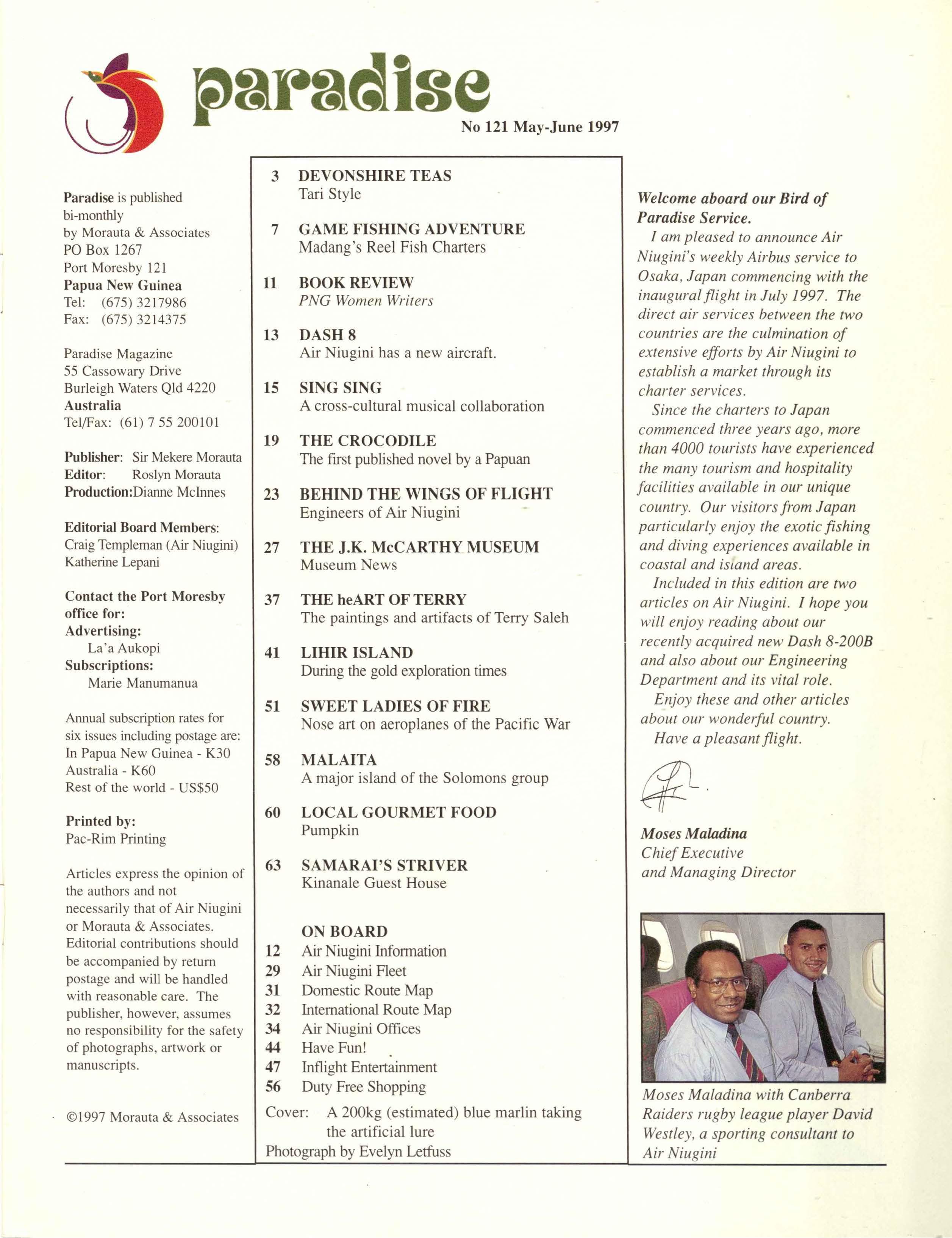
The first publi shed novel by a Papuan
37 THE heART OF TERRY
The paintings and artifacts of Terry S ale h 41 LIHIR ISLAND
Durin g the go ld exploration times 51 SWEET LADIES OF FIRE
Nose art on aeroplanes of the Pacific War
A major island of the Solomons group
Kin a n a le Guest Hou se
56 Du ty Free Shopping
Cover: A 200kg (estimated) blue marlin taking the artificial lure
Photograph by Evelyn Letfuss
Welcome aboard our Bird of Paradise Service.
I am pleased to announce Air Niugini's weekly Airbus service to Osaka, Japan commencing wit h the inaugural flight in July 199 7 The direct air services between the two countries are the culmination of extensive efforts by Air Niugini to establish a market through its charter services.
Since the charters to Japan commenced three yea rs ago, more than 4000 tourists have experienced the many tourism and hospitality facilities avai labl e in our unique country. Our visitors from Japan particularly enjoy the exotic fishing and diving experiences available in coastal and istand a reas.
I ncluded in this edition are two articles on Air Niug i ni. I hope you will enjoy reading about our recently acquired new Da sh 8-200B and also about our Engineering D epartment and its vital role.
Enjoy these and ot her articles about our wonderfu l country.
H ave a pleasant flight.
Moses Maladina Chief Executive and Managing D irector
Moses Maladina with Canberra
R aiders rugby league player D avid Westley, a sporting consultant to Air Niugini

Whether you're travelling around the globe or across the nation, Air Niugini takes care of business with the best international connections, and the largest network of regular services throughout Papua New Guinea.
To find out how we're taking care of business, call Air Niugini or our nearest representative now.
If you're travelling on business, why not stay and see more of our wonderful country.
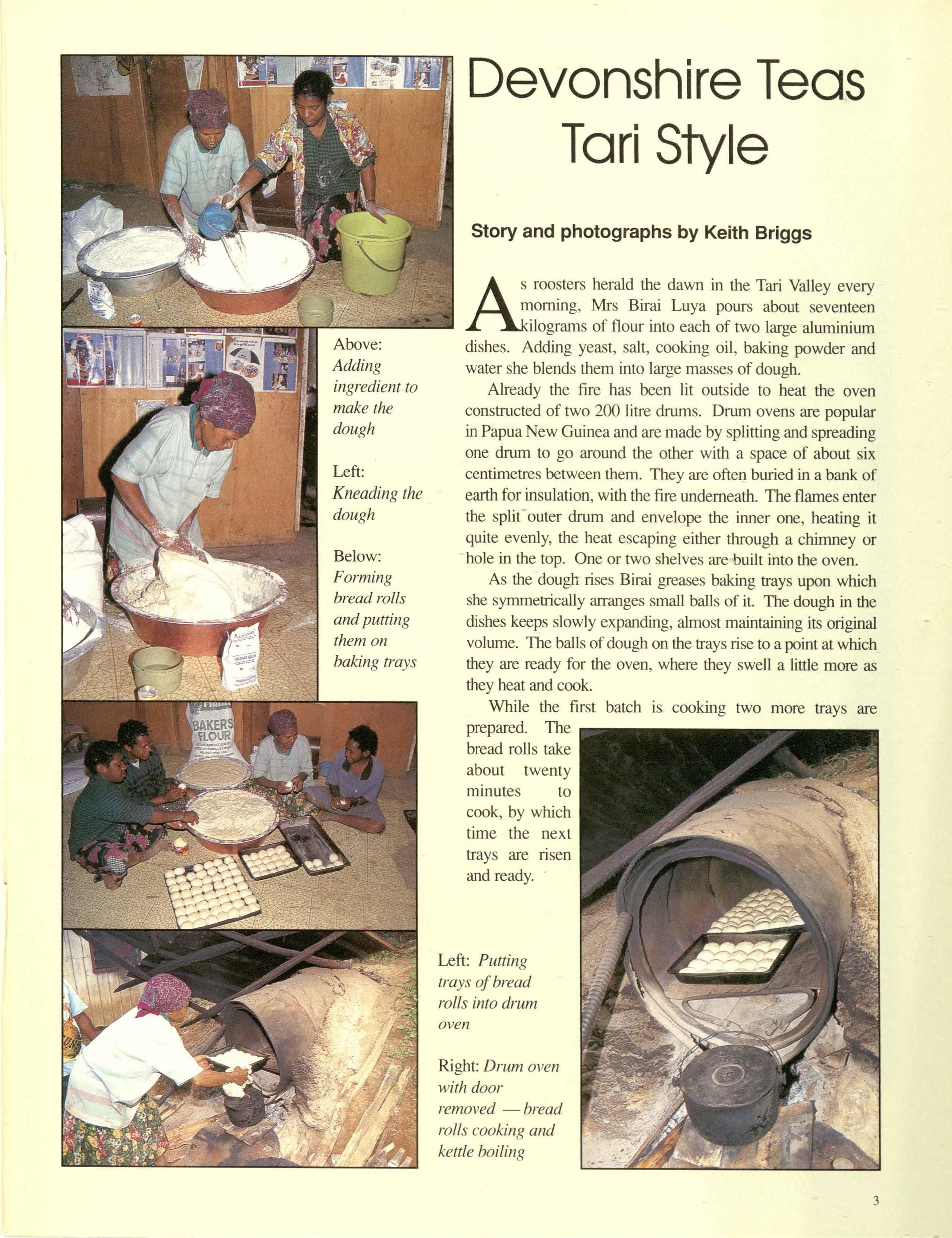
Above: Adding ingredient to make the dough
Left : Kneading the dough
B elow: Forming bread rolls and putting them on baking trays
Devonshire Teas Tari Style
Story and photog raphs by Ke ith Briggs
roosters herald the dawn in the Tari Valley every orning, Mrs Birai Luya pours about seventeen lograms of flour into each of two large aluminium dishes . Adding yeast, salt, cooking oil, baking powder and water she blends them into large masses of dough.
Already the fire has been lit outside to heat the oven constructed of two 200 litre drums. Drum ovens are popular in Papua New Guinea and are made by splitting and spreading one drum to go around the other with a space of about six centimetres between them. They are often buried in a bank of earth for insulation, with the fire underneath. The flames enter the split outer drum and envelope the inner one, heating it quite evenly, the heat escaping either through a chimney or hole in the top. One or two shelves are built into the oven.
As the dough rises Birai greases baking trays upon which she symmetrically arranges small balls of it. The dough in the dishes keeps slowly expanding, almost maintaining its original volume. The balls of dough on the trays rise to a point at whic h they are ready for the oven, where they swell a little more as they heat and cook.
While the first batch is cooking two more trays are prepared. The bread rolls take about twenty minutes to cook, by which time the next trays are risen and ready. •
Left: Putting trays of bread rolls into drum oven
Right: Drum oven with door removed - bread rolls cooking and kettle boiling
Above: Girls making coffee and serving 'Devonshire Teas' Right: Bedecked Huli men drop in for afternoon tea while returning from a compensation payment. Below: Luya's neat and tidy store where hot rolls and coffee are served.
A kettle is boiled on part of the fire at the front of the oven. Newly cooked rolls are taken into the family owned shop and covered with a cloth. The kettle is canied back and f01th as Birai's daughters and nieces begin a busy day of serving cups of coffee with rolls to the customers drawn by the famous aroma of fresh bread and coffee.
Black coffee is ten toea, with the price rising slightly for milk and s ugar if required. Good sized mugs are thirty toea. Where else would you get a mug of coffee and a fresh bread roll for forty toea (or thirty US cents)?
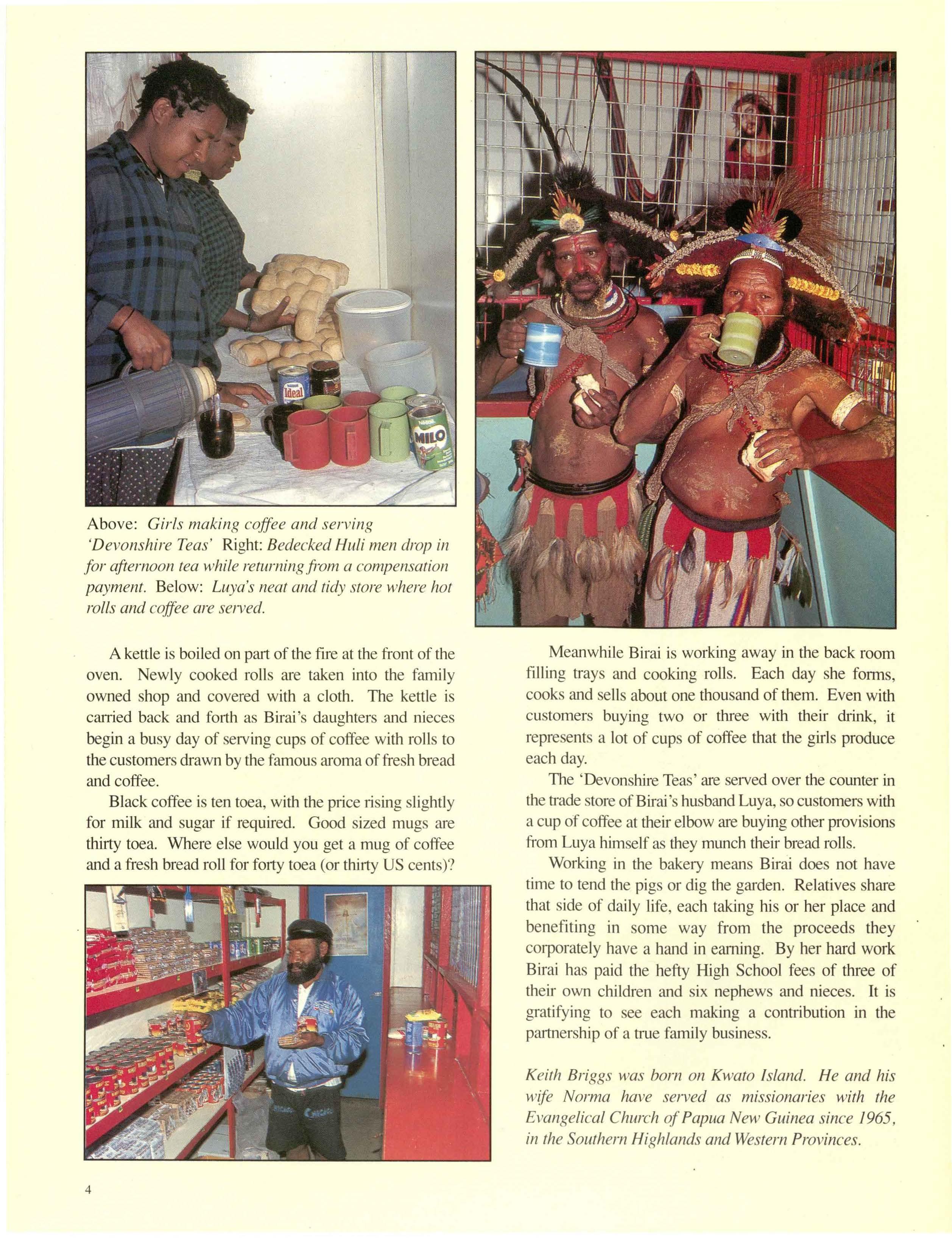
Meanwhile Birai is workjng away in the back room filling trays and cooking rolls. Each day she forms, cooks and sells about one thousand of them. Even with customers buying two or three with their drink, it represents a lot of cups of coffee that the girls produce each day.
The 'Devonsrure Teas' are served over the counter in the trade store of B irru 's husband Luya, so customers with a cup of coffee at their elbow are buying other provisions from Luya himself as they munch their bread rolls Working in the bakery means Birai does not have time to tend the pigs or dig the garden. Relatives share that side of daily life, each taking ms or her place and benefiting in some way from the proceeds they corporately have a hand in earning. By her hard work Birai has paid the hefty High School fees of three of their own children and six nephews and nieces. It is gratifying to see each making a contribution in the pa1tnership of a true family business.
K e ith Brig gs was born on Kwato Island. He and his wife Norma have served as missionaries with the E van ge li cal Church of Papua New Guinea since 1965, in th e South e rn Hi g hlands and Western Provinces.
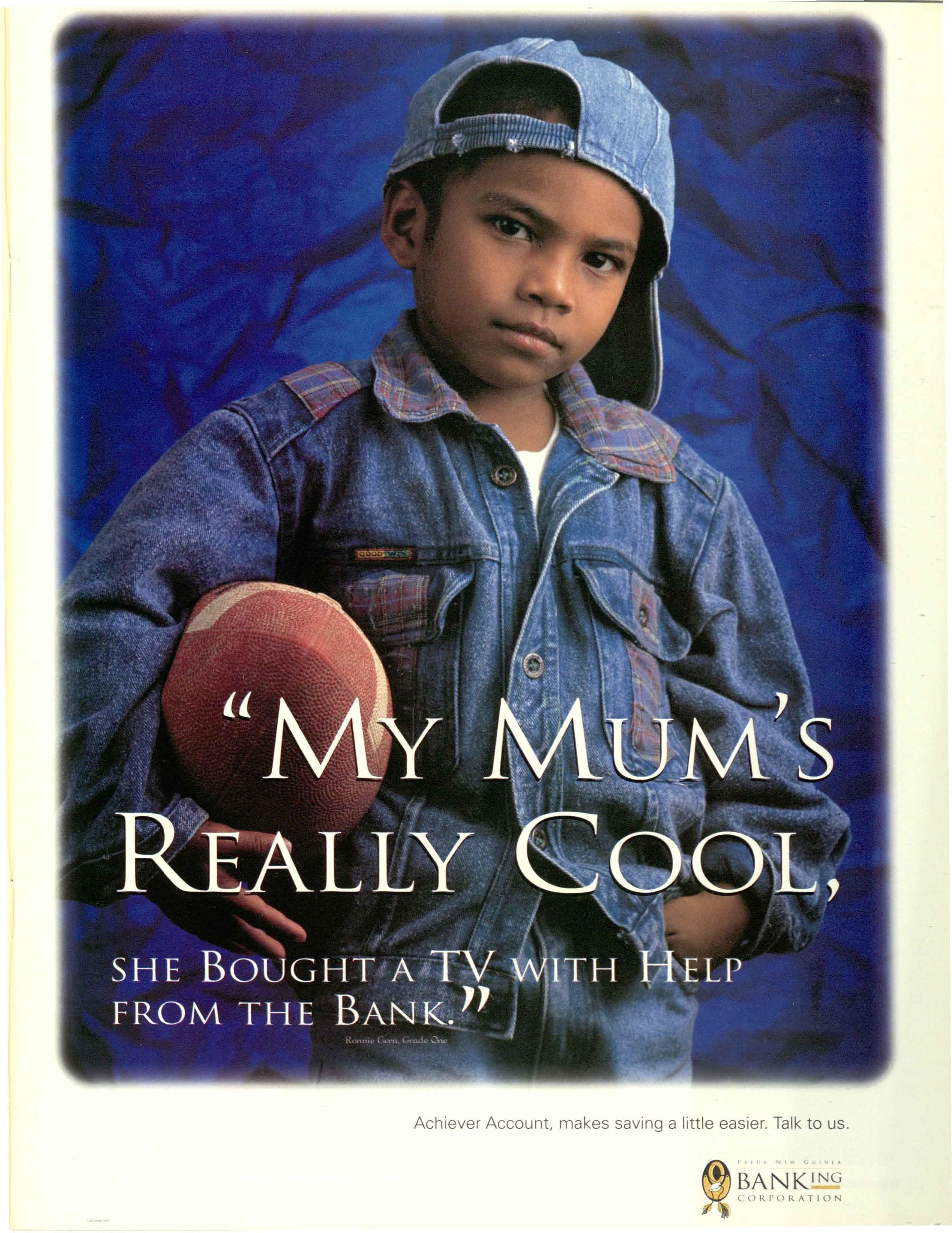
Achiever Account, makes saving a little easier. Talk to us.
It's Perfectly Clear...
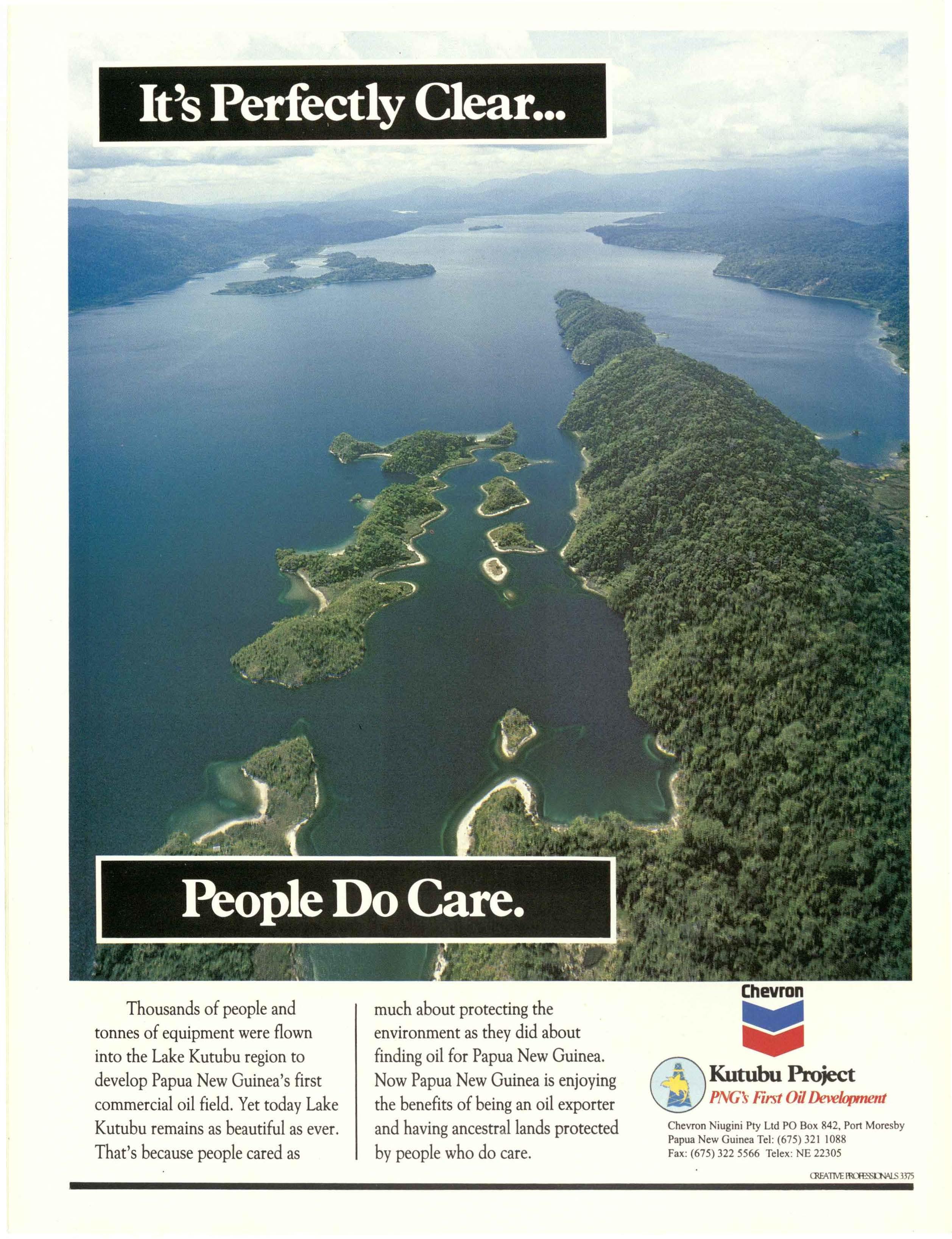
Thousands of people and tonnes of equipment were flown into the Lake Kutubu region to develop Papua New Guinea's first commercial oil field. Yet today Lake Kutubu remains as beautiful as ever . That's because people cared as
much about protecting the environment as they did about finding oil for Papua New Guinea. Now Papua New Guinea is enjoying the benefits of being an oil exporter and having ancestral lands protected by people who do care.
Written by David Finkelstein
by Evelyn Letfuss
Es prob abl y safe to say th at few of o u are g oing to j ump on the first lane to the wilds of Madang Province and, rod in hand, head for the B ismarck Sea after reading this article But be aware th at top fis hermen from around th e worl d - fr om A ustralia, Asia, eve n fr om America - have already done just that. Thanks to the efforts of P ap ua New Guinea-born plantation owners B rett and Vicki Middleton, a wonderful young couple with a passion for big-game fishing, these visiting anglers have foun d th at the place is far less wild than they feared and the fishing far better than they ever imagined.
We first heard about Madang's Reel Fis h Charters from well-known Cairns ski pper Peter B . Wright, whom
we met during a stopover at the Great B arrier Reef on the way to Papua New Guinea .
'Be sure to meet the Middletons ,' he urged us , his regard for them so evident we knew we ' d not be disa pp ointed. 'They run a really fine game fishing operation.'
They do indeed , as we ourselves discovered when we reached Madang.
Though it ' s all too true that Papua ew Guinea ' s capital, Port Moresby and a number of other town s througho ut the country are beset by the universal 20th century affliction, urban crime and the breakdown of law-and-order, set your mind at re st about the township and province of Madang Located on the north west coast of the country, the town 1s
perhaps the prettiest in the entire South Pacific - and among the most serene and safe.
For tho se of you whose memories of the Great Barrier Reef go back that far, Madang is as quaint and charming today as Cairns was in the ' 70 s, before developers ' malled' it bey ond recognition.

Above: Th e Middletons' 36 foot Talia
Below left: Ye llowfis h tuna that was cau g ht o n co lo wful plastic lure
Below right: Kingfish that fell for a sailfi sh bait
Photographs
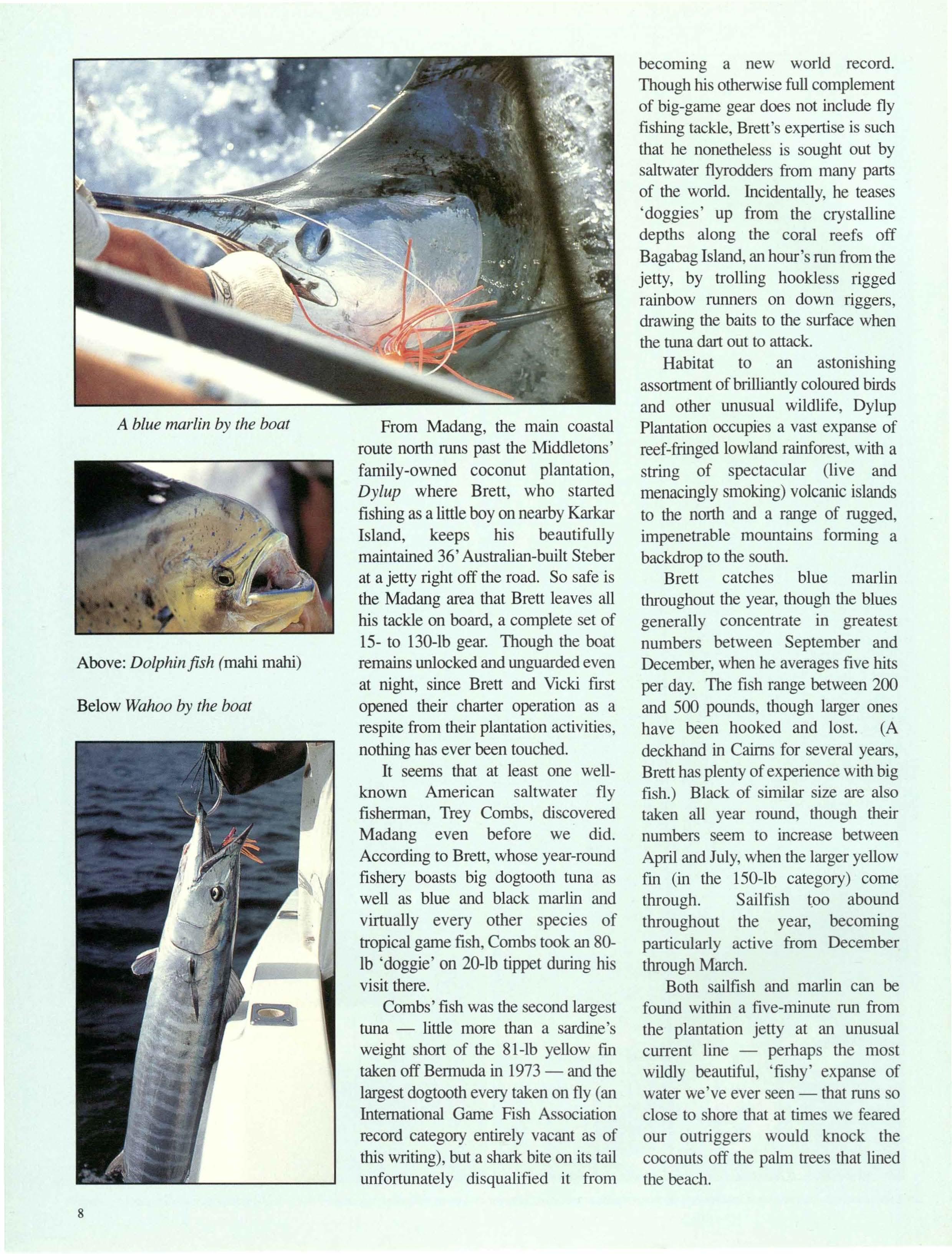
From Madang, the main coastal route north runs past the Middletons' family-owned coconut plantation, D ylup where Brett , who started fishing as a little boy on nearby Karkar Island, keeps his beautifully maintained 36 ' Australian-built Steber at a jetty right off the road. So safe is the Madang area that Brett leaves all his tackle on board , a complete set of 15- to 130-lb gear. Though the boat remains unlocked and unguarded even at night, since Brett and Vicki first opened their charter operation as a respite from their plantation activities, nothing has ever been touched.
It seems that at least one wellknown American saltwater fly fisherman, Trey Combs, discovered Madang even before we did.
According to Brett, whose year-round fishery boasts big dogtooth tuna as well as blue and black marlin and virtually every other species of tropical game fish, Combs took an 80lb 'doggie' on 20-lb tippet during his visit there.
Combs' fish was the second largest tuna - little more than a sardine's weight short of the 81-lb yellow fin taken off Bermuda in 1973 - and the largest dogtooth every taken on fly (an International Game Fish Association record category entirely vacant as of this writing), but a shark bite on its tail unfortunately disqualified it from
becoming a new world record. Though his otherwise full complement of big-game gear does not include fly fishing tackle, Brett's expertise is such that he nonetheless is sought out by saltwater flyrodders from many parts of the world Incidentally, he teases ' doggies' up from the crystalline depths along the coral reefs off Bagabag Island, an hour's run from the jetty, by trolling hookless rigged rainbow runners on down riggers , drawing the baits to the surface when the tuna dart out to attack.
Habitat to an astonishing assortment of brilliantly coloured birds and other unusual wildlife, Dylup Plantation occupies a vast expanse of reef-fringed lowland rainforest, with a string of spectacular (live and menacingly smoking) volcanic islands to the north and a range of rugged, impenetrable mountains forming a backdrop to the south . Brett catches blue marlin throughout the year, though the blues generally concentrate in greatest numbers between September and December, when he averages five hits per day. The fish range between 200 and 500 pounds, though larger ones have been hooked and lost. (A deckhand in Cairns for several years, Brett has plenty of experience with big fish ) Black of similar size are also taken all year round , though their numbers seem to increase between April and July, when the larger yellow fin (in the 150-lb category) come through. Sailfish too abound throughout the year, becoming particularly active from December through March.
Both sailfish and marlin can be found within a five-minute run from the plantation jetty at an unusual current line - perhaps the most wildly beautiful, 'fishy' expanse of water we've ever seen- that runs so close to shore that at times we feared our outriggers would knock the coconuts off the palm trees that lined the beach.
A blue marlin by the boat
Above : Dolph in fish (mahi mahi)
Below Wahoo by the boat
Brett and Vicki divide their tim e between working their plantation and tending their charter operation. Half the month is devoted to producing copra, the other half to pleasing anglers. So when Brett fishes , he really fishes - from 6.30 in the morning to 6.30 in the evening, from daybreak to dusk. When Vicki plays host and caterer, she really hosts and caters. Anglers stay at the plantation's extremely comfortable guest house , located right next door to
Left: Moabi and Brett rig a baitfish for dogtooth tuna fishing off Karkar ___, Is land
Right: Brett Middleton 's longtime deckhand and boyhood friend, M oabi, rigs sma ll mullet.
Below left: Lady angler wi th jumping sailfish
the Middletons' own residence, with the outdoor bar and pool just a few steps away. Eating with the family is a real treat because Vicki's cooking is superb beyond description. Small wonder I have so much praise for what this positively delightful couple have accomplished in Madang and why, though they never advertise, so many big-game anglers fly to Papua New Guinea and flock to their doorstep throughout the year.
Brett and Vicki Middleton meet anglers at Madang airport and from there on you ' re entirely in their exce llent care with full-board accommodation and boat charter provided.
Contact the Middletons at Reel Fish Charters , MV Talia, PO Box 521, Madan.g.
Telephone: (675) 8537496
Fax: (675) 8537468

Selection of blue marlin lures
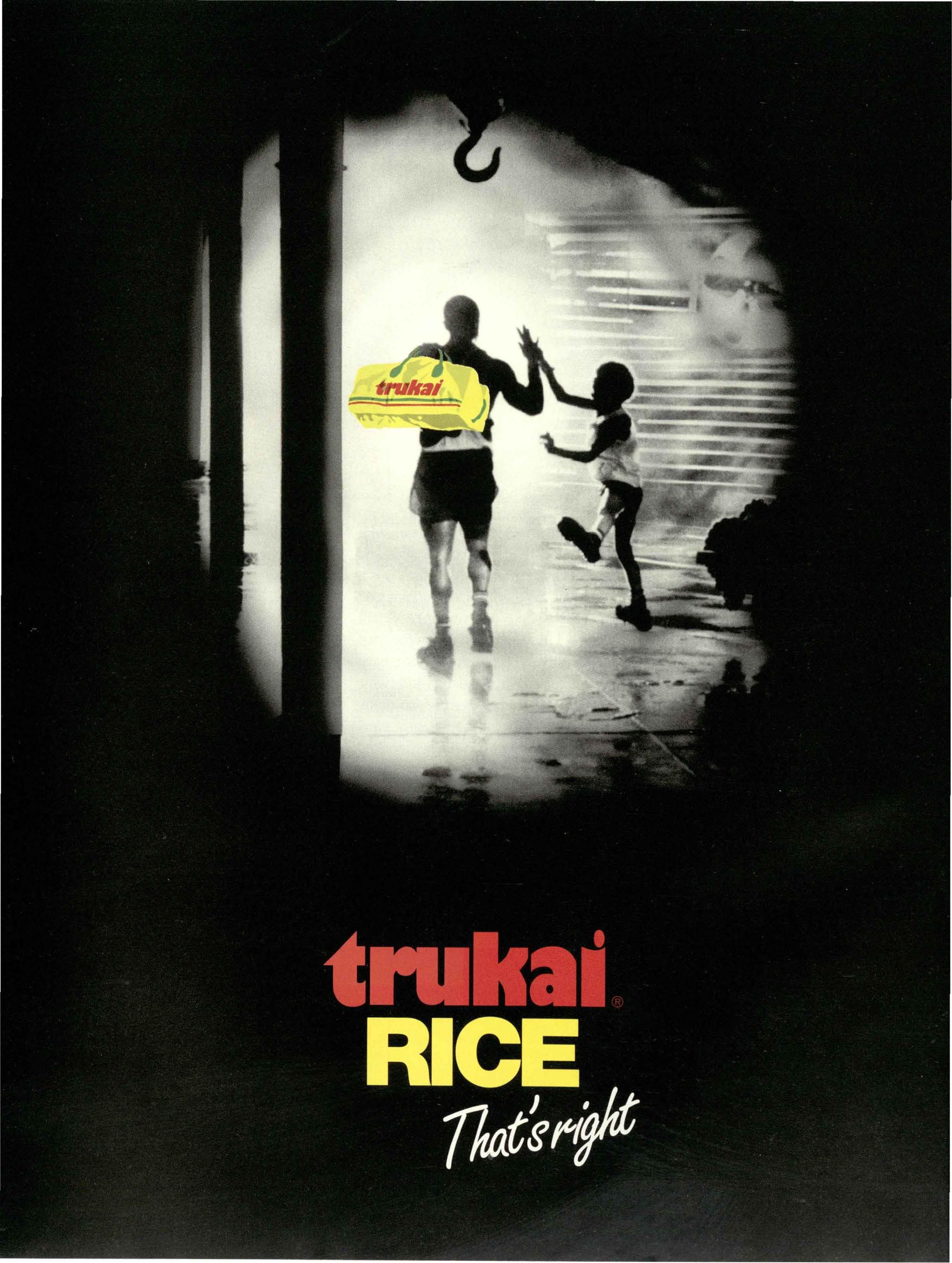
PNG Women Writers is a collection of poems, short stories and play s by eleven women writers including ora Yagi Brash , Joyce Abaneta Kumbeli , Sally Ann Bagit.a, Loujaya Mojii Dunar and Mary Toliman. The anthology was compiled by Adeola James, a igerian-bom writer who taught literature at the University of Papua ew Guinea in the 1970s and
BOOK REVIEW - by
organised the successful Pacific Women Writers' workshop at UP G in 1992 . The anthology is enhanced by lively and compelling interview with five of the writers that provide an insight into their backgrounds and motivations. The interview s touch on issues of social change, women' traditional role , and the challenge for women writer to develop creatively a arti ts while maintaining commitments to wo rk and family.
In some ways the book is a retro s pective collection of works written during the 1970 and early 1980 when there was an outpouring of creative writing encouraged by the annual ational Literature Competition and the publication of literary journals such as Ondobondo and Bikmau s. Significantly, the anthology feature the popular satirical play, Which Way Big
Dream Tripper
by Loujaya Mojii Dunar
Sunri e on an open ky Suitcase in hand
A I sai d goodbye face towards the east I go On a road that takes me On who really knows
Follow the lines of the horizon living in a dream for far too long hoping that it'll grow old
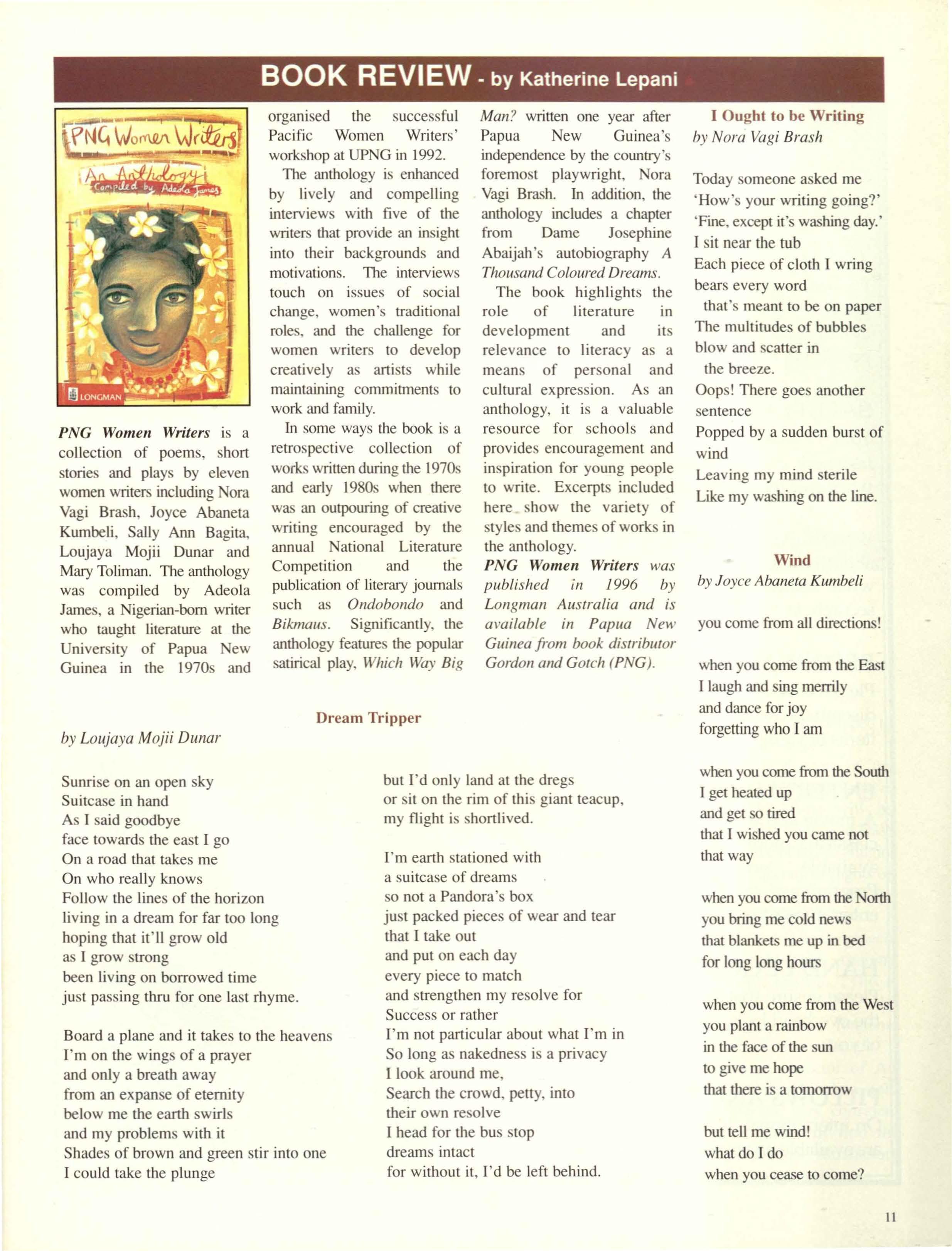
Katherine Lepani
Man ? written one year after Papua New Guinea 's independence by the country's foremost playwright , ora Yagi Brash. In addition, the anthology includes a chapter from Dame Josephine Abaijah ' autobiography A Thousand Coloured Dreams
The book highlights the role of literature in development and its relevance to literacy as a mean of per onal and cultural expression. As an anthology, it is a valuable resource for schools and provide encouragement and inspiration for young people to write. Excerpt included here how the variety of sty le s and theme s of works in the anthology.
PNG Women Writers was published in 1996 by L o ngman Australia and is available in Papua New Guinea from book distributor Gordon and Gotch ( PNG )
but I'd only land at the dregs or sit on the rim of thi giant teacup, my flight is s hortlived
I'm earth s tationed with a suitcase of dreams
so not a Pandora 's box just packed piece of wear and tear that I take out as I grow strong been living on borrowed time just passing thru for one last rhyme.
Board a plane and it take to the heaven
I'm on the wings of a prayer and only a breath away from an expanse of eternity below me the earth swirl and my problem with it
Shades of brown and green stir into one I cou ld take the plunge
and put on each day every piece to match and strengthen my resolve for Success or rather I'm not particular about what I'm in So long as nakednes i a privacy I look around me, Search the crowd, petty into their own re olve I head for the bus stop dreams intact for without it, I'd be left behind.
I Ought to be Writing by
Nora Vagi Brash
Today someo ne a ked me
' How 's your writing going?' 'F ine , except it's washing day.'
I sit near the tub
Each piece of cloth I wring bears every word that 's meant to be on paper
The multitudes of bubbles blow and catter in the breeze.
Oop s! There goes another se ntence
Popped by a s udd en burst of wind
Leaving my mind s terile
Like my washing on the line.
Wind by Jo
yce Abaneta Kumbeli
you come from all directions!
when you come from the East I laugh and ing merrily and dance for joy forgetting who I am
when you come from the South I get heated up and get o tired that I wished you came not that way
when you come from the orth you bring me cold new that blankets me up in bed for long long hours
when you come from the West you plant a rainbow in the face of the un to give me hope that there is a tomorrow
but tell me wind! what do I do when you cease to come?
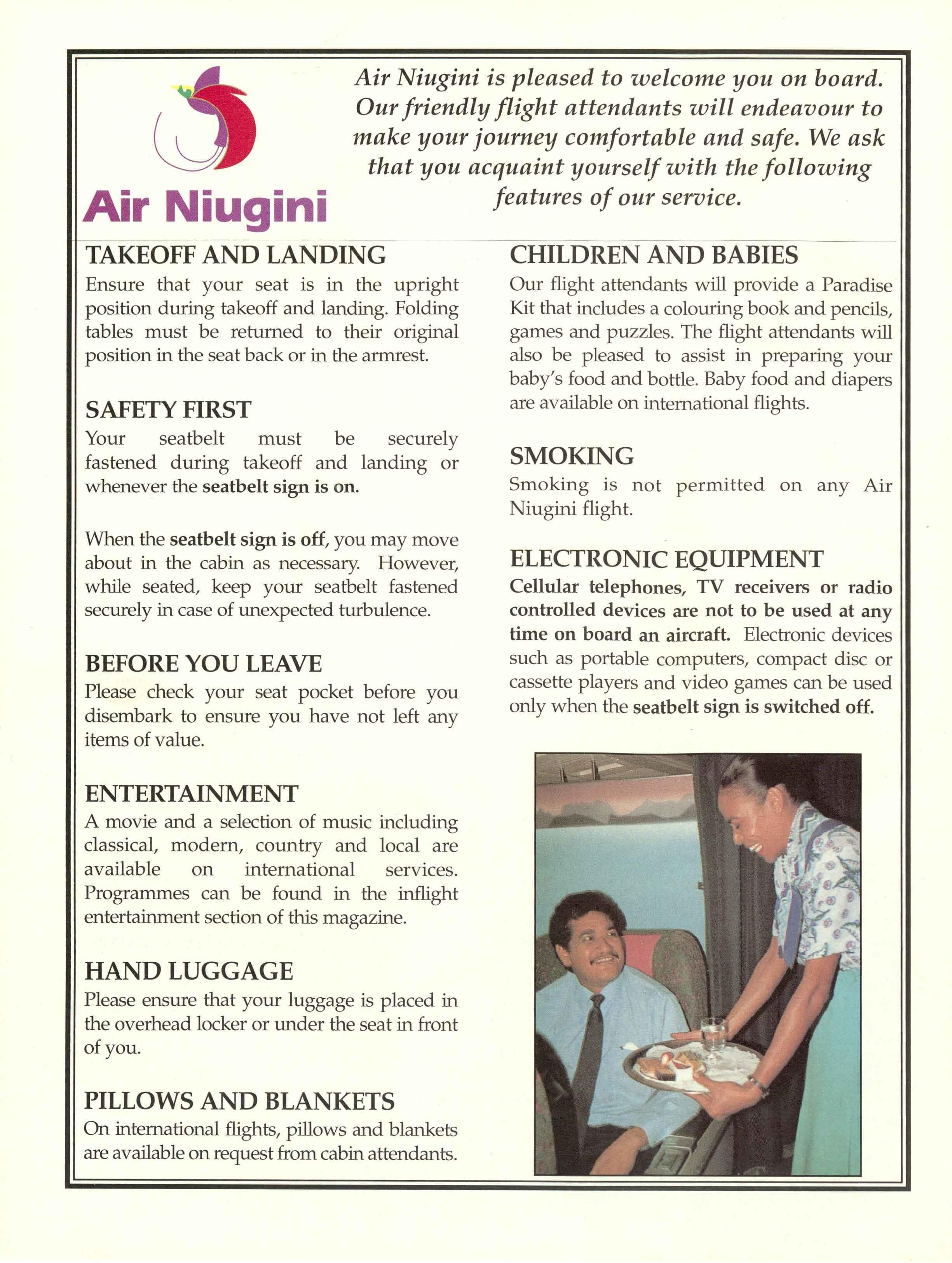
Air Niugini is pleased to welcome you on board. Our friendly flight attendants will endeavour to make your journey comfortable and safe. We ask that you acquaint yourself with the following
Air Niugini
TAKEOFF AND LANDING
Ensure that your seat is in the upright position during takeoff and landing. Folding tables must be returned to their original position in the seat back or in the armrest.
SAFETY FIRST
Your seatbelt must be securely fastened during takeoff and landing or whenever the seatbelt sign is on.
When the seatbelt sign is off, you may move about in the cabin as necessary. However, while seated, keep your seatbelt fastened securely in case of unexpected turbulence.
BEFORE YOU LEAVE
Please check your seat pocket before you disembark to ensure you have not left any items of value.
ENTERTAINMENT
A movie and a selection of music including classical, modem, country and local are available on international services. Programmes can be found in the inflight entertainment section of this magazine.
HAND LUGGAGE
Please ensure that your luggage is placed in the overhead locker or under the seat in front of you.
PILLOWS AND BLANKETS
On international flights, pillows and blankets are available on request from cabin attendants.
features of our service.
CHILDREN AND BABIES
Our flight attendants will provide a Paradise Kit that includes a colouring book and pencils, games and puzzles. The flight attendants will also be pleased to assist in preparing your baby's food and bottle . Baby food and diapers are available on international flights.
SMOKING
Smoking is not permitted on any Air Niugini flight.
ELECTRONIC EQUIPMENT
Cellular telephones, TV receivers or radio controlled devices are not to be used at any time on board an aircraft. Electronic devices such as portable computers, compact disc or cassette players and video games can be used only when the seatbelt sign is switched off.
Air Niugini's New Aircraft Dash 8-200B
When Air Niugini commenced operations 24 years ago it had one plane, a Fokker Friendship, which flew one single route. Today, the air! ine has a fleet of thirteen aircraft and serves eight international routes and twenty-one domestic ports. The latest acquisitions to the fleet are two Dash 8-200B aircraft, which have replaced the two Da sh 7s. The first Dash 8 arrived in April and the second in May. They are now serving the ports previously served by the Dash 7 , namely Lihir Island , Daru , Kundiawa , Mendi, Tari , Wapenamanda and Popondetta
The Dash 8-200B ha s 36 seats and, like the Dash 7, will be operated as all-passenger aircraft or as combination with 28 passenger seats and cargo.
Before choosing the new aircraft, Air Niugini conducted an extensive evaluation of various types of aircraft. The Dash 8-200B was chosen for its suitability for the Papua New Guinea aviation environment. It is capable of operating into narrow, gravel airstrips at altitudes up to 1500 metres and where temperatures are high , averaging between 25 to 30 degrees C.
Unlike many other aircraft and older models of the Dash 8, the latest technology -200B can operate with maximum payload under these conditions. The Dash 8 will also have no difficulty making rapid ascents and descents. To fly to Popondetta from Port Moresby, for example, requires taking off from sea-level , climbing over the 3,600 metre Owen Stanley Range of mountains, and then almost immediately descending to sea level
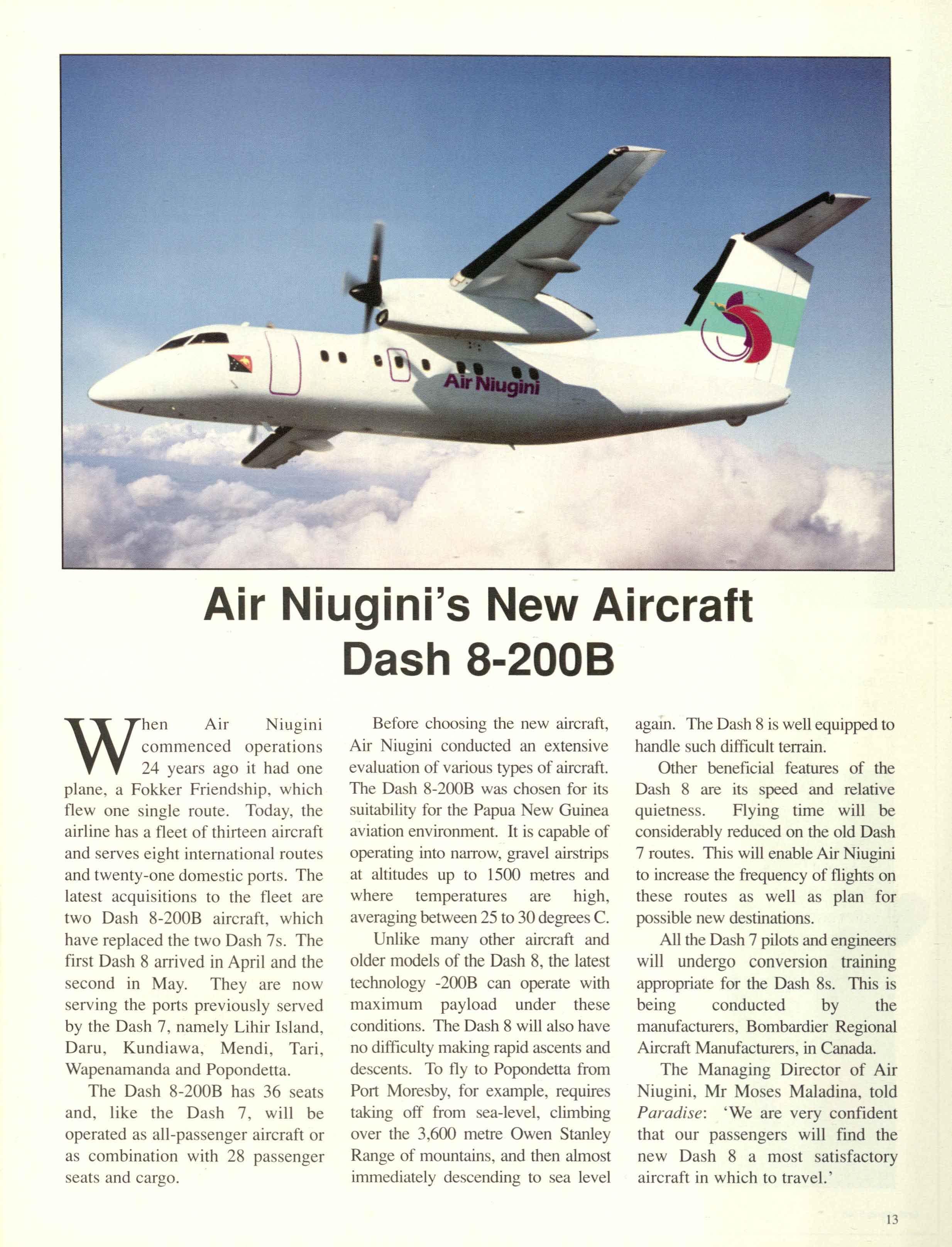
agam. The Dash 8 is well equipped to handle such difficult terrain.
Other beneficial features of the Dash 8 are its speed and relative quietness. Flying time will be considerably reduced on the old Dash 7 routes. This will enable Air Niugini to increase the frequency of flights on these routes as well as plan for possible new destinations.
All the Dash 7 pilots and engineers will undergo conversion training appropriate for the Dash 8s. This is being conducted by the manufacturers, Bombardier Regional Aircraft Manufacturers, in Canada.
The Managing Director of Air Niugini, Mr Moses Maladina, told Paradise: ' We are very confident that our passengers will find the new Dash 8 a most satisfactory aircraft in which to travel. '
e • reco n1se •
otent1a •
Th e Public Officers Superannuation Fund is one of PNG's leading investors.
The P.0 .S.F. manages the superannuation contributions of PNG's public servants. That's a big responsibility.
It's also a big opportunity b eca use we inv est this money to increase the savings of public servants a nd , on a bro ade r scale, to benefit eve ryone inPNG.
We do this by recognising sound, profitable inv es tm e nts. It may be land or building developments, mining, commercial ventures, in fact anywhere we see potential for the future.
Sometimes our investments are short term. Sometimes long term. But we always inv es t with the aim of bringing a return to our members a nd overall growth to the future of PNG.
Because we know that, just as with flowers , if we nurtur e potential carefully, we'll have a beautiful future .
To discuss your particular sound business proposal, please contact th e Managing Director by telephone on 321 2382, or by fax on 321 2745.

Dendrobium Alba Tabo is an orchid unique to Papua New Guinea, a country rich in flora and fauna.
It's also a country rich in human resources promising a bright future.
The PO SF plans to enrich that promise by turning today 's potential into tomorrow's growth
SIIG SIIG
Story and photographs by Liz Thompson
ASing Sing took place last year in the middle of Melbowne.
Singsing is a Pidgin word commonly used in Papua ew Guinea to describe a gathering of people for a ceremony that includes singing, dancing and, sometimes, a ritual pig kill. In this instance, it was villagers from Papua New Guinea, Torres Strait Islanders, black and white Australians joining together for a performance of music and dance which explored their cultural connections as well as celebrated the immense musical talent found within the region.
The gathering initially took place in the middle of Fitzroy at Adelphia studios. 'Adelphia' - Greek for 'Brother' - is run by three charming Greek brothers who have wonderful tales to tell of their voyage to Australia. Here, for several days, arriving at 11am and often not leaving until midnight, were 23 performers. From the rehearsal rooms you could hear the sounds of a truly cross-cultural collaboration - gararnut drums carved out of one large tree trunk and beaten with wooden sticks and flutes from Papua New Guinea, didgeridoos and clap sticks from Aboriginal Australia, synthesisers, drums, mandolins, cellos and ukuleles.
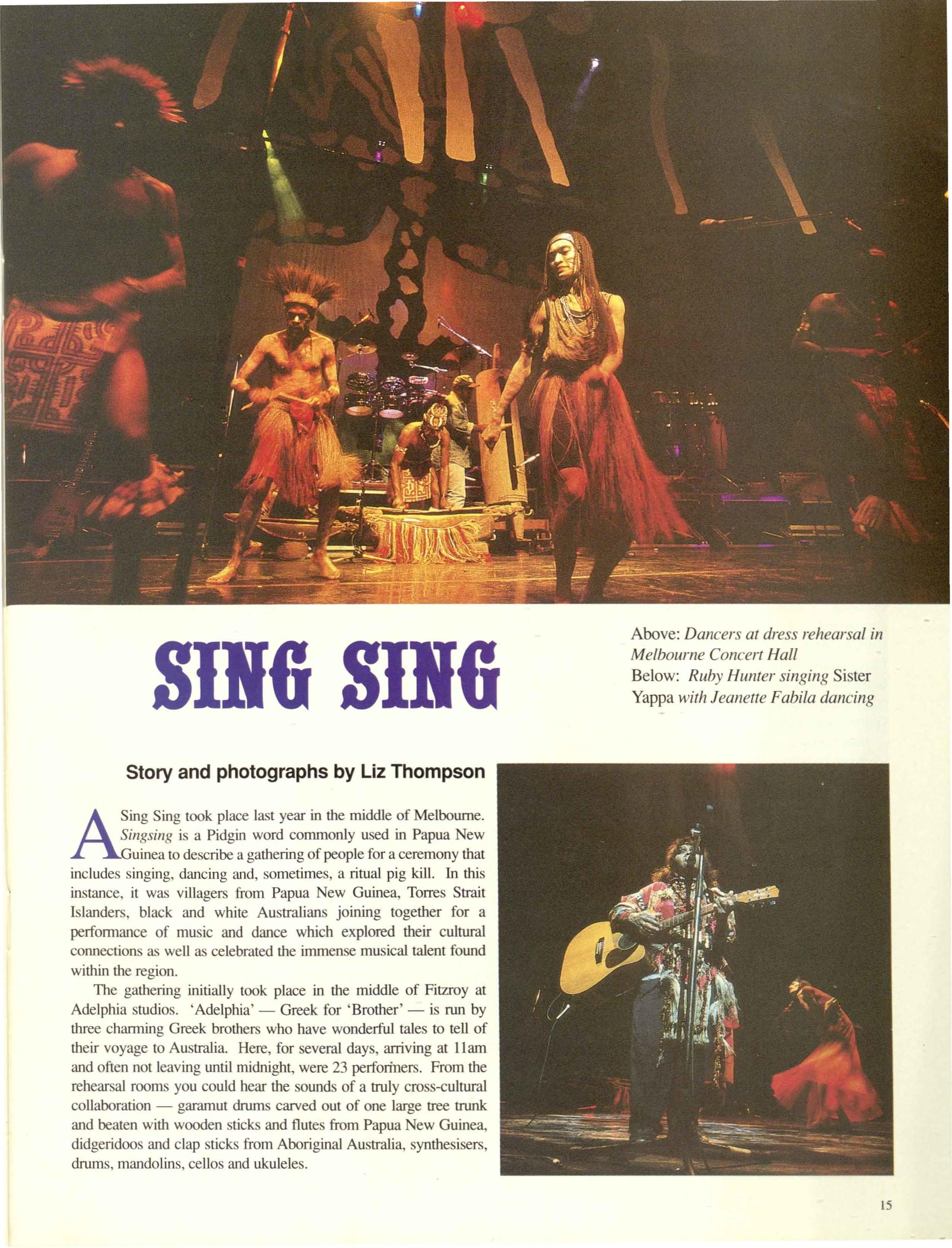
Above: Dancers at dress rehearsal in Melbourne Concert Hall
Below: Ruby Hunter singing Sister Yappa with Jeanette Fabila dancing
This landmark eve nt was prese nted by the Victorian Arts Centre, the Next Wave Fe stival , Triple J World Mu s ic Show and sponsored by CRA Foundation for the Arts and the Australia Council. The Australian High Commission in Port Moresby assisted with financial support for the Papua New Guinean section of the concert tour. Rehearsals lasted for two weeks before perfmmances at the State Theatre in Sydney, the Melbourne Concert Hall and Port Moresby.
Sing Sing was initiated and directed by David Bridie who was vocalist , piano and keyboard player with Not Drown ing Waving and continues to perform with another band , My Fri end Th e Chocolate Cake. In 1988 Not Drowning Wavin g went to Rabaul folJowing an invitation from Greg Seeto , the manager of Pacific Gold Studios, to record with local musicians. The result was Tabaran a ground breaking album that demonstrates the result of colJaboration of musician s from different cultural backgrounds. It began what has proven to be a lon g stand in g relationship between Bridie and a group of Papua New Guinean musician s .
Both Tabaran and the Sing Sing concerts are examples of what can be achieved when mu sician s from diverse cultural background s work together; they also reflect the strength of the relationships forged between tho se involved. It is a long way from the exploitative practice, sadly more common, in which western musicians record exotic, indigenou s music , add a drum loop and call the result their own , without either acknowledgment or royalties go ing to the musicians
Sing Sing, which brought together 23 performers and involved some of the region's best mu sician s and dancers, was an event lon g overdue. The line-up included Archie Roach and Ruby Hunter, two of Australia's best known Aboriginal singer-songwriters.
A Change is Gonna Com e, a song abo ut domestic violence by Ruby Hunter, was sung with breathtaking power.

' My music' , says Ruby, ' is ba sed upon s urviv al of an Aboriginal wom a n in tod ay's soc iety - a modem d ay world. I si ng about the past , my home , domestic violence, ince st, peo ple in the street. Som e of my so ngs are about dreaming. ' Archie Ro ac h perfo rmed D own City Streets and others from hi s popular .___ _,__ __. album Charcoal Lan e.
In s trumentalist Dave Steel who often works and records w ith Roach and Hunter also took part in Sing Sing.
Many of the Papua New Guinean mu sicians who were involved in Tabaran a ppeared George Telek from Raluana village near R a ba ul sang several of the so ngs that are featured on Tabaran including the hauntin g Abebe, a traditional chant in memory of the ancestral spirits. He also sang with Archie Roach a so n g which he wrote especially for th e Sin g Sing concert. Buruka Tau and Ben Hakilitz who now play with Yothu Yindi also performed. Pius Wasi from Chambri Village on th e Sepik Ri ver lam e nt s the fact that young people in his co untry a re not interes ted in traditional music. He believes this co n ce rt with it s st unning combination of traditional and contemporary influences will enco urage them to fee l proud of their own culture. ' To see traditional music performed in this way and enjoyed b y a n international aud ience is an important influence on our you ng people.'
Not Drownin g Waving pe rform ed seve ral so n gs from Tabaran including Blackwa ter, the lyric s of which tell of th e takeover of Irian Jaya by Indonesia and the oppression of the Irianese people.
Top: Buruka Tau , Da vid Bridie and Ben Hakilit z
Middle: G eorge Te/ e k and Archie Roa ch s in g ing a song written by Te lek
Also included were so me superb dance perfonnances - Papu a New Guinean musicians showed their traditional dances ; Buia , an Aboriginal dance gro up which includ es Albert David , Jeanette Fabila and Sam Barsah incorporated traditional and contemporary Torres Strait Island dance pieces Albert David ga ve an amazing
Above : Da vid Bridi e at the Melbourne Concert Hall perfonnance as a kangaroo hunted
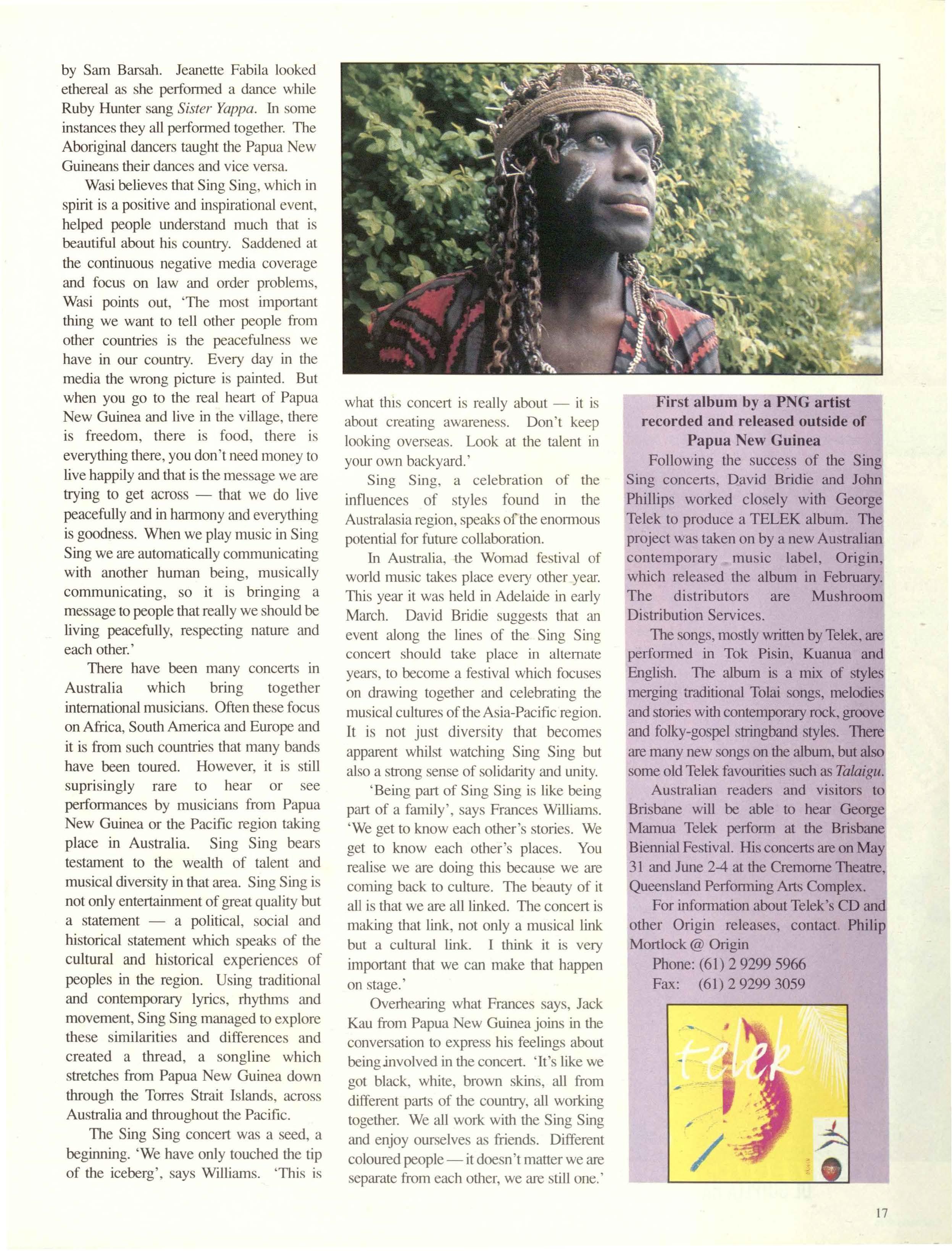
by Sam Barsah. Jeanette Fabila lo oked ethereal as she performed a dance whil e Ruby Hunter sang Sister Yappa. In some instances they all performed together. The Aboriginal dancers taught th e Papua New Guineans their dances and v ice versa.
Wasi believes that Sin g Sing , whi c h in spirit is a positive and inspirational event, helped people understand much that is beautiful about hi s country. Saddened at the continuou s negative medi a coverage and focus on law and order probl ems, Wasi points out, ' The most important thing we want to te ll other people from other countries is the peacefulness we have in our country. Every day in the media the wrong picture is painted But when you go to the real heart of Papu a New Guinea and live in the village , there is freedom , there is food , there is everything there , you don 't need money to live happily and that is the message we are trying to get across - that we do live peacefully and in harmony and everything is goodness. When we play music in Sing Sing we are automatically communicating with another human bein g, musically communicating, so it is bringin g a message to people that really we should be living peacefully, respectin g nature and each other.'
There have been many concerts in Australia which brin g together international musicians. Often these focus on Africa , South America and Europe and it is from such countries that many bands have been toured . However, it is sti ll suprisingly rare to hear or see performances by musicians from Papua New Guinea or the Pacific region taking place in Australia. Sing Sing bears testament to the wealth of talent and musical diversity in that area. Sing Sing is not only entertainment of great quality but a statement - a political , social and historical statement which speaks of the cultural and historical experiences of peoples in the region. Using traditional and contemporary lyrics , rhythm s and movement, Sing Sing managed to exp lore these similarities and differences and created a thread , a so ng line which stretches from Papua New Guinea down through the Torre s Strait Islands, across Australia and throughout the Pacific.
The Sing Sing concert was a seed, a beginning. ' We have only touched the tip of the iceberg', says Williams. 'This is
what this concert is really about - it is about creating awareness. Don ' t keep looking overseas. Look at the talent in your own backyard. '
Sing Sing, a ce lebration of the influences of sty les found in the Australasia region, speaks of the enormous potential for future collaboration.
In Australia , the Womad festival of world music takes place every other year. This year it was held in Adelaide in early March. David Bridie suggests that an event along the lines of the Sin g Sin g concert should take place in alternate years, to become a festival which focuses on drawing together and celebrating the musical cultures of the Asia-Pacific region It is not just divers ity that become s apparent whilst watching Sing Sing but also a strong sense of solidarity and unity.
'Being part of Sing Sing is like being part of a family', says Frances Williams 'We get to know each other's stories . We get to know each other's places. You realise we are doing this because we are coming back to culture. The beauty of it all is that we are all linked. The concert is making that link, not only a musical link but a cultural link. I think it is very important that we can make that happen on stage.'
Overhearing what Frances says, Jack Kau from Papua New Guinea joins in the conversation to express his feelings about being.involved in the concert. ' It 's like we got black, white, brown skins, all from different parts of the country, all working together. We all work with the Sing Sing and enjoy ourselves as friends. Different coloured people - it doesn't matter we are separate from each other, we are s till one.'
First album by a PNG artist recorded and released outside of Papua New Guinea
Following the success of the Sing Sing concerts, David Bridie and John Phillips worked closely with George Telek to produce a TELEK album. The project was taken on by a new Australian contemporary music label, Origin, which released the album in February. The distributors are Mushroom Distribution Services.
The songs, mostly written by Telek, are performed in Tok Pisin, Kuanua and English. The album is a mix of styles merging traditional Tolai songs, melodies and stories with contemporary rock, groove and folky-gospel stringband styles. There are many new songs on the album, but also some old Telek favourities such as Talaigu. Australian readers and visitors to Brisbane will be able to hear George Mamua Telek perform at the Brisbane Biennial Festival. His concerts are on May 31 and June 2-4 at the Cremorne Theatre, Queensland Performing Arts Complex.
For information about Telek's CD and other Origin releases, contact. Philip Mortlock @ Origin
Phone: (61) 2 9299 5966
Fax: (61) 2 9299 3059


THE CROCODILE
by Vincent Eri
r-y-,h e harsh rustle of the sago palms .1 contrasted sharp ly with the s low gen tl e swaying of the coconut palms.
ln the village below, clouds of di1ty brown dust danced in and out among the forest of houseposts. The wind forced itself through the cracks in the floor and the holes in the wal ls. The dust clouds twisted and turned, fom1ing weird and wonde1ful shapes.
A fence five feet tall encirc led the entire vi ll age. It was made of long bamboo tubes placed horizontally on top of each other. They we re kept in place by sap lin gs pegged into the ground . 171is fence had been erec ted on the orders of the Government officers who said that pigs must be kept away from the village.
On the windward side of th e village, outside the fence, stood a lone building. It stood in a no1th-south direction. Eac h wall had a blackboard nailed to it, the largest being on the south wall. There were pictures of Biblical stories , and an ABC chart that depicted many objects the children had never seen. A hun gry cockroach had eaten c lea n through d1e first picture which the teacher called 'apple'. Three portraits looked down on the chi ldren: King George YI, Archbishop De Bosimenu of Yule Island and St Therese, d1e patron Saint of the school.
No partitions separated one classroom from another. Everybody squatted cross legged on the palm wood floor.
The school grounds were a lways wet. The owne rs had allowed this land to be used for d1e school , because it wasn't much good for building a house. Each flood scoured d1e area of food wrappings, human and animal excreta and pieces of paper. During d1e day d1e children deposited more. At night the adu lts added to the collect.ion.
Huge breadfruit towered above, cutting out much of the sunli ght. 171e undergrowth a.round d1e classroom was so duck that the building was not visible from any direction, not even from the village Swanns of mosquitoes infested d1e dark shadows and bomered me children.
There were no toilets. Why bother to build houses to house our waste? That is what d1e vi!Jagers would say to me medical orderlies who complained. The villagers agreed that it was necessary to build ' small houses' for d1e Government officers, and the white missionaries. Their beaut iful white skins
looked too delicate to be alJowed to use d1e bush. The teachers and stude nts used the bush. So did all th e vi ll age people. The teachers themselves did not believe in the tory of the wonns tl1at made the people sick. obody had seen these wom1s of destruction . 171e bush was kept clean by the pigs, who grew fat on it and trailed th eir be ll ies on tl1 e ground.
Five days a week the c hildren strained their lun gs and vocal chords singing their alphabets and numerals. The teachers did not seem to be bod1ered by the noise. The pa.rents heard their children's voices when they passed by on d1eir way to the garden. To them it was ev id ence that their children were learningthough it seemed to have littl e significance for them what their children were learning.
There was a new boy in the preparatory class. He had been in the schoo l for a week. He had recently been transferred from the Protestant school, run by the London Missionary Society, to d1e Cad1olic school.
In the Daily Atte ndan ce register his name was recorded as Hoiri Sevese. His fatl1er, Sevese Ovou, was a deacon in the L.M.S Church Hoiri was about seven years old.
Hoiri had a bulging stomach, quite out of proportion to the size of his legs. It was surprising d1at he could see where he placed hi s feet when he was talking. The otl1er chi ldren nicknamed him taubada, which literally means 'big man'. OriginalJy it had been a term of respect for all white people living in d1e district - it was only later that it became a term of mockery.
Hoiri didn't look as if he was going to inherit d1e towering build of his father. He was short and stalky and some people commented that he was growing sideways.
Hoiri was shy in his new surroundings. Though he was fami liar enough with d1e ch ildren in his class, who had been his playmates for years in d1e village, d1e school work was different and even d1e prayers were said differently in the new school. But grad ually he picked up most ofd1e tricks of his new class. He learned, for example, that by saying 'May I leave the room' he could have as many recesses as he liked.
Right now he was anxious to leave d1e room. He had hidden a stick of sago in a secret place between the bearers und er the palm flooring, and was worried whed1er anod1er child might have discovered it. All the children kept the remains of d1eir breakfast in such secret places to be eaten later, and this made it necessary 'to leave the room' as often as possible. Noticing d1at many of his fiiends
were 'leaving the room' Hoiri wanted to follow, but lacked the courage to utter the password. Then. without warning , a boy nearest to him popped up like a cork out of water.
' Please teacher. may Hoiri leave the room ? ' he shouted at the top of his voice. What could the teacher do when four or five other such requests had come from various quaners of the class?
Without even looking , he gave his consent.
Hoiri felt greatly indebted to his courageous friend. If his sago was still d1ere his friend must have some of it. In a flash he had disappeared under the building.
One or two pigs raised themselves from their siesta and eyed him askance. Others rubbed their mud-covered bodies furiously against the posts. The children in the school had got used to the countless mild eanhquakes every day.
Hoiri searched for his sago in vain. Someone had 'left the room ' earlier, and had discovered the hiding place. He fought hard to hold back his tears. Lunch was still an hour or so away. Concentration was more difficult on an empty stomach. For the first time he questioned his reason for being in school. He had no clear ideas about this, but felt , vaguely, that he wanted to learn d1e white man 's language . Not because he wanted to get a wellpaid job - for there weren ' t any such jobs for Papuans and New Guineans to fill - but because the ability to converse wid1 tl1e white people would earn him a respected position in the eyes of the community.
Hom wondered whed1er he would fmd anything to eat at his aunt's house. Two weeks ago iliings had been very different. Then his mother was alive and even when she went fishing or gardening she had always left some cooked food ready for him. But now Hoiri wa.sn 't too eager to clear the steps of the classroom when the last phrase of d1e prayer had left his lips.
' Aren't you going to kneel down, Hoiri? We are all waiting for you.' Faintly the teacher's voice penetrated his brain. Hoiri had been so absorbed in his thoughts that he hadn ' t been aware of the silence that had fallen upon the building.

Hoiri had not become used to the Catholic way of kneeling for prayers and of making the sign of the cross. In his old school the teacher spoke the prayer alone, everyone else stood with their heads bowed and their eyes closed. Here they all recited the prayer together with the teacher. Hoiri was surprised that in the Catholic school the same Father, Son and Holy Ghost were mentioned in the prayers. Why was there so much antagonism in his vi ll age between the followers of the two missions? Whatever the arguments were about, the London Missionaiy Society seemed to be in the stronger position. They had been the first to estab li sh themselves in the village. In fact Hoiri's grandfather had been a very small boy when the Reverend James Chalmers first landed on the beach of Moveave.
Hoiri made his way into the village under the cloudless sky. The sun made the shadows of the ho uses darker than they really were. Among the disorderly rows of houses, the e/a\'O men's houses with their huge pointed gables towered impressive ly. Even though Moveave was one of the largest villages in the Papuan Gulf it looked fairly deserted now. A few women were goss ipin g and weaving mats under the houses. Others were patching holes in their fishing nets, or picking li ce from each other's hair.
Out in the open the g lare from the sandy soil was hard on the eyes. The air was heavy with the unpleasant smell of scorched eai1h. Hoiri wished he was taller than three foot six. He cursed the people who did not teach their c hildren ai1d their dogs to do their business outside the village fence.
BaI1ds of ill-fed dogs roamed the streets. They how led miserably in the hope that some kindheai1ed people might give them some titbits to eat. They appeared to have chaI1ged the us ua l order of nature: the bones of their ribs appeaic:d to grow outs ide their skins.
Hoiri could tell that his aunt had gone out with the other inhabitaI1ts of the house. The only step to the house had been pushed aside so that waI1dering dogs could not enter the house uninvited Hopefully Hoiri searched the food rack above the fireplace. Over the years the smoke of cooking fires had coloured the entire room a dirty brown. For a minute he couldn't see a nythin g while his eyes adjusted them selves to the dark.
'Have you found aI1ything yet?' The voice belonged to Hoiri's cousin Meraveka, who went to the L.M.S. school. 'I've got a long stick of sago that will be more thaI1 enough for both of us.' Hoiri reappeared from the darkness of the hou se holding a whole roasted b1c:adfruit and half a dried coconut - still in its shell.
The cousins exchanged food as they walked together. The oil from the dry coconut made it easier to swa ll ow the rubbe1y sago. The breadfruit was of the Samoan variety, which had been introduced by early South Sea missionaries.
'How do you like the Catholic school?' Meraveka was ai1xious to fmd out what new knowledge his co usin was acquiring. 'I 3111 not as happy as when we were at school together. I can't understand why my pai·ents did not take you to stay with us when your mother died. Is it not customaiy for the father's close relatives to take care of the children when the mother dies? But look what happened. They let your aunt Suaea take you with your brother aild sister into their house. And now she made you become a Catholic.'
Hoiri was troubled by his cousin 's talk. He knew that he hin1self had nothing to do with the state of affairs. His father hadn't explained aI1ything 10 him either. In fact he had mysteriously disappeai·ed soon after his mother's burial aild Hoiri did not know where he was or what he was doing.
'It was my father who made the decision,' Hoiri maJ1aged to say with great difficulty. 'l had no choice but to go and live with Aunt Suaea. She said that if 1 didn ' t go to the Cathol ic schoo l, she wouldn't give me a rami to wear. I chose to keep myself covered, rather thaJ1 exposing myself to all the girls.'
A long silence followed. Meraveka felt he shouldn't have asked in the first place.
'What sort of things aic: you learning at the new school?'
' Oh, the usual A, B, Cs aJ1d 1, 2, 3s. The main difference is that the teachers speak to us in English most of the time.'
' I wou ld like to learn that laJ1guage too. I envy the village constable, the councillors aJ1d medical orderly who can speak to the government officers when they come to our vil lage. The SamoaJ1 pastors in our school teach us well, but I don ' t like the way they speak to us in Toaripi. They don't even speak it properly.'
Hoiri felt elevated. He was learning something his cousin waI1ted to know. What is more, he told his cousin that in the Catholic school the children were not forced to make sago for their teachers, a practice that was common in the L.M.S. school aJ1d a task that took up the best pru1 of the day. Hoiri had heard his father say to the Eka/esia that the practice was undesirable but absolutely necessaiy. 'These SamoaI1s,' he would say, 'have come a long way to bring the Word of God to us. They have no laI1d here where they could make their
gardens. It is our responsibility to see that they have enough to eat.'
'I wish I could come to the sru11e school as you ,' Meraveka said, almost to himself. Hoiri felt sorry for him. He knew what these sago expeditions were like and he knew the punishment for shirking them. Most boys realised that it was wiser to go on the tedious sago expeditions than to face the embarrassment of being caned naked in front of the girls.
Together the cousins forded the creek d1at was the only outlet in the south of the village to the large wate1ways. The tide was low and the water was up to d1eir thighs.
The cool smell of mud was a relief to their nostrils. Though the water was full of aI1imal and humaJ1 excreta , the two boys were not bothered in the least. They had been swimming in that saI11e creek ever since they had been able to float.
Long parallel trenches on the mud marked the moOiing places of the caI1oes. Now only a few unserviceable Cailoes were left lying around. But on a Sabbath day or on Fridaythe 'Government day' - the saI11e creek would be jammed with caI1oes.
'Did you notice that Government office rs don ' t usually come to our village at low tide?' Hoiri remarked. 'I suppose d1at with all the excreta floating around they are afraid of letting the water touch their cleaI1 white feet.'
' I have never seen them brave the water in this creek as yet,' Meraveka added support ' Whenever they come their caJ1oes aic: laden with so maI1y patrol boxes, caJ1ons of goods aJ1d furniture - you would think they'd come to stay for months. With that kind of load at low tides the caI1oe caI1 't get ai1ywhere near the nom1al laJ1ding places. So the men of our village have to carry them like small children! ' When d1ey had crossed to the other s id e they could hear die laughter aild chattering of other boys not fai· away. It was usual at this time of day for the boys to collect coconuts aI1d for the girls to cut wood aJ1d fill the water pots ready for their parents ' return.

Soon boys disappeared in the thick undergrowth, each heading for his family's coconut grove. Hoiri and Meraveka made haste, because they knew that they had to swim across the same creek nearer to its junction with a large waterway and crocodiles had been known to venture right up to the village with the incoming tide.
By the time the sun was level with the tree tops the boys had their bundles of nuts neatly tied up. They suspended the load on a stick between the two of them and marched off to the bank of the creek to await the arrival of some fishing canoes. They noticed the white bubbles in the water and knew that some canoes must have already gone past. 'Can you hear the tui calling? It is announcing the tum of the tide,' Meraveka said. 'Many more canoes should be here any minute .'
Soon a large canoe full of women and girls swung into view from the bend in the creek. Their chattering was out of step to the rhythm of the paddles. Already the two boys could recognise one or two faces in the canoe. They all belonged to the boys' fathers ' clan , the Operoro clan. Therefore they regarded all the girls as their sisters and all the women as their mothers.
That night the full moon was out. It was still a period of mourning so die children did not boo and cheer. After the evening meal. they sat and told stories to each other in between the rows of houses. It was a special night. Boys and girls had to keep strictly separate. Mothers warned their sons and elder sisters warned their brothers. On no account were they to play with girls. They were told that grown-up girls and women menstruated at this time. The pale yellow circle around the moon was die sign. Should a girl's grass skirt touch any part of a boy's head, his growth would be stunted considerably.
Hoiri didn't feel he should play and have fun. It would be unfair to his mother. In tead he sat near his aunt Suaea listening to her mumbling to herself. She complained of the extra responsibility thrust on her shoulders by the untimely death of her elder sister. Not that she minded looking after children - but what stupidity to tenninate one's life when one has years of useful life still in one 's body. Suaea cursed the mesiri men, the sorcerers. She couldn't think of one good reason why they had taken her sister's life.
'Who is 'they'? ' asked Hoiri who had picked up his aunt's last remark.
'Oh, some people are never satisfied with their lot,' his aunt answered, not wishing to go into too much detail. 'They've got to kill. I do
not know what diey get out of taking other people's lives. You find that these people are friendly to you. but that is only the surface.'
' But who are these people?' Hoiri interrupted, suggesting he was not to be put off easily. 'How can one tell they are preparing the deadly mixture?'
Suaea realised it was useless to avoid the subject. Hoiri had set his mind on knowing the truth.
'There ,u-e some men well known in this village. It is diey who carry out the ground work. They collect the dirt of the person who is to die. Sometimes they cut off a piece from the person's dress. Fresh clean ginger is used. They make sure that their own di11 doesn't get on the ginger or else they are as liable to die. Then they pass these things on to the experts , who are scattered in the villages of the Toaripi coast, or take them to faraway villages on the Moi.ripi coast. These experts do die rest.·
'Have these experts any means of knowing who their victims are ?' Suaea explained dial they do. When die mixture has been kept in a bamboo tube over a ftre place for some time, the apparition of the victim appears from tinie to time. The bamboo rolls about the floor when the victim is critically ill and writhes about desperately trying ro hang on to his life. The sorcerers have been known to throw the mixture away when they felt sympathetic towards the victim.
Usually the victim doesn't know for sure. He feels unwell. When he goes fishing, the fish he catches fall back into the water as he is about to land them in his canoe. Some of his properties disappear mysteriously. Sometimes it is his close relatives ' things that disappear.
As his aunt talked, Hoiri remembered an incident that took place when he and his parents were gardening up die river shortly before his modler's death. That day the halfinch-thick cane vine that secured their canoe to the nearest coconut tree snapped unexpectedly and die canoe was dragged into the muddy waters of the Taure River . and sank mysteriously. More strange, the loose floorboards, which one would have expected to remain floating on top of the water, submerged with the canoe.
Hoiri cursed his father. Why hadn't he noted dlis phenomenon and acted quickly and wisely ? If he had given his mother die correct juice of herbs , barks and roots to drink, dley might have counteracted die force of sorcery. But maybe his being a deacon of the L.M.S. church prevented him from taking such traditional measures.
During die third week of mourning, Sevese Ovou, Hoiri 's father, suddenly walked into his sister-in-law's house. He looked a different man. His clothes were black , and a scraggy beard covered his face. He looked miserable. Obviously he had not been eating much.
Hoiri had a lot of things on his mind that he wanted to clear up with his father. But his aunt would not let him bother his father yet. He had to eat first.
In the end Hoiri burst out straight with die question: 'Did someone really cause my modler 's deadl? ' His father looked surprised and uneasy. His "On should not have been told this, at least not at his age. He made Hoiri tell him all he already knew about dlis matter. When he realised how much Hoiri had already been told and how eager he was to know everything he reluctantly agreed to pursue the subject.
' When your mother died , her body was buried. Her spirit did not leave us. She has been visiting the places where she went fishing and gardening. Every evening. as the sun sets behind the tree tops, she changes to her human form and weeps for us. It is at one of dlese times that we , the living, can fmd out from the dead the cause of their death
'So that's why you have been away for two weeks?' Hoiri asked. And he now recalled that ever since his mother had died a separate food dish had been set aside in a special room at every meal time. His father now confumed that this food was for his mother 's spirit.
'And did you see her after all ?' Hoiri asked again, most anxious for his father to continue.
' You see , son ,' his father explained, 'I was facing the setting sun near our cemetery, alone. I felt the back of my neck become cold, all of a sudden. The cicadas seemed to screech louder than ever. ight was already falling and now here and mere were real pockets of darkness where a tall tree obscured the quickly fading sunlight. I found it difficult to focus my eyes on any one subject. Images became
blurred. Trees which had been victims of grass fires held out their massive black am1s as if to strike I felt chilly though there wasn ' t a breath of wind. Then my feet became weak. There was a thumping in my chest. A nearby tree seemed to bend down towards me. My legs gave way and everything became blank for a moment. Then your mother's familiar voice came to my ears.'
In a low voice Sevese Ovou told his son the cause of hi s mother 's death He also mentioned the names of the mesiri men who were involved. He ended on a note of warning to his son to keep well away from the evil men.
Hoiri also learned from his father that his mother 's spirit would still be with them until the day a feast was made to forget her. It was vitally important that this feast to release her be not delayed any longer than necessary. The earlier she arrived in the place of the dead , the better for her. Besides it was not fair to keep the whole village in a state of mourning. They must be freed to beat the drum again The children too must be freed to cheer and laugh again at nights, the men must be allowed to shave their beards and the women to take off their black grass skirts and black am1bands.
The great day came at last. Smoke from numerous cooking fires made the village look as if it was on fu-e. It was a day of many activities. The whole village was awakened after three Sundays of inactivity.
The squeaking of pigs being slaughtered rang from one end of the village to the other. The long-silenced drums boomed . Their thunderous notes were carried high above the tops of the sago palms. The nearby villages of Heatoare and Savaiviri were warned of the feast.
The women and girls had put on their best grass skirts. Only the close relatives of
the dead woman were not yet allowed to dress in bright colours.
By late afternoon all the food had been assembled. School children had depleted the meagre supply of chalk in their classrooms so that their mothers could mark their pots.
At a signal from Hoiri 's uncle the crowd settled down. The food was already placed in heaps, one for each clan. With a young coconut shoot in hand , the uncle went from heap to heap naming the clans for whom the food was intended.
By night time all the food had been eaten or removed. From now on, any reference to Hoiri 's mother would be made in the past tense.
Hoiri was sad to think that his dear mother ' s spirit was to be leaving for ever early next morning. Once she had passed the villages in which people had known her during her life time, her body and spirit would be reunited. Hoiri was comforted by the knowledge that his mother lacked nothing to enable her to make her trip comfo1tably His father had provided her with everything at the funeral Before she was lowered into her grave she had been given a string bag full of roasted balls of sago and coconuts, a lan1p and a knife to defend herself with. The more Hoiri thought about the dangers that lay in wait for her in this journey, the more he wished he could accompany her.
From his father he had learned about the cunning ferrymen and dishonest guest-house proprietors she was Likely to meet on her way, who were only too ready to deceive and rob the unwary. But if she survived the journey, she would shed her dark skin and become a European She would be in a land of plenty and one day she would send gifts to them.
From then on Hoiri kept trying to visualise this land of plenty his mother had gone to. Did

she ever arrive there ? And if she did , had she forgotten to send the goods to the loved ones she had left behind? Or were they intercepted before they reached their rightful owners? One day, he was sure she would send these gifts.
Editor's note about the author Vincent Eri: Co-operative officer , teacher , senior bureaucrat, ambassador, businessman, political activist, Governor-General , Trustee of the National Museum and Art Gallery, Vincent Eri was also the first Papuan to have a novel published. Eri wrote Th e Crocodile whilst studying at the University of Papua New Guinea and it was published by Jacaranda Press in 1970. The Cro c odile is a thought-provoking and amusing account both of traditional society in East Kerema and of the perceptions of the coloniser by the colonised
The Crocodil e is unfortunately now out of print. To follow Hoiri ' s adventures, you will have to search for a copy of the book in your local library. It is our hope that by reproducing the first chapter of The Crocodile in this issue, sufficient reader interest might be aroused to encourage a publisher to produce a new edition of this important novel.
It is also unfortunate that during his busy working life Vincent Eri did not fmd time to pursue his talent in creative writing. ln the late l 980s , when Governor-General , Sir Serei as he was then known did start to write again , but sadly had not completed any major work before his untimely death in 1993.
Reprodu c ed with the permis s ion of the publisher and Lady Eri
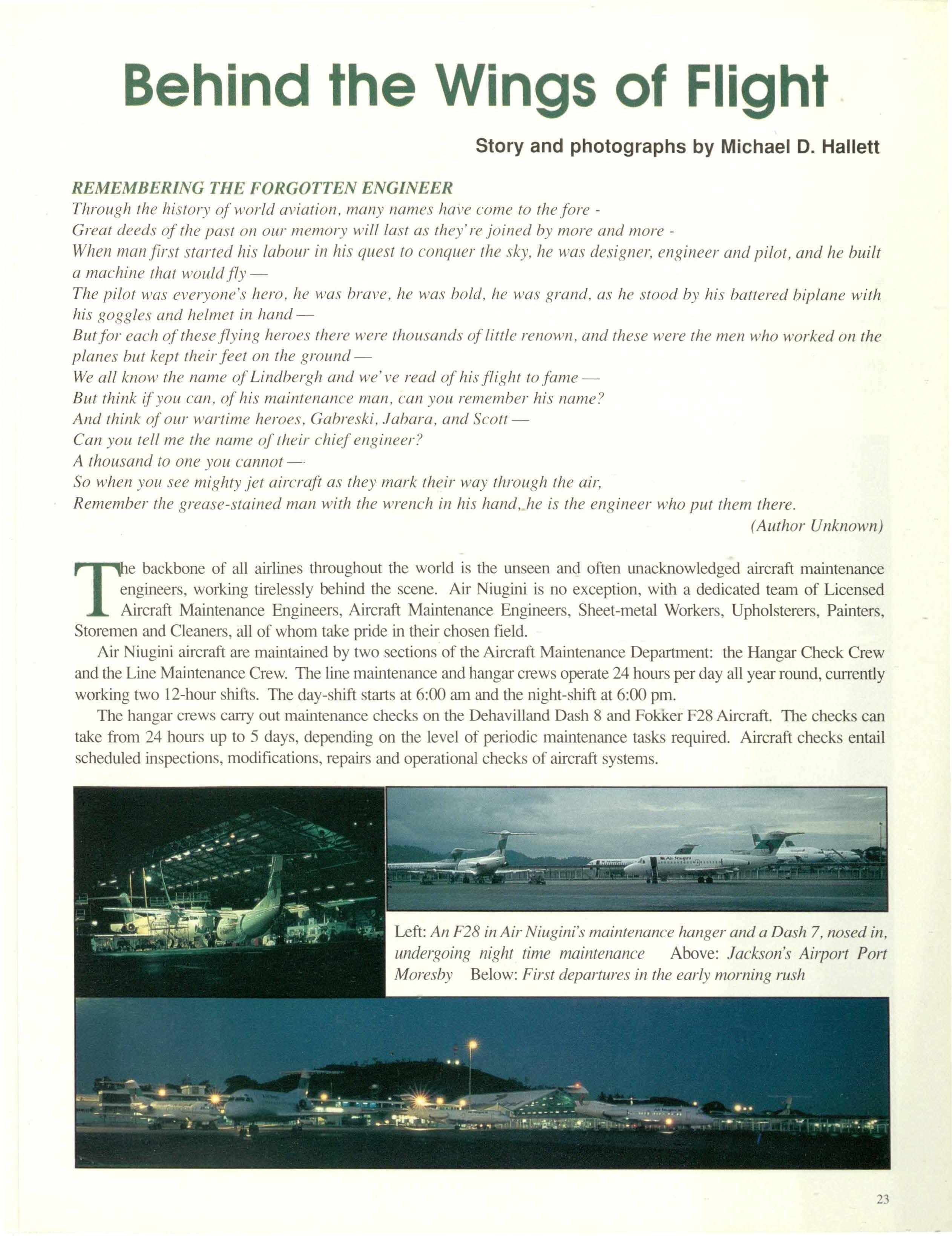
Behind the Wings of Flight
Story and photographs by Michael D. Hallett
REMEMBERING THE FORGOTTEN ENGINEER
Through the hi s tory of world aviation , man y names have come to the fore -
Great deeds of the past on our memory wi ll la st as they' re joined by more and more -
When man first sta rt ed his lab our in his quest to conquer the sky, he was designer, engineer and pilot , and he built a machine that would fly -
The pilot was el'eryone's hero, h e was brave, he was hold , he was g rand , as he stood by his battered biplane with his goggles and helmet in hand -
But for each of these flying heroes there were thousands of little renown, and these we re the men who worked on the planes hut kept their feet on the ground-
We all know the name of Lindbergh and we've read of his flight to fame -
But think if yo u can, of his maintenance man, can you remember his name ?
And think of our wartime heroes , Gahreski , Jabara, and Scott -
Can you tell me the name of their chief engineer?
A thousand to one you cannot- -
So when you see mighty jet aircraft as they mark their way throu gh the ai,~
R emember the grease-stained man with the wrench in his hand, he is the engineer who put them there.
(Author Unknown)
e backbone of all airlines throughout the world is the unseen and often unacknowledged aircraft maintenance ngineers, wor]cjng tirelessly behind the scene. Air Niugini is no exception, with a dedicated team of Licensed Aircraft Maintenance Engineers, Aircraft Maintenance Engineers, Sheet-metal Workers, Upholsterers, Painters, Storemen and Cleaners, all of whom take pride in their chosen field.
Air Niugini aircraft are maintained by two sections of the Aircraft Maintenance Department: the Hangar Check Crew and the Line Maintenance Crew. The line maintenance and hangar crews operate 24 hours per day all year round, currently wor]cjng two 12-hour shifts. The day-shift starts at 6:00 am and the night-shift at 6:00 pm.
The hangar crews carry out maintenance checks on the Dehavilland Dash 8 and Fokker F28 Aircraft. The checks can take from 24 hours up to 5 days, depending on the lev el of periodic maintenance tasks required. Aircraft checks entail scheduled inspections, modifications, repairs and operational checks of aircraft systems.
It is the responsibility of the line maintenance dayshjft engineers to provide a streamlined operation for the daily operations of the airline. Their goal is to ensure on-time departw·es by providing a smooth and quick service in performing their pre-flight inspections, refuelling and rectification of any aircraft defects. The hangar crew backs up and supports the line with help from the stores' personnel to supply urgent spare parts when needed.
From time to time unavoidable engineering or technical delays do occur. As defects occur, Engineering goes into full swing to rectify the problem in the quickest possible time, to avoid or limit the delay in the aircraft's departure. Line rectifications can be as simple as topping up engine oils to in-depth trouble shooting of an aircraft auto-pilot system.
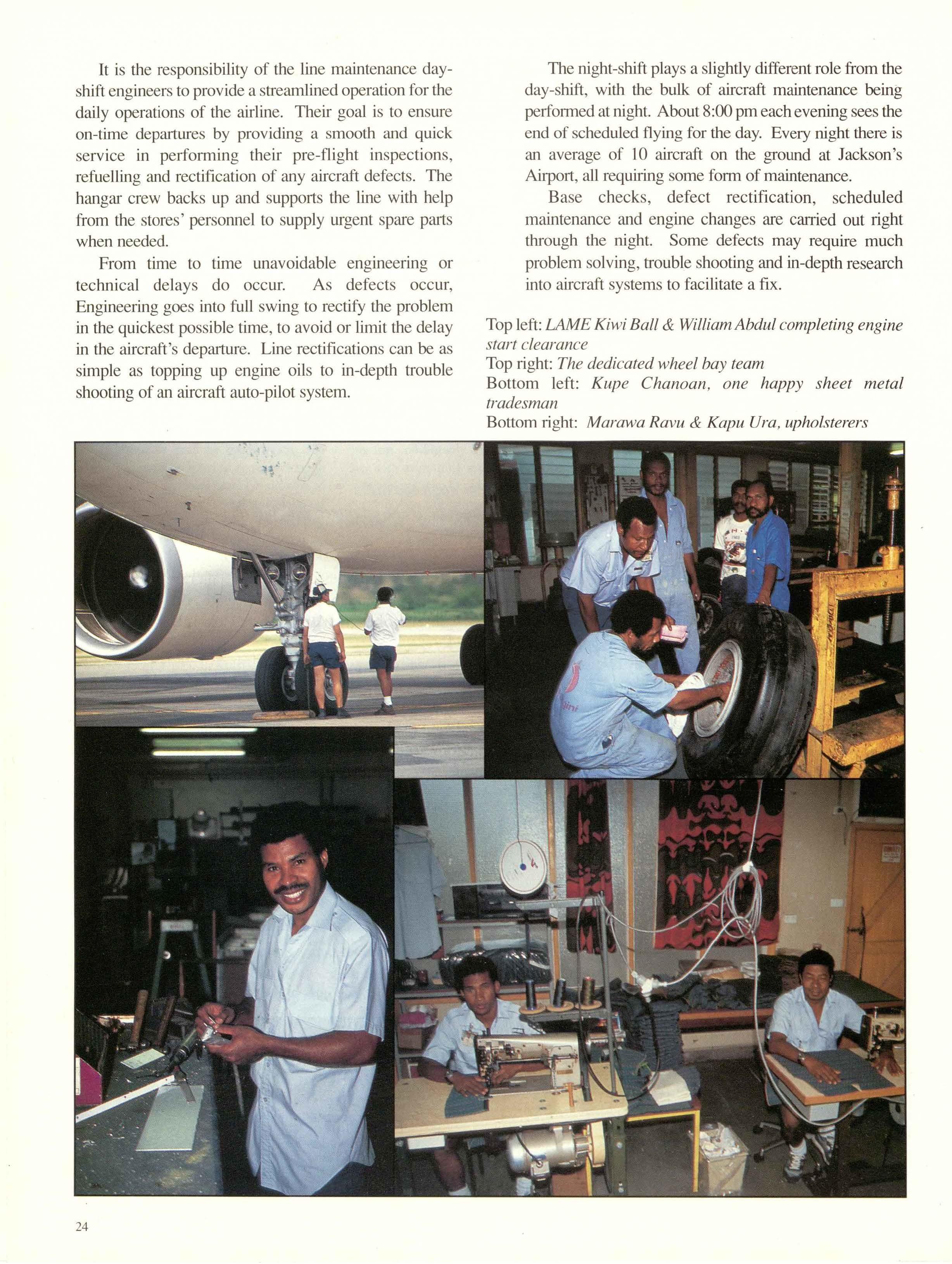
The night-shift plays a slightly different role from the day-sruft , with the bulk of aircraft maintenance being performed at night. About 8:00 pm each evening sees the end of scheduled flying for the day. Every night there is an average of 10 aircraft on the ground at Jackson's Airport, all requiring some form of maintenance. Base checks, defect rectification, scheduled maintenance and engine changes are carried out right through the night. Some defects may require much problem solving, trouble shooting and in-depth research into aircraft systems to facilitate a fix.
Top left: LAME Kiwi Ball & William Abdul completing engine start clearance
Top right: The dedicated wheel bay team
Bottom left: Kupe Chanoan, one happy sheet metal tradesman
Bottom right: Marawa Ravu & Kapu Ura, upholsterers
A career in aircraft engineering is no easy task and requires a special person to dedicate many years of training and hands-on experience. Both men and women can enter an apprenticeship with Air Niugini. The minimum age for entry is 18 and the minimum educational qualification Grade 12. Apprentices spend 4 years at the Qantas Jet Base at Mascot Airport in Sydney where they learn the fundamentals of aircraft engineering and maintenance requirements of various aircraft systems They also undertake theory of aircraft maintenance courses at a TAFE College.
Top left: Kapu Ura, Marawa Ravu, Patoro Mahaie, Sugar Ray, Luscomb Auro & Rario Veali, the upholste,y shop team
Top right: Joyce Wal, the first Papua New Guinean female aircraft engineer
Bottom left: LAME John Pidik working on the PW Spey engine.fitted to the Fokker F28
Bottom right: Karen Napo, Kathy Hove, Jean Koney & Judy Amon meticulously clean inside and outside the aircraft.
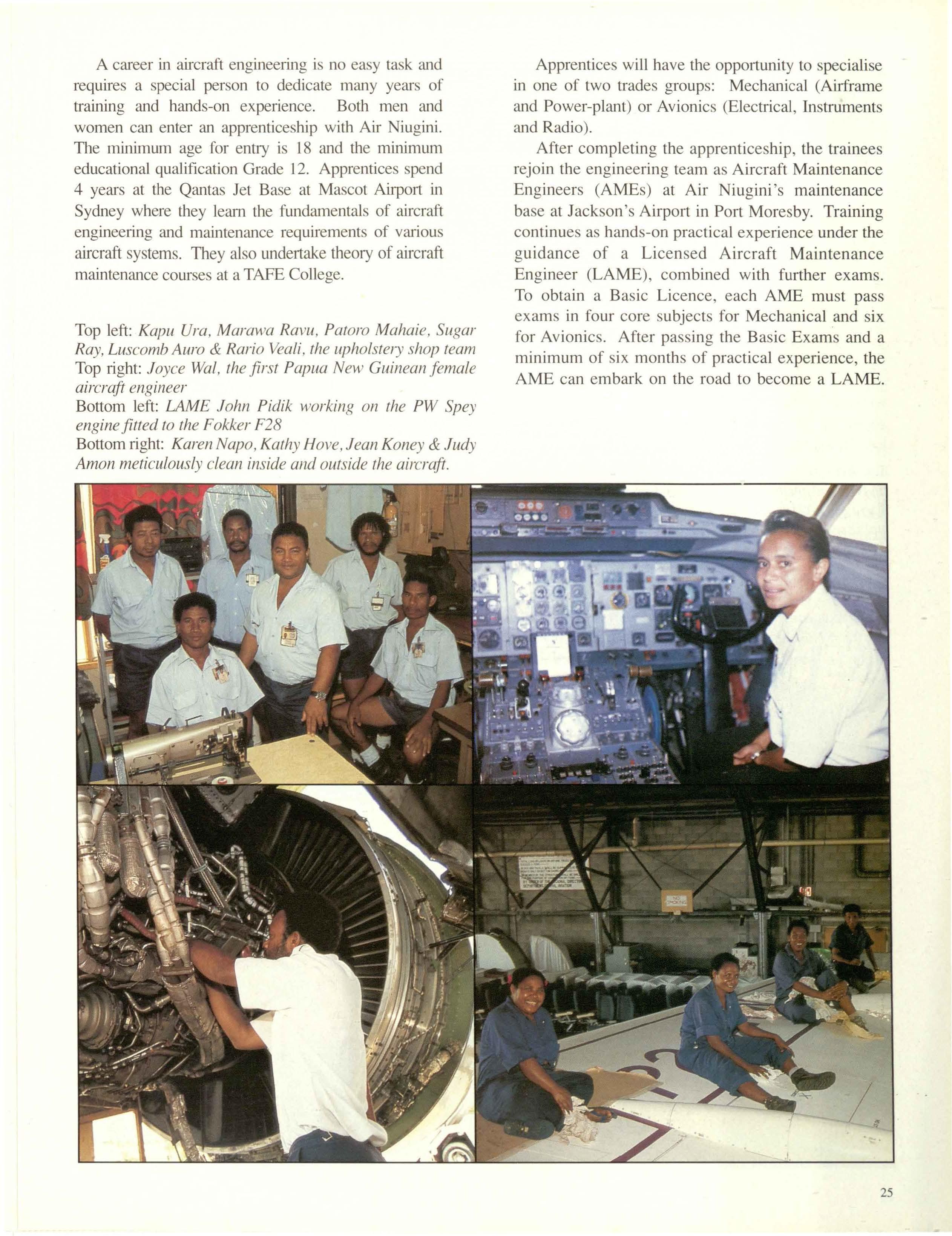
Apprentices will have the opportunity to specialise in one of two trades groups: Mechanical (Airframe and Power-plant) or Avionics (Electrical, Instruments and Radio).
After completing the apprenticeship, the trainees rejoin the engineering team as Aircraft Maintenance Engineers (AMEs) at Air Niugini's maintenance base at Jackson's Airport in Port Moresby. Training continues as hands-on practical experience under the guidance of a Licensed Aircraft Maintenance Engineer (LAME), combined with further exams. To obtain a Basic Licence, each AME must pass exams in four core subjects for Mechanical and six for Avionics. After passing the Basic Exams and a minimum of six months of practical experience, the AME can embark on the road to become a LAME.
For the Mecharucal licence, there are nine more exams, making thirteen in total. For the Electrical-Instruments strand of Avionics, there are eight more exams, making a total of fourteen. To obtain a full Avionics Licence with Radio qualifications as well, the engineer must sit thirteen more exams , making twenty-seven in all. In addition the engineer must attend aircraft type courses. Each AME must pass a type course and have sufficient hours of practical experience logged to satisfy the requirements of the Depaitment of Civil Aviation before being granted a licence. This licence allows an engineer to certify for maintenance for a patticular aircraft type and to supervise and train other AMEs.
Becoming a Licensed Aircraft Maintenance Engineer thus involves many years of hard work and experience. The minimum amount of time for people with aptitude and diligence is approximately three years. For some, it can take up to ten years to finish the LAME requirements.
Top left: Quality Assurance , Canisius Lang carrying out an NDT inspection of an F28 main wheel rim
Top right: AME Daniel Sioni inspecting the horizontal stabiliser ofan F28

Training does not stop with becoming a LAME: it is on-going throughout the engineer's career. With the introduction of new aircraft come new advances in technology. As a consequence, engineers can look forward to many hours of class room training followed by months or sometimes years of practical hands-on experience before qualifying for upgraded licences. Each type of aircraft carries its own rating for which an engineer must be certified. The licence required to be certified for an Airbus, for example, is much more difficult than for a Twin Otter or even Dash 8. So when you step aboard an Air Niugini aircraft, spare a thought for the people who make it all possible. On the occasion you may experience a technical delay, be patient as your safety is of prime concern.
Mike Hallett worked for Air Niugini as an aircraft engineer and now lives in New Zealand.
Bottom: Early morning fog envelops the tarmac during preparations for F28 departures.
MUSt,UM .Nt,WS
An Introduction to the J.K. McCarthy Museum
11
e J.K. McCarthy Museum is located in Goroka, the capital of Eastern Highlands Province. The Museum, which is a branch of the National Museum in Port Moresby, was established in the 1960s and is named after John Keith McCarthy (photo on right), a distinguished pioneer in the Australian colonial administration. McCarthy was a Member of the Legislative Council, Deputy Speaker of the House of Assembly and a Trustee of the National Museum. His donation of 64 artifacts from his own collection formed the foundation of the collections held by the museum in Goroka which was subsequently named after him.
The construction of the J.K. McCarthy Museum was initiated by the Rotary Club of Goroka in 1965. The cause was then taken up by the Eastern Highlands Agricultural Society which made land available on the Society's showgrounds. Additional support was obtained from the Goroka Local Government Council and the National Museum.
The museum building was designed to reflect traditional Eastern Highlands architecture. Four round houses are joined together to form the museum building which includes six public galleries, storage rooms, office space and a book store and handicraft shop. Construction began in
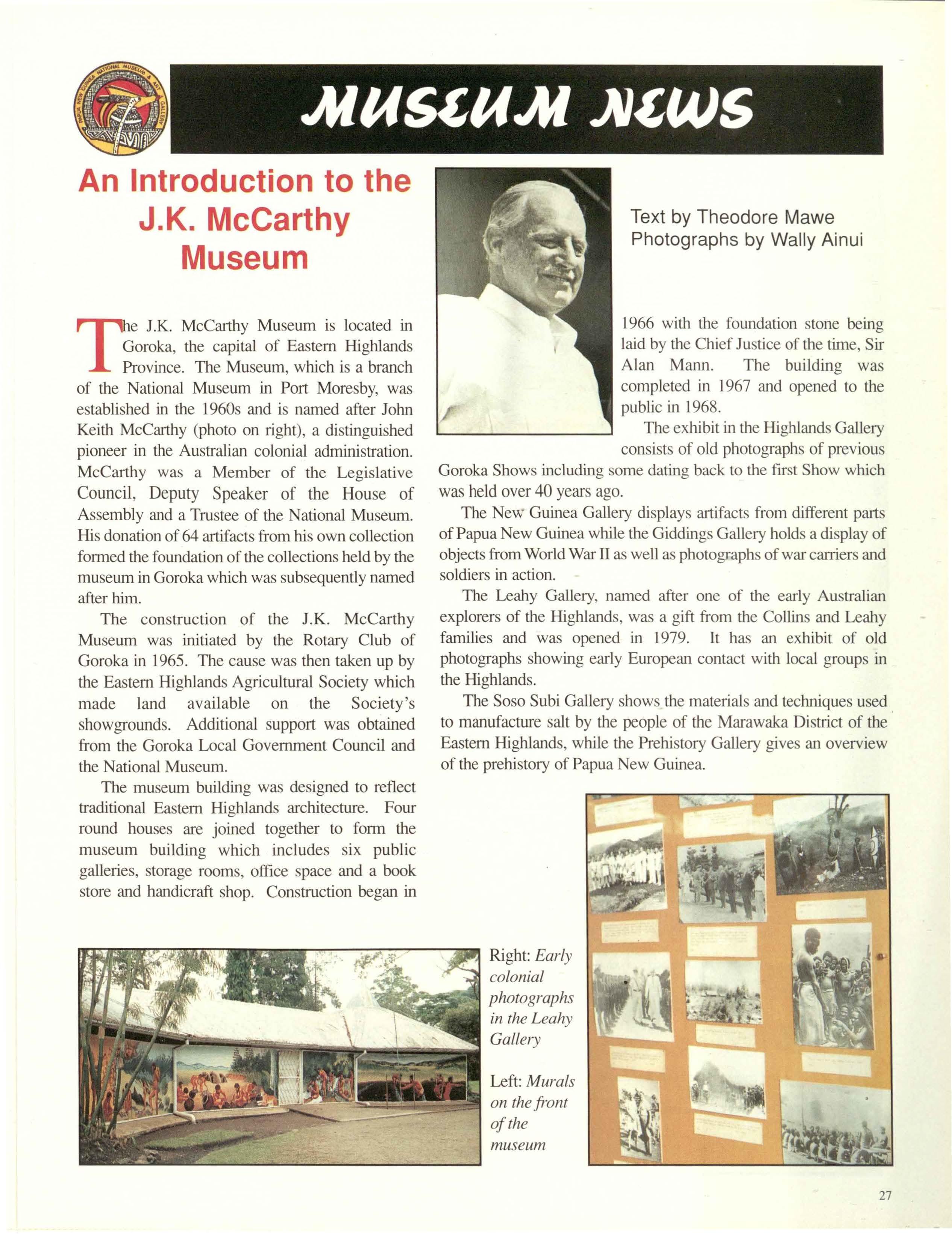
Text by Theodore Mawe Photographs by Wally Ainui
1966 with the foundation stone being laid by the Chief Justice of the time, Sir Alan Mann. The building was completed in 1967 and opened to the public in 1968.
The exhibit in the Highlands Gallery consists of old photographs of previous Goroka Shows including some dating back to the first Show which was held over 40 years ago.
The New Guinea Gallery displays artifacts from different parts of Papua New Guinea while the Giddings Gallery holds a display of objects from World War II as well as photographs of war carriers and soldiers in action.
The Leahy Gallery, named after one of the early Australian explorers of the Highlands, was a gift from the Collins and Leahy families and was opened in 1979. It has an exhibit of old photographs showing early European contact with local groups in the Highlands.
The Soso Subi Gallery shows the materials and techniques used to manufacture salt by the people of the Marawaka District of the Eastern Highlands, while the Prehistory Gallery gives an overview of the prehistory of Papua New Guinea.
Right: Early colonial photographs in the Leahy Gallery
Left: Murals on the front of the museum
Above: World War II ai,plane in the yard of the Museum. The National Sports Institute and the Goroka Showgrounds are in the background.
Above right: Display of musi c al instruments in the Giddings Gallery
Below: Potte1y in the Soso Subi Galle,y

school children and is an active participant in the Goroka Show which is held in September each year. During the 1996 Goroka Show, the Museum organised a traditional salt making demonstration by people from Marawaka.
The J.K. McCarthy Museum is --...::!Ill looking to improve its ability to
The Museum's bookshop sells a variety of books and handicrafts. The sale of these items supplements the annual grant received from the National Museum.
The J.K. McCarthy Museum assists the National Museum -=-"m its efforts to preserve and protect Papua New Guinea's natural, cultural and historical heritage; to educate the general public about the heritage; and to administer the National Cultural Property (Preservation) Act. It is also involved in collecting and preserving objects of cultural, natural and historical significance. The Museum has a programme of visits from local
carry out research and make the research results available to the public. It is also hoped to enlarge the building and expand the library and photographic archive.
Next time you are in Goroka spend an hour or two at the J.K. McCarthy Museum. It is located at the Goroka Showgrounds at the comer of Morchhauser and Makinono Streets.
Opening hours: 8am - 4pm - Monday to Friday; 2pm - 4pm - Saturday; 10am -12noon -Sunday. For more information, contact the Chief Curator on 732 1502.
AirNiugini Reet

Fokker RB183-15H
Fokker RB183-15
Accommodation & FREE car hire
Gateway Hotel
The Gateway is a natural hotel to get away from it all; and for business a great place to get it all together. From the moment you arrive at the Gateway Hotel, we have a total commitment to giving you extra care in every way with our friendly efficient staff. Chefs dedicated to presenting the best of local cuisine. Cool air-conditioned rooms, with all the modern convenience.
Lush gardens, pools and other amenities, but most of all our friendly "extra caring" people to make your stay perfect.
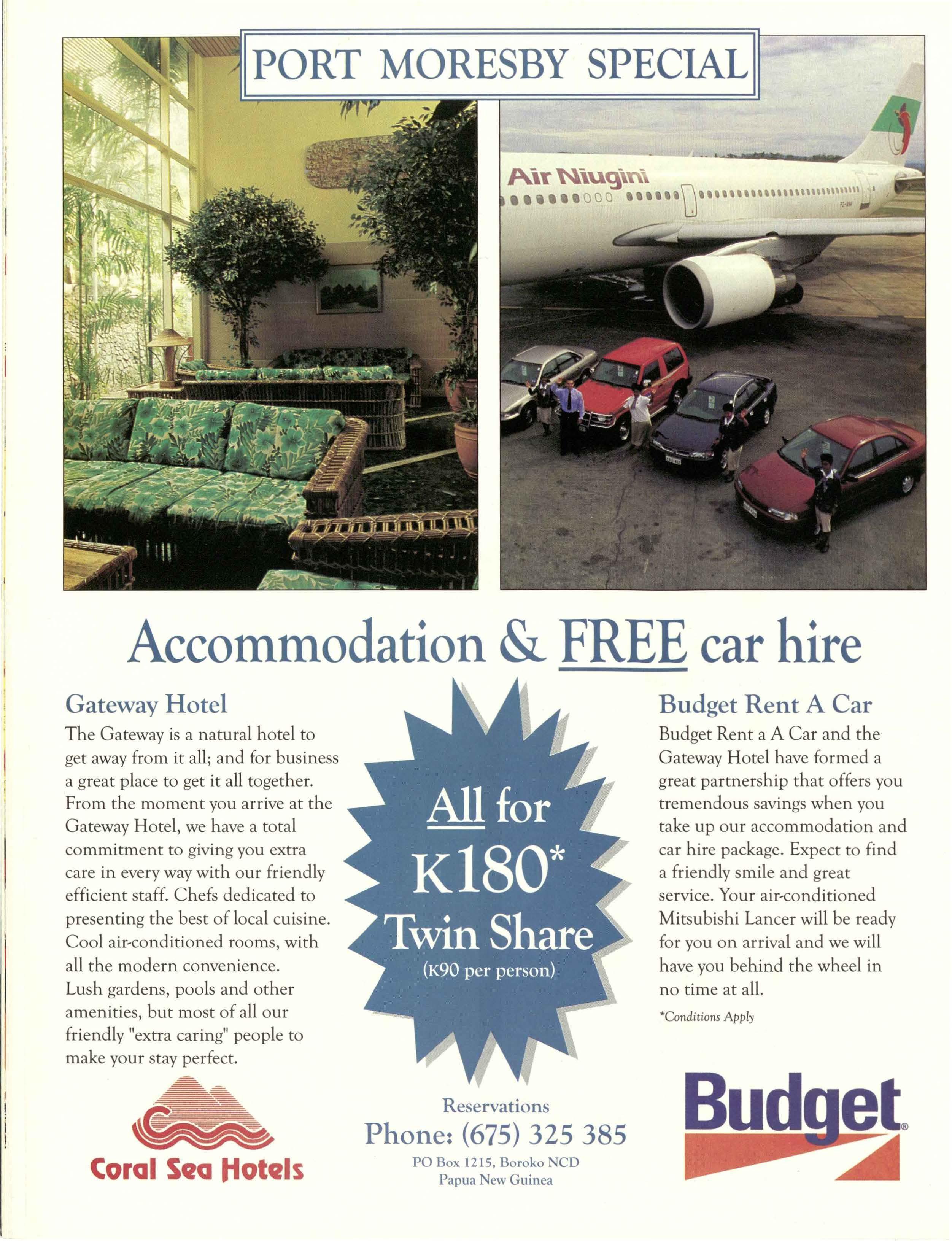
Budget Rent A Car
Budget Rent a A Car and the Gateway Hotel have formed a great partnership that offers you tremendous savings when you take up our accommodation and car hire package . Expect to find a friendly smile and great service. Your air-conditioned Mitsubishi Lancer will be ready for you on arrival and we will have you behind the wheel in no time at all.
*Conditions Apply
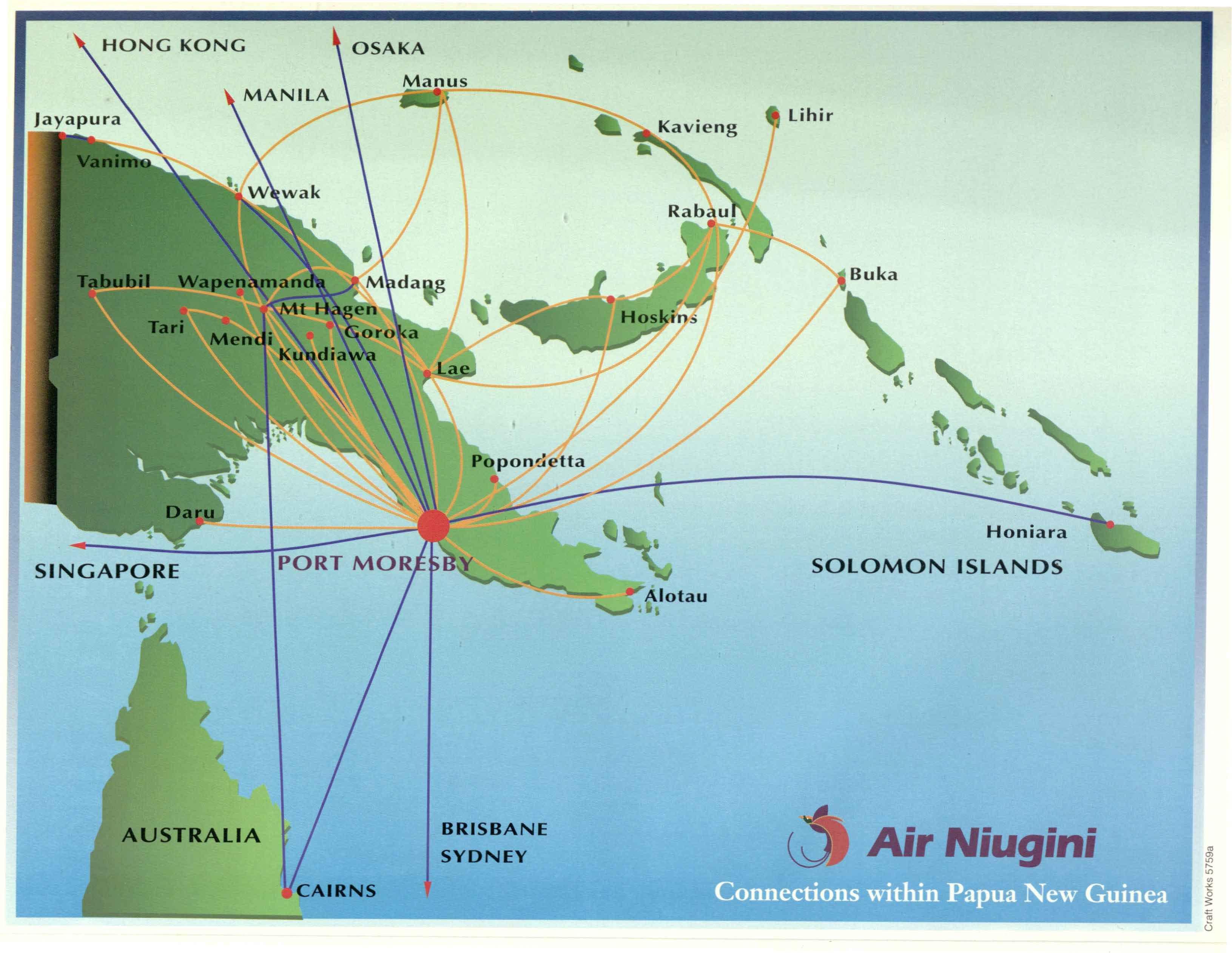
AUSTRALIA BRISBANE SYDNEY
SOLOMON ISLANDS
Air Niugini
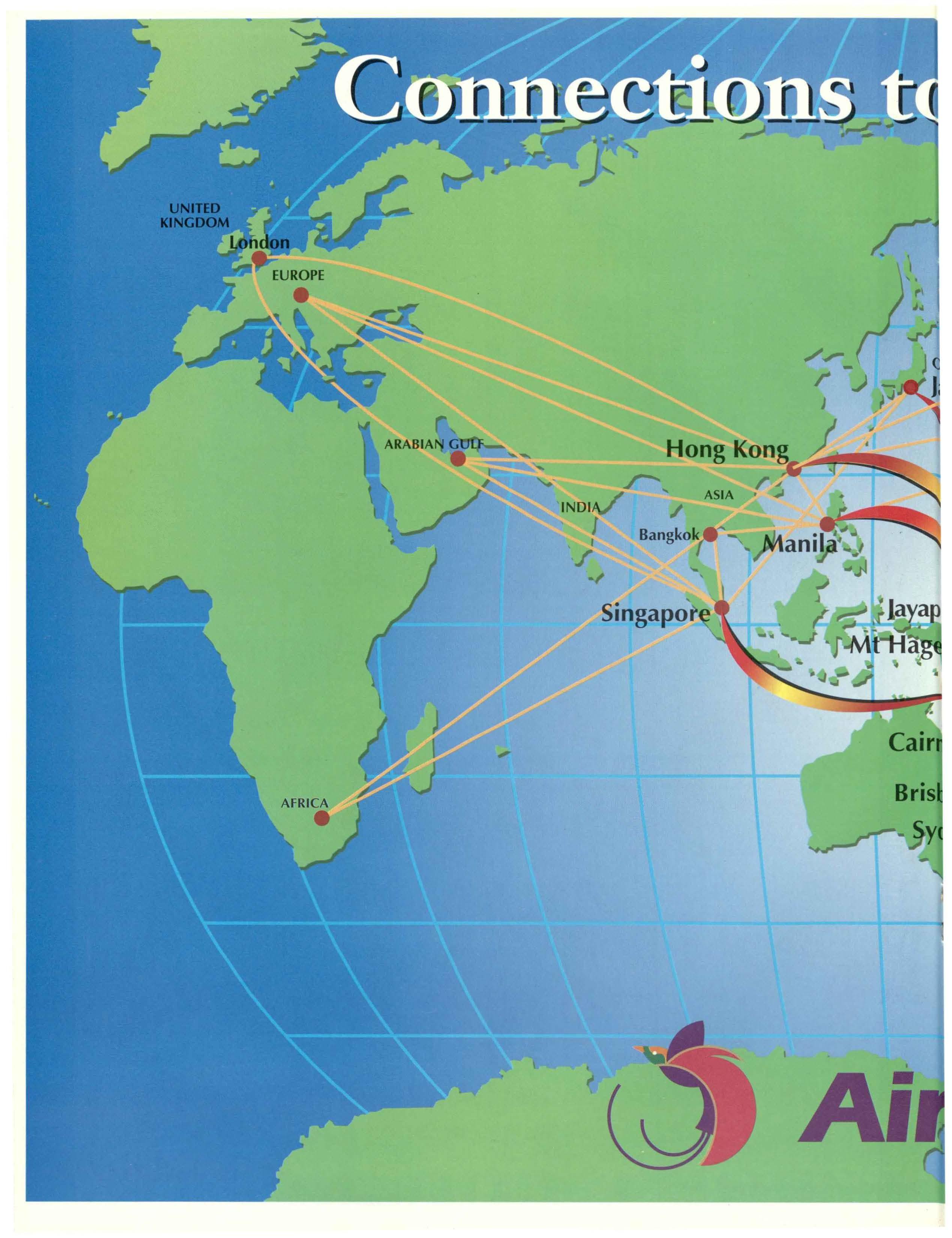
ASIA
INDI I I / Bangko ~ .; Singapore
AFRICA

NEW ZEALAND
Air Niugini INTERNATIONAL OFFICES
BRISBANE
99 Creek Street
GPO Box 2216
BRISBANE QLD 400 I
AUSTRALLA
Tel: (61 7) 32211544
Fax: (61 7) 32200040
CAIRNS
Shop 2 Tropical Arcade
4-6 Shields Street
CAJRNS QLD 4870
AUSTRALIA
Tel: (61 70) 514950
Fax: (61 70) 313402
MELBOURNE
12th Level
520 Collins Street
MELBOURNE VIC 3004
AUSTRALIA
Tel: 131380
Fax: (61 3) 94173355

SYDNEY
Somare Hou se
100 Clarence Street PO Box 5293
SYDNEY NSW 200 1
AUSTRALIA
Tel: (61 2) 92901544
Fax: (61 2) 92902026
HONIARA PO Box 677
HONIARA
SOLOMON ISLANDS
Tel: (677) 22895
Fax: (677) 24025
FRANKFURT
Waidmann s tr 45
60596 FRANKFURT
GERMANY
Tel: (49 69) 634095
Fax: (49 69) 6313332
GENERAL SALES AGENTS
PORT VILA
Va nuatu Travel Services Ltd
PO Box 27
PORT VILA
VANUATU
Tel: (678) 22836
Fax: (678) 23583
AUCKLAND
Walshes World (NZ) Ltd
2nd Floor, Dingwall Building
87 Queen Street
AUCKLAND
NEW ZEALAND
Tel: (64 9) 3793708
Fax: (64 9) 3022420
SEOUL
Sharp Inc
7th Floor, lnjoo Bld g
Seolin-Dong
CHONG-KU , SEOUL
SOUTH KOREA
Tel: (82 2) 7347100
Fax: (82 2) 7347108
TAIPEI
World Express Inc
3rd Floor, World Express Bldg
90 Chien-Kuo North Road
Section 2 -TAIPEI TAIWAN
REPUBLIC OF CHINA
Tel: (886 2) 5033030
Fax: (886 2) 5071734
DOMESTIC SALES OFFICES
PORT MORESBY
Ground Floor NIC Hou se
Champion Parade PO Box 7186
BOROKO PNG
Tel: (675) 321 2888
Fax: (675) 321 3651
WAIGANI
Ground Floor
Central Government Offices
PO Box 7186
BOROKO PNG
Tel: (675) 325 1055
Fax: (675) 325 3683
BOROKO
Ground Floor Garden City PO Box 7186
BOROKO PNG
Tel: (675) 325 9084
325 3541
Fax: (675) 325 3614
LAE
PO Box 237
LAE PNG
Tel: (675) 472 1892
Fax: (675) 472 4758
TOKYO
5th Floor Sunbridge
Ogawamachi Building 2-2 Kanda Og awa machi
CHJYODA-KU, TOKYO
JAPAN 101
Tel: (81 3) 52810444
Fax: (81 3) 52810445
SINGAPORE
10 l Thomson Road
#01-05/06 United Square
SINGAPORE 1130
Tel: (65) 2504868
Fax: (65) 2533425
HONG KONG
Rm 705 Century Square 1-13 D'Aguilar Street
CENTRAL HONG KONG
Tel: (852 5) 242151 /2
Fax: (852 5) 267291
KUALA LUMPUR
Pelancogan Abadi Sdn Bhd
79 Jalan Bukit Bintang
55100 KUALA LUMPUR
MALAYSIA
Tel: (60 3) 2424311
Fax: (60 3) 2412322
BANGKOK
Abadi Express (1966) Co Ltd
Room 548, 5th Floor, Kase mkij Building 120 Silom Road
BANGKOK 10500 THAILAND
Tel: (66 2) 6327396 / 97 / 98 / 99
Fax: (66 2) 6327393
MADANG
PO Box 140
MADANG PNG
Tel: (675) 852 2699
Fax: (675) 852 2849
RABAUL
PO Box 120
KOKOPO PNG
Tel: (675) 982 9033
Fax: (675) 982 9052
LIHIR ISLAND
PAPUA NEW GUINEA
Tel: (675) 986 4008
Fax: (675) 986 4032
MANILA
Fortune Office Building G/F
160 Lega sp i Street
Legaspi Village
MAKATI CITY
PHILIPPINES
Tel: (63 2) 8913339 /40 /41
Fax: (63 2) 8913393
LOS ANGELES
5000 Birch Street
Suite 3000 West Tower
NEWPORT BEACH
LOS ANGELES
CALIFORNIA 92660 USA
Tel: (1 714) 7525440
Fax: (1 714) 4763741
JAYAPURA
PT Kuwera Jaya
JL A Yani No. 39
JAYAPURA
!RIAN JAYA
Tel: (62 967) 21427
Fax: (62 967) 32236
JAKARTA
PT. Ayuberga
Wisma Bumiputera
Jalan Jenderal, Sudirrnan Kva 75 JAKARTA 13910 INDONESIA
Tel: (62 21) 5780615 / 5780628 /5780654
Fax: (62 21) 5713013
ALOTAU PO Box 3
ALOTAU PNG
Tel: (675) 641 1100
Fax: (675) 6411636
GOROKA
PO Box 683
GOROKA PNG
Tel: (675) 732 1444
Fax: (675) 732 1489
MT HAGEN
PO Box 3
MTHAGEN PNG
Tel: (675) 542 1444
Fax: (675) 542 1423
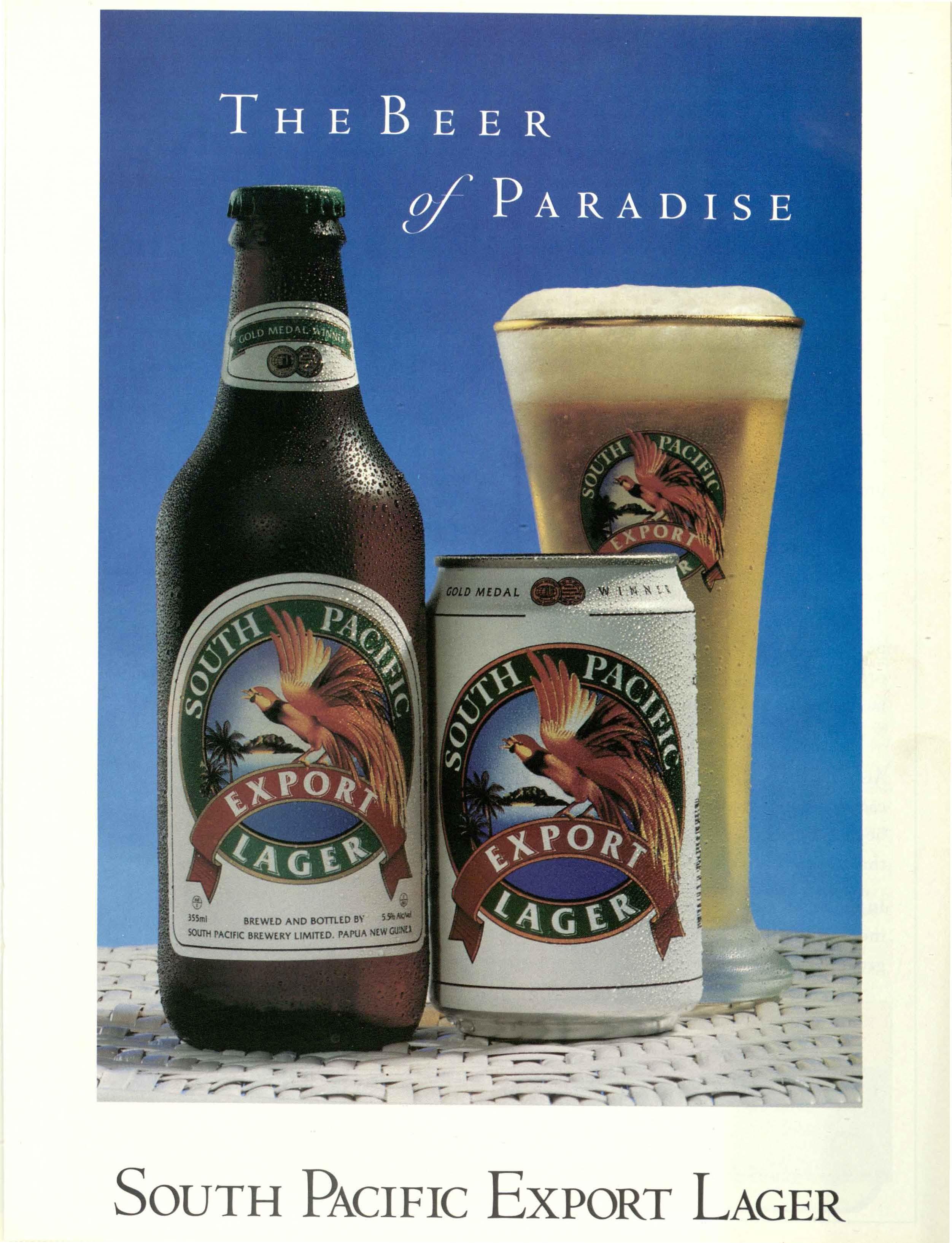
The Changing Face of Papua New Guinea

This is our promise in answer to the unique demands of Papua New Guinea that requires new transport products ranging from the revolutionary Trident 20 polyethylene boat to the heaviest specialist truck.
To service our customers we have a network of nine locations which offers service, replacement parts, mechanical and body panel repairs that is second to none.
Also we are the country's number one used car dealer, our reputation and position has been achieved by offering quality vehicles that are prepared in our own workshops.
In the end it is people who generate change and meet challenges and we believe they are our greatest asset.
" C hange generates challenges that we continue t o meet."
of TERRY
Story by Myles Mcivor Photographs by Chris Higgins and Terry Saleh

rry Saleh left Papua New Guinea more than 20 years ago. He landed in Queensland 's capital Brisbane with five kina to his name. This year he returns to his homeland as one of Australia's most prolific and popular artists. He will bring with him a feeling for various cultures and a yearning to be reunited with his past.
In June as well as his paintings and artifacts Terry will bring to Papua New Guinea, Aboriginal artist and didgeridoo player Michael Connolly whom he has taken under his wing. The Aboriginal and Papua New Guinean cultures will comb in e on this month-long tour, Terry says. I
see this tour as breaking cu ltural barriers. We want to show my homeland how both c 1tltures can intermingle. There are a lot of common themes between Aboriginal and Melanesian cu ltur es. An accomplished didgeridoo player, Terry says, Some Papua New Guinean tribes have similar in struments to the didgeridoo.
Terry's mixed parentageMalay/Indonesian and Papuan/lndian - has given him an appreciation of different cultures which has in turn influenced his creative work. / was brought up in th e bush and some ofmy work has a distinct Papua New Guinean flavour. However, he also
feels a close affinity to the cultures and lifestyles of Australia's original inhabitants.
As to his nationality, Terry doesn't care what he is called. An Australian citizen, he still looks upon Papua New Guinea as his home. / love Australia. It is an exce ll ent place to work as an artist as I can do what I like and travel anywhere. There has been a lot of negative publicity about Papua New Guin ea , that's why 1 want to show something positive. I hope to inspire some of the young people.
Top left: Terry inside the Gallery which features, pottery, Australian themed oil paintings, bush and kangaroo skin art
Top right: Handcrafted painted pottery platter
Below left: Kangaroo skin art burnt in with a hot iron
Below right: Terry's Gallery at North Pine Counrry Park, Da yboro R oad, Kwwongba
Above left: Bullocky 1 from th e Colonial Work s collection of oil paintings
Above right: Purelko, an Australian Aboriginal Dreamt im e print
Far right top: Handcrafted and handpainted plates, emu eggs and jewelle,y
Far right middle: Kangaroo skin-art framed/unframed
Far right botom: Handpainted paper-bark art
One ofmy memories from Papua New Guinea is my grade six certificate signed by my teacher Paulus Arek, later a Member of Parliament. H e wrote that this student would becom e an artist in the future. That was handwritten while the rest of th e report, which contained fairly ordinary marks, was printed.
The boy from Popondetta has matured into a man who has seen the world but stilJ wants to be among his people. Although his immediate family of five brothers, three sisters and his parents have moved to
Australia, Terry will visit this coastal town which gained its place in history as the beginning of the famous Kokoda Trail in World War II.
This is th e first tim e I have been home since I left in 1975 After my country gained its independence, I came to Brisbane as a 21-year-old with my cousin whom I had convinced to quit his C!ffice job. We looked up a friend's address in the phone book and caught a taxi there. We couldn't convince the driver to accept th e five kina so I had to knock on doors in the neighbourhood before a lady offered to lend me the cab fare until I got my money changed.
Basic steps on learning to play the Didgeridoo videos
Below: Terry playing the didgeridoo on a school tour
Right: Aboriginal artist & didgeridoo player Michael Connolly and Terry Saleh

Now, art connoisseurs throughout Australia and overseas come knocking on Terry's door. His art transcends notmal boundaries as he portrays the legends and lifestyles of Aboriginals and the way of life of the pioneer European settlers of the coastal and outback regions. His striking Dreamtime works arouse the most interest with limited edition prints the subject of keen bidding. All this from a man who did not start sketching until 15 years ago when his mother handed him a book on the Dreamtime. He had been working as a clerk in the Maintenance Section of the Education Department
Above: Handpainted pottery
Film Centre or picking up odd jobs such as washing dishes in hotels.
Terry's first artistic break came in 1988 with a six-month stint at the Australian Pavilion in the World Expo at Brisbane where he staged demonstrations of his charcoal and pencil sketches. He broadened his horizons by taking holidays in Queensland 's wide open spaces, travelling to Tropical Daintree and Cairns where he exhibited his works. This led to a Canadian contact who convinced him to exhibit internationally at the 1991 Calvary Exhibition and Stampede.
It's my destiny I told my wife Jani ce, Terry says of the offer. I said I've got to go. I hunted up sponsorship and went.
From there came trips to Germany, Japan and Britain. Terry works seven

days a week, maintaining a schedule of market appearances and private commissions as well as speaking engagements tv schools, colleges and universities. Apart from traditional prints, sketches and drawings, Terry also produces stained glass art, water colours, charcoal and chalk sketches, hand-printed t-shirts , leather craft and oil paintings from his home studio and gallery at North Pine Country Park on Brisbane's northern outskirts. He has moved into other fields with a video on how to play the didgeridoo , a CD of didgeridoo music and two tapes. He has expanded to kangaroo skin artwork , burning etches onto skins highly prized by American and Canadian buyers. He also makes bush furniture , giving him fewer hours to spare as he also tries to make as many trips into the Australian bush as
possible. His most cha llen ging commission was the giant artwork he created for the first Gold Coast Indy Car Grand Prix in 1991. The 22-metre design took many hours of hard work to complete and was strapped across a pedestrian bridge in Surfers Paradise for the three-day event which was televised throughout the world.
Keeping control of my work has paid off, says Terry. I have seen some artists se ll the rights to their works quite cheaply and then have them mass reproduced at a massive profit to the othe r party I have been very lu cky that my works have not been pirated.
Terry, who has painted so me scenes of his homeland from memory, (examples shown below ) intends to paint more during his tour of Port Moresby and the major regional centres.
Left: Spirit of Paradise
Right: Orokaivan mourning
Left: Mudmen
Right: Baining fire walkers
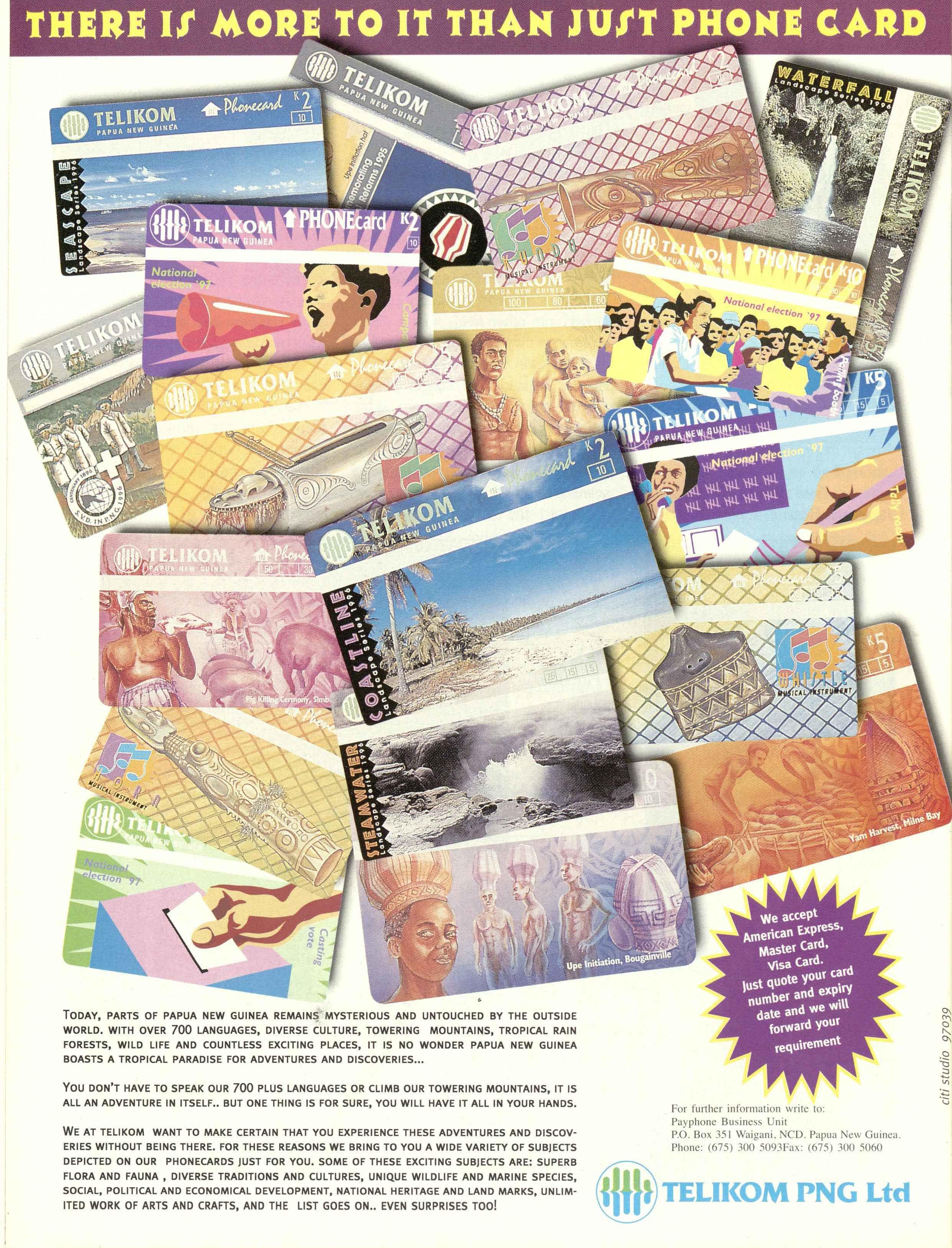
TODAY, PARTS OF PAPUA NEW GUINEA REMAIN~t MYSTERIOUS AND UNTOUCHED BY THE OUTSIDE WORLD. WITH OVER 700 LANGUAGES, DIVERSE CULTURE, TOWERING MOUNTAINS, TROPICAL RAIN FORESTS, WILD LIFE AND COUNTLESS EXCITING PLACES, IT IS NO WONDER PAPUA NEW GUINEA BOASTS A TROPICAL PARADISE FOR ADVENTURES AND DISCOVERIES
You DON'T HAVE TO SPEAK OUR 700 PLUS LANGUAGES OR CLIMB OUR TOWERING MOUNTAINS, IT IS ALL AN ADVENTURE IN ITSELF BUT ONE THING IS FOR SURE, YOU WILL HAVE IT ALL IN YOUR HANDS
WE AT TELIKOM WANT TO MAKE CERTAIN THAT YOU EXPERIENCE THESE ADVENTURES AND DISCOVERIES WITHOUT BEING THERE. FOR THESE REASONS WE BRING TO YOU A WIDE VARIETY OF SUBJECTS DEPICTED ON OUR PHONECARDS JUST FOR YOU. SOME OF THESE EXCITING SUBJECTS ARE: SUPERB FLORA AND FAUNA, DIVERSE TRADITIONS AND CULTURES, UNIQUE WILDLIFE AND MARINE SPECIES , SOCIAL, POLITICAL AND ECONOMICAL DEVELOPMENT, NATIONAL HERITAGE AND LAND MARKS, UNLIMITED WORK OF ARTS AND CRAFTS, AND THE LIST GOES ON EVEN SURPRISES TOO!
Lihir Island During the Gold Exploration Times
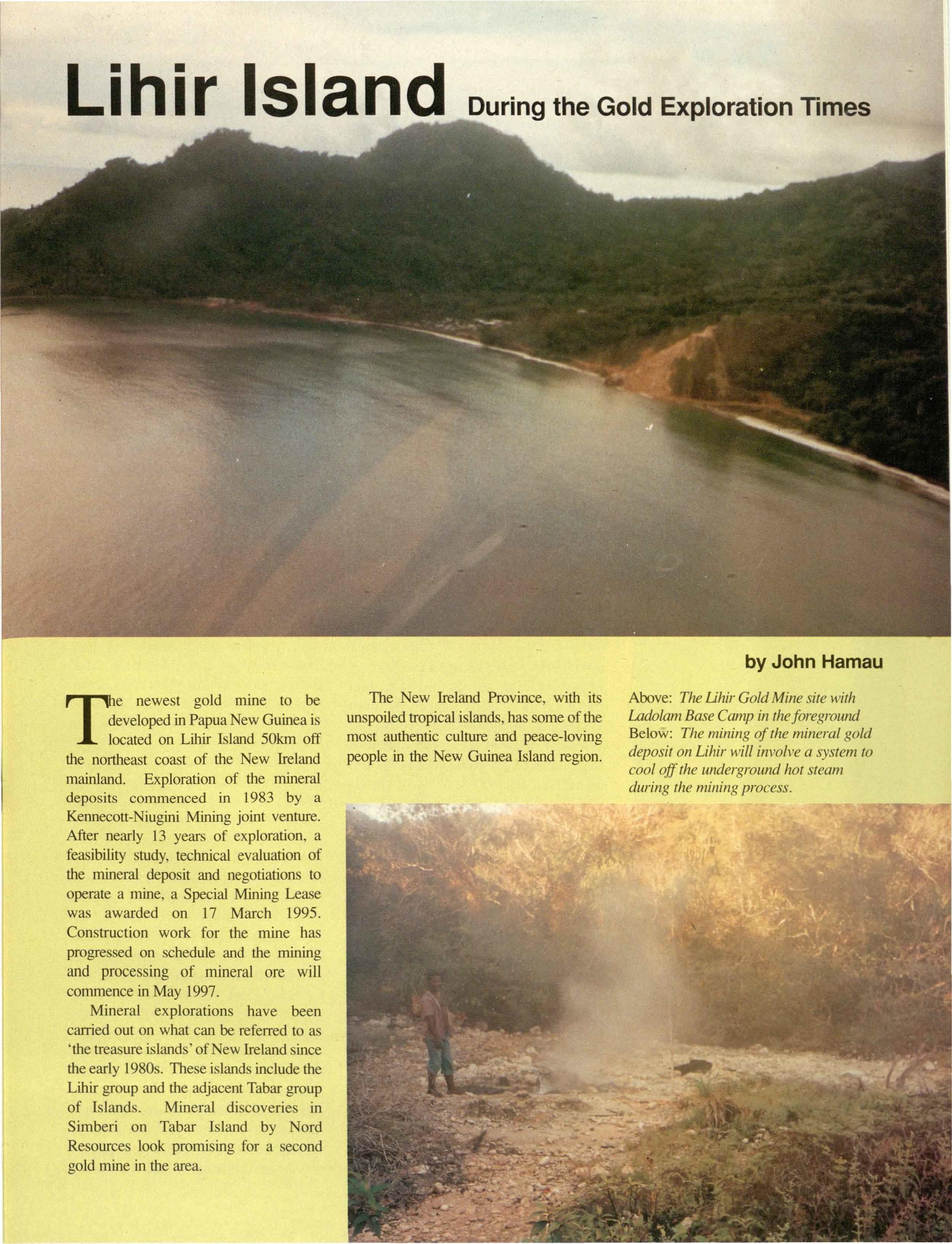
e newest go ld mine to be developed in Papua New Guinea is ocated on Lihir Island 50km off the northeast coast of the New Ireland main land. Exp loration of the mineral deposits commenced in 1983 by a Kennecott-Niugini Mining joint venture.
After nearly 13 years of exploration, a feasibility study, technical evaluation of the mineral deposit and negotiations to operate a mine, a Special Mining Lease was awarded on 17 March 1995. Construction work for the mine has progressed on schedule and the mining and processing of mineral ore will commence in May 1997.
Mineral explorations have been carried out on what can be referred to as 'the treasure islands' of New Ireland since the early 1980s. These islands include the Lihir group and the adjacent Tabar group of Islands. Mineral discoveries in Simberi on Tabar Island by Nord Resources look promising for a second gold mine in the area.
The New Ireland Province, with its unspoiled tropical islands, has some of the most authentic culture and peace-loving people in the New Guinea Is land region.
by John Hamau
Above: The Lihir Gold Mine site with Lado/am Base Camp in the foreground
Below: The mining of the mineral gold deposit on Lihir will involve a system to cool off the underground hot steam during the mining process.
Above: Three young men dressed to dance a traditional Lihir dance
Below: A typical New Ireland Hausboi enclosed by a stone fence. Traditional feasts are held inside the Hausboi.
A three-hour trip down the 300 km Boluminski Highway from Kavieng to Namatanai gives the visitor exciting views of rows of swaying coconut pahns , crystal clear rivers, lagoons and fascinating coastal villages.
Both Lihir and Tabar Islands are part of the Namatanai Open Electorate. The

need for close administrative involvement with the mining activities on the island ended Lihir's formal administration from Namatanai in 1990 when it attained District status of its own Tabar island is administered from Konos Patrol Post in central New Ireland.
From the 1960s to the 1980s
Government officers made regular patrols to the outer islands using government traw lers based at Namatanai. Nowadays, patrols can be made by scheduled daily flights or chartered planes or helicopters from Tokua.
During exploration, geologists and company staff flew to and from Lihir Island either by helicopter or by twinpropelled small aircraft that operate to Kunaiye airstrip. Since there were no roads around the island visitors soon got used to jumping off dinghies on to the beach and walking along stretches of sandy beaches to reach their destination.
One of the company's priorities after settling on the island was to connect Lihir to the outside world by telephone and television reception. The telephone transmitter located on the highest peak of the island is maintained by Telikom. Always covered with clouds, even at 10am this peak can be extremely cold and reminds one of the ridges in the Chimbu Province. During exploration the company communicated with the outside world by telephone , facsimile, HF and VHF radio.
The large TV tracking dishes on the mine site give the wondering villager a sneak preview of something they have never seen in their lifetime. Most evenings after having a first class dinner, staff can relax with a chink and watch any television progran1 that is being viewed in Port Moresby.
A visitor to the mine project finds on arrival at Ladolam Base Camp that the base is open and without fences. All company staff dwell in similar huts and dine in a central mess situated only a few meters from the waterfront of the Luise Harbour. The cool and relaxed atmosphere reminds visitors of the postWorld War II times when Australian exservicemen came to New Guinea and set up their coconut plantations on the best and most fertile coastal locations on both the New Ireland mainland and the islands.
During the early I990s, at the end of a day's work at the mine site, local islanders were taken on a trdctor to the villages which lay along the only short stretch of road between Palie Catholic Mission and Ladolam Base Camp. Those who came from villages without road access had to try to get home before dark either by dinghy, by walking along beaches or along bush tracks.
Since March 1996 the islanders have been able to travel the 72 kilometres right around the island on wheels.
Lihir islanders are reno~ed for their strong attachment to their traditional way of life Even today, when a big fea"t is to be held , bigmen from the island travel as they did in the old days through high seas to mainland New Ireland and the adjacent islands of Tabar and Tanga in search of pigs for the celebration. Lihir islanders are famous seafarers but pay little attention to nautical safety. In 1995 a number of islanders were sailing back to Lihir after purchasing some pigs from Tanga when they encountered engine failure at sea. They drifted in open seas for weeks before being rescued in the waters of the South Pacific island of Tuvalu. A similar incident happened a few years earlier when a Lihir islander 's motori sed dinghy suffered engine trouble. After floating in outer oceans he was picked up by an international cargo ship, only to be dropped off at TownsviUe in Queen sland. Authorities had to work out how to fly the man with his dinghy back to Lihir.
The Lihir islanders are known to be professional manufacturers of mis, the shell money highly valued in New Ireland . When boats or large canoes travelled from Lihir to mainland New Ireland, it signalled a time to trade pigs for shell money Since the islanders had the shell money and the mainland New Irelanders the goods, the is landers usuaUy enjoyed good trading hospitality on the mainland until their return to Lihir Island with their pigs .
A major feast on Lihir often takes a week to celebrate with elaborate customs to be observed, a large number of pigs and garden food to be consumed along with the staging of traditional singsings by people from other villages on the island.
Left: A typical waterside scene on Lihir Island

Relatives on mainland New Ireland are always expected to attend feasts on the island. This is still a strong part of village life despite a world class gold mine being developed on the island.
The operation of the mine is sure to have some impact on the islanders' traditional way of life. For instance, Lil1mans will have to get used to working at the mine while still maintaining their subsistence gardening and fishing activities; or accumulating cash on the on~ hand while still producing and accumulating the traditional mis shell money.
Those villagers who have been relocated may find they need to adjust their lifestyles. For instance, unless they maintain their hausboi system in the relocated site, they wiU also need to adjust to the idea of an extended family living in one permanent house. This is very different from the Lihir tradition where the men and young boys live in hausbois while the women and children live in the ordinary dwelling houses
Those who might be working at the mine will have to find time to maintain their gardening activities, for there is the risk that diets will suffer in the change from fresh garden produce to easily available imported trade store food. lt will be interesting to see how much of the rich traditional lifestyle of the islanders will be altered within the expected 37 years life time of the mine.
Being an island girded by sea and with a small population, Lihir may find it easier than other areas to control and manage the impact of the mine on the traditional socio-economic lifesty le.
John Hamau comes from Lihir. H e is a lec turer at the University of Technology in Lae hut is currently studying for his Doctorate of Philosophy at Macquarie University in Sydney.
Avis vehicles are available Nationwide from twelve strategic locations. You are invited to choose from the largest and most modern fleet in Papua New Guinea , which also includes 4Wheel Drives .
We offer special discount to Air Niugini Passengers and are a partner in 39 Frequent Flyer Programmes.
SEASONINGS
Can you find nine seasonings in the word search? LL,.J-
CGSTABRCMDFH
EKMLAMJ
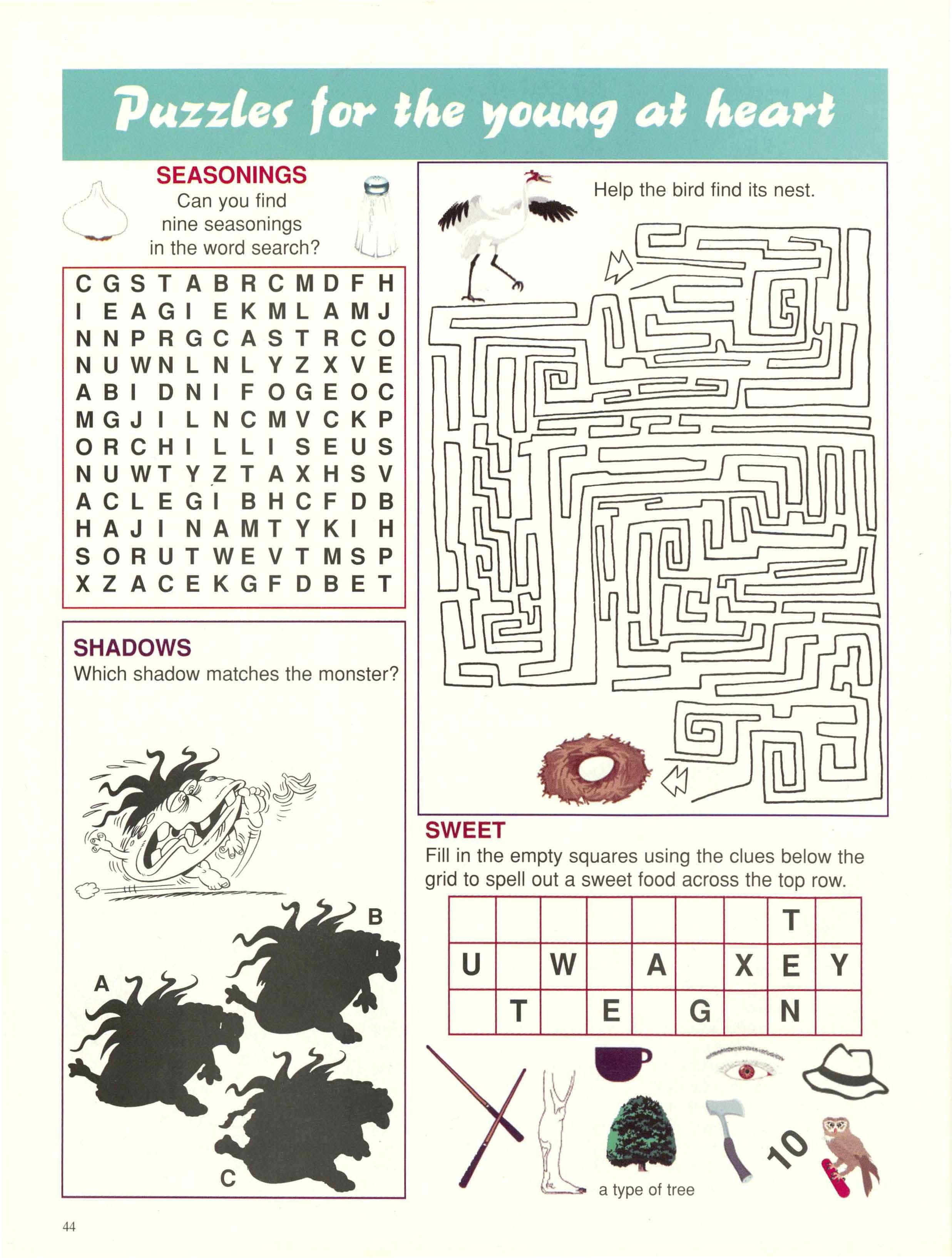
SHADOWS
Which shadow matches the monster?
Help the bird find its nest.
SWEET
Fill in the empty squares using the clues below the grid to spell out a sweet food across the top row.
u w A X E y T E G N
T-ANAGRAM
Add the letter T to each of the words below, shuffle the letters if necessary and write down the new word.
BEANS ___ LABEL ___ RAGED ____ SPACE ___ STAY DEER MAID RELISH ___ STATE TRACES ___
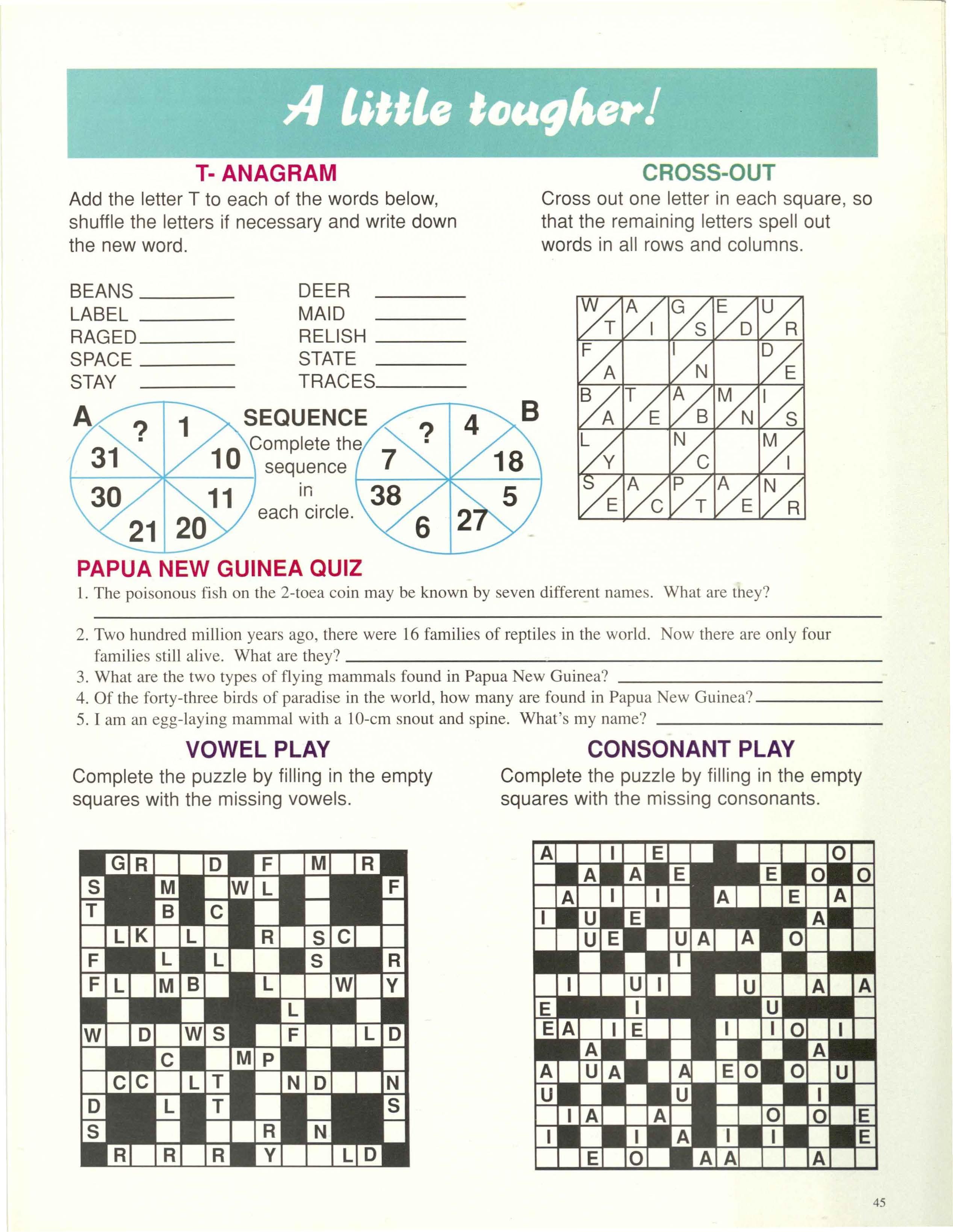
CROSS-OUT
Cross out one letter in each square, so that the remaining letters spell out words in all rows and columns. omplete the
in each circle.
PAPUA NEW GUINEA QUIZ
1. The poisonous fish on the 2-toea coin may be known by seven different names. What are tney?
2. Two hundred million years ago, there were 16 families of reptiles in the world. Now there are only four families still alive. What are they? ______________________
3. What are the two types of flying mammals found in Papua New Guinea? ___________
4. Of the forty-three birds of paradise in the world, how many are found in Papua New Guinea? _____
5. I am an egg-laying mammal with a 10-cm snout and spine. What's my name? __________
VOWEL PLAY
Complete the puzzle by filling in the empty squares with the missing vowels.
CONSONANT PLAY
Complete the puzzle by filling in the empty squares with the missing consonants.
Nestled in the secluded Wahgi valley of Papua New Guinea are the W.R. Carpenter Estates that produce Sigri Coffee, Nat i onal No.1 Tea, Teapot Tea and Mt. Angali m Tea.
This pri s tine valley, discovered barel y 60 years ago , has the world 's most ideal conditions for growing tea and coffee . And perfect conditions mean little else need be d o ne to create the perfect harvest.
In fact, the only thing to touch the tender leaves and berries is the pure Highland mist.
While the rest of the world "returns " to organic farming, in Papua New Guinea, it has only ever been that way
Taste the purity of Sigri Coffee , National No.1 Tea, Teapot Tea and Mt. Angalim Tea, where the only added ingredient is time.
'Ifie purest taste

AUDIO ENTERTAINMENT
CLASSICAL
Channel: 5
Symphony o 3 in E flat
Major Op SS 'Ero ica'Scherzo, Allegro vivace - Trio (Beethoven)
Orchestra of St Luke's
Conductor: Michael Tilson Thomas SONY/SO Y
Violin Concerto Op 47 in D Minor (Sibelius)
Maxim Vengerov: viol in Ch i cago Symphony Orchestra
Conductor: Daniel Barenboim TELDEC/WAR ER
The Marriage of Figaro: ' Porgi, amor' (Mozart)
Kiri Te Kanawa: soprano Lond on Philham1onic Orchestra
Conductor: Sir Georg Solti DECCA/POLYGRAM
Prelude No S in D (Villa-Lobos)
Julian Bream: guitar BMG/BMG
Judas Maccabaeus: See, the Conqu'ring Hero Come (Hande l )
Royal Philharmonic Orchestra
Conductor: Charles Groves SONY/SO Y
Roses from the South Op 388 (Johann Strauss)
Vienna State Opera Orchestra
Conductor: Juliu s Rudel MCA/U IVERSAL

POP
, Channel: 6
All By Myself
Celine Dion EPIC/SONY
Sad Caper
Hooti e and the Blowfish ATLANTIC/WARNER
I Finally Found Someone
Barbra Streisand & Bryan Adams COLUMBIA/SON Y
Fly Like An Eagle Seal ATLANTIC/WARNER
Never Miss The Water
Chaka Khan featuring Me'Shell degeocello REPRISE/WARNER
I Shot The Sheriff
Warren G DEF JAM/POLYGRAM
2 Become 1
Spice Girls VIRGI /V IRGIN
Step By Step
Whitney Hou ston ARISTA/BMG
Last Night Az Yet DEF JAM/POLYGRAM
Say What You Want
Texas MERCURY /POLYGRAM
Love Rollercoaster Red Hot Chili Peppers
GEFFE /U IVERSAL
Everyday Is A Winding Road
Sheryl Crow A & M/POLYGRAM
Twisted
Keith Sweat ELEKTRA/WARNER
Young Hearts Run Free
Kim Mazelle
CAP ITOL/EM I
Everytime I Close My Eyes
Babyface EP I C/SO Y
EASY LISTENING
Channel: 7
We've Got Tonite
Barry Manilow ARISTA/BMG
Alfie
Dionne Warwick MUSIC CLUB /LARR IKIN
Georgia On My Mind (Live) Ra y Charles PABLO/FESTIVAL
If Sissel PHILLPS/POLYGRAM
Your Song
Al Jarreau WB/WAR ER
The Look Of Love
Anita Baker ELEKTRA/WARNER
Your Secret Love
Luther Vandross EPIC/SO Y
Wind Beneath My Wings
Bette Midler ATLANTIC/WARNER
Moonlight In Vermont
Tony Bennett COLUMBIA/SO Y
COMEDY
Channel: 9
The Driving Lesson
The Bickersons EPIC/POLYGRAM
Take My Wife, Please!
Henny Youngman K-TEL/CASTLE
Stupid Things
Ellen DeGeneres ATLANTIC/WARNER
The Latest Devices Get Smart RAVEN/EM!
Uvula
Saturday Night Live ARISTA/BMG
The Ukulele
Phil Hanis & AJice Faye DELTA M SIC/INDEPENDENT
The Appomattox Courthouse
Bar& Grill
Stan Freberg , David Ogden Stiers & Lorenzo Music RHJNO/WARNER
Man On The Street (Personal Problems)
Steve Allen VARESE SARABANDE/ POLYGRAM
Underpants
Phil Haldeman LARRJKI /FESTrYAL
Royalty
Mary, Mary Rebecka Tornqvist EMI/EMJ
To Love Somebody
Michael Bolton COLUMBIA/SONY
He Was Too Good To Me
Natalie Cole ELEKTRA/WARNER
All In Love Is Fair
Stevie Wonder MOTOWN/POLYGRAM
Sunshine On My Shoulders
John Denver
BMG/BMG
Jasper Carron EMI/EMJ
Football Summary/Children's Program/Wrestling Matches/ Weather Girl
The Best Of Radio & Televi ion Bloopers MCA/UNlVERSAL
Argued With My Pants
Shelley Berman K-TEL/CASTLE
AJ' Yetta
Allan Sherman RHINO/WARNER
Channel: 10
She's Taken A Shine
J o hn Berry
CAP ITOUEM I
Do The Right Thing
G eo rge Strait MCA/UNIV ERSAL
She Drew A Broken Heart
Patty Love less EP IC/SONY
The Dreamer
Mark O ' Sh ea
ABC/EMI
Maybe He ' ll Notice Her Now
Mindy McCready fe a turin g Ri c hi e McDonald
BMG/BMG
Can I See You Aga in?
Mitchell Shad low EM]/EMI
Half Way Up
C lint Bla ck RCA/BMG
Small Town Dreamer Way ne Law
EMl/EMI
Ease My Troubled Mind
Ricoch et COLUMB IA/SONY
Ain't Got Nothin' On Us
John Micha e l Montgo mery ATLANTIC/WARNER
Everybody Knows Tri s ha Yearwood MCA/UNLVERSAL
Everything I Love
A lan Jackson
ARISTA/BMG
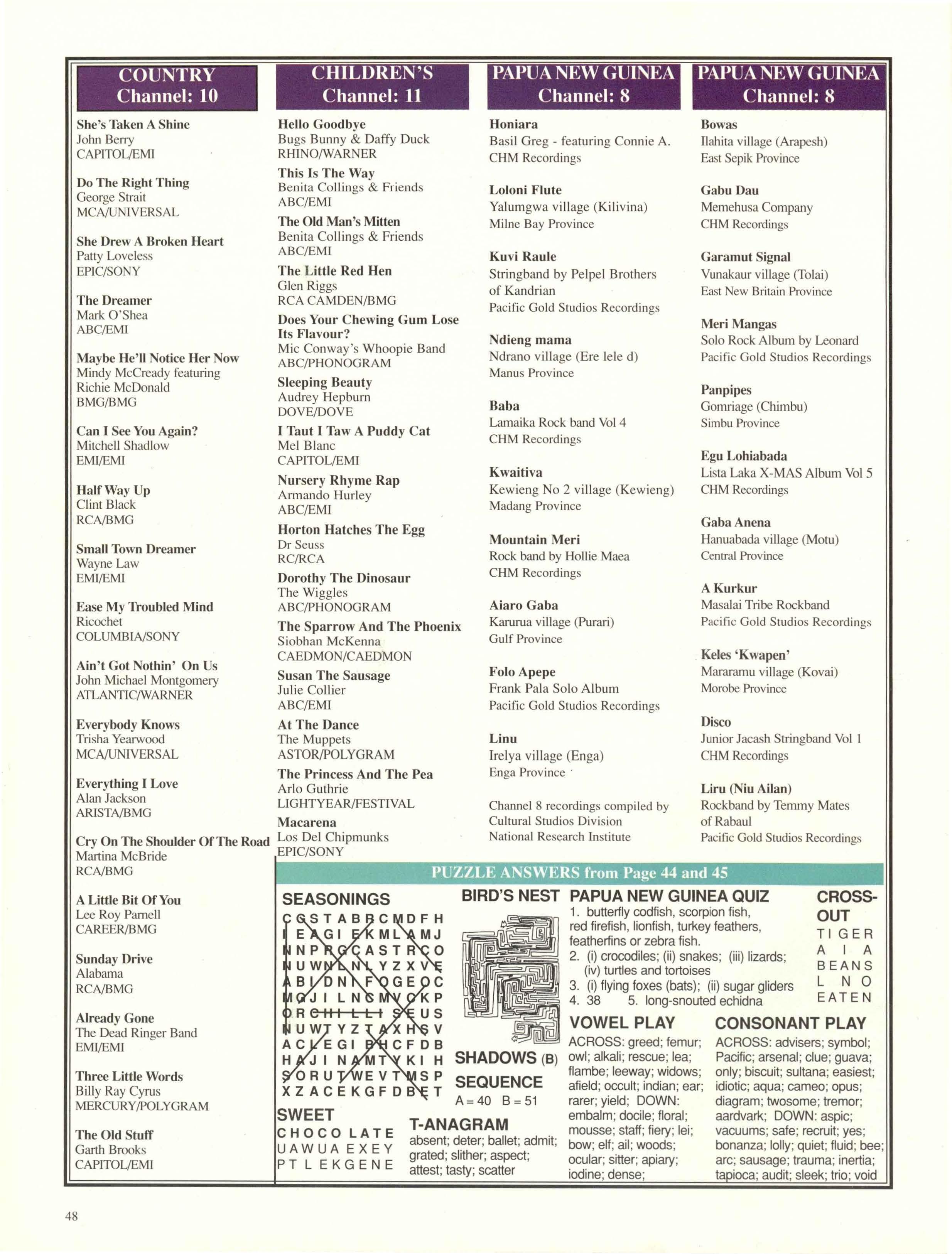
, CHILDREN'S Channel: 11
Hello Goodbye
Bugs Bunny & Daffy Du ck
RHINO/WARNER
This Is The Way
Be nit a Co llin gs & Friend s
A BC/EM I
The Old Man 's Mitten
Benit a Co llin gs & Friend s
ABC/EM I
The Little Red Hen
G le n Rigg s
RCA CAMDEN/BMG
Does Your C hewing Gum Lo se Its Flavour?
Mic Conway's Whoopie Band
ABC/P HONOGRAM
Sleeping Beauty
Audrey Hepburn DOVE/ DOVE
I Taut I Taw A Pudd y Cat
Mel Blanc
CAP ITOL/EM I
Nursery Rhyme Rap Annando Hurley
ABC/EM l
Horton Ha tche s The Egg
Dr Se uss RC/RCA
Dorothy The Dinosaur
The Wig g les
ABC/PHONOGRAM
The Sparrow And The Phoenix Siobhan McKenn a CAEDMON/CAEDMON
Susan The Sausage
Juli e Co lli er
ABC/EMI
At The Dance
Th e Muppet s ASTOR/POLYGRAM
The Princess And The Pea
Arlo Guthrie
LIGHTY EAR/FESTIVAL
Macarena
Cry On The Shoulder Of The Road Los D e l C hipmunk s Martina McBride EP IC/SONY
A Little Bit Of You
Lee Roy Parne ll CAREER/BMG
Sunday Drive AJabama
RCA/BMG
Already Gone
The Dead Rin ger Band EMl/EMJ
Three Little Words
Billy Ray Cyrus MERCURY/POLY GRAM
The Old Stuff Garth Brooks
CAPITOUEMJ
PAPUA NEW GUINEA
Channel: 8
Honiara
B as il Greg - featuring Connie A.
CHM Reco rdin gs
Loloni Flute
Yalum gwa v illa ge ( Kili vi n a)
Miln e Bay Province
Kuvi Raule
Strin g ba nd by P e lpel Broth e rs of Kandrian
Pacific Gold Studio s Reco rdin gs
Ndieng mama
Ndrano vi ll age (E re le le d )
Manu s Provinc e
Baba
Larnaika Rock band Vol 4 C HM Recordi ngs
Kwaitiva
K ewie ng No 2 v ill age (Kew ie n g)
Madang Provinc e
Mountain Meri
R ock band by Ho lli e Maea
CHM Reco rdin gs
Aiaro Gaba
Karuru a v ill age (Purari) Gu lf Provin ce
Folo Apepe
Frank Pala Solo Album
Pacific Go ld S tudi os Reco rdin gs
Linu
Irelya vi ll age (Enga)
En ga Provin ce •
C han ne l 8 reco rdin gs co mpil ed by C ultura l Studi os Divi s io n
PAPUA
Bow as fl ahita vi ll age (Arapes h)
East Sepik Provin ce
Gabu Dau
M e mehu sa Company CHM Recordings
Garamut Signal
Vunakaur village (Tol a i) Eas t New Brita in Provin ce
Meri Mangas
Solo Rock Album by Leonard Pacific Gold Studios Record in gs
Panpipe s Gomr iage (C himbu)
Simbu Pro vin ce
Egu Lohiabada
Li s ta Laka X-MAS Album Yol 5 CHM Reco rding s
Gaba Anena
H anuabad a village (Motu ) Central Province
A Kurkur
Masalai Tribe Rockband P acific Gold Studio s Reco rdin gs
Keles ' Kwapen' Mararamu village (Kovai) Morobe Province
Disco
Juni o r Jacash Stringband Yo! I CHM Reco rdings
Liru (N iu Ailan)
Rockband by Temmy Mates of Raba ul
A=40 8=51 T-ANAGRAM
absent ; deter ; ballet ; admit ; grated ; slither; aspect ; attest; tasty ; scatter
1. butterfly codfish, scorpion fish , OUT red firefish , lionfish , turkey feathers ,
featherfins or zebra fish. 2 (i) crocodiles ; (ii) snakes ; (iii) lizards ;
(iv) turtles and tortoises
3. (i) flying foxes (bats); (ii) sugar gliders L
4. 38 5 long -snouted echidna
VOWEL PLAY CONSONANT PLAY
ACROSS : greed ; femur ; owl ; alkali ; rescue ; lea ; flambe ; leeway ; widows ; afield; occult ; indian ; ear; rarer ; yield ; DOWN : embalm ; docile ; floral; mousse ; staff; fiery ; lei ; bow ; elf ; ail ; woods ; ocular ; sitter; apiary ; iodine ; dense ;
ACROSS: advisers ; symbol; Pacific ; arsenal ; clue ; guava; only ; biscu it ; sultana ; easiest; idiotic ; aqua; cameo; opus ; diagram ; twosome ; tremor ; aardvark ; DOWN : aspic ; vacuums; safe; recruit ; yes ; bonanza ; lolly ; quiet ; fluid ; bee; arc; sausage; trauma ; inertia; ta ioca; audit; sleek ; trio ; void
FEATUBE FILIJIS
International flights: from Port Moresby to Port Moresby
MAY
Jerry Maguire The Mirror Has Two Faces

Genre: Comedy Rated: PG-13
From : Columbia 135 minutes
Jerry Maguire is a spo11s agent who is brought to a point of crisis in his life when he decides to become, of all things, an honorable and decent man. The film follows his journey to redemption through an unlikely alliance with Dorothy Boyd, a young accountant and single mother, and his only remaining client, second-string football player Rod Tidwell .
Featuring: Tom Cruise, Kelly Preston, Cuba Gooding Jr, Renee Zelwegger
Director: Cameron Crowe
Producer: James L. Brooks
One Fine Day
Genre: Romantic Comedy
Rated: PG-13
From: Columbia 125 minutes
The Mirror Has Two Faces is about two Columbia University professors and the roundabout way they come to realise their mutual attraction. Exploring the myths and follies of modem courtship, this powerful film challenges our contemporary perceptions of beauty.
Featuring: Jeff Bridges, Barbra Streisand
Director: Barbra Streisand
Producer: Barbra Streisand, Amon Milchan
JUNE
Portrait Of A Lady
Genre: Romantic Comedy
Rated: PG
From: Fox 108 minutes
The lives of two working divorced parents collide on the most important day of their respective careers. The last thing they need is to get involved with each other's lives, jobs and kids. The last thing they expect is to feel an attraction. But the next thing they know, they're falling in love.
Featuring: Michelle Pfeiffer, George Clooney
Director: Michael Hoffman
Producer: Linda Obst, Michelle Pfeiffer, Kate Guinzburg
Air Niugini
From: E-source 144 minutes
A young woman's search for love and power leads her from defiance to manipulation and a loveless marriage But the force of love proves that even the most disastrous of mistakes can be the source of redemption. Based on the novel by Henry James.
Featuring: Nicole Kidman, John Malkovich, Barbara Hershey
Director: Jane Campion
Producer: Monty Montgomery, Steve Golin
Channels 1 and 2
Located in Port Motesby, the capital of Papua New Guinea, we are the largest Century 21 office in Australasia .
All our staff are certificated Century 21 Plus System graduates and collectively have just over 200 years property and sales experience.
1995 saw Century 21 International present 20 Sales Achievement Awards to our staff.
We welcome all enquiries for property investment sales and leasing.
Call uson (675) 32:1 2121 or drop into our office opposite the Port Moresby Travelodge. Siule House - Hunter Street
Jes
Genre: Drama Rated: PG-13
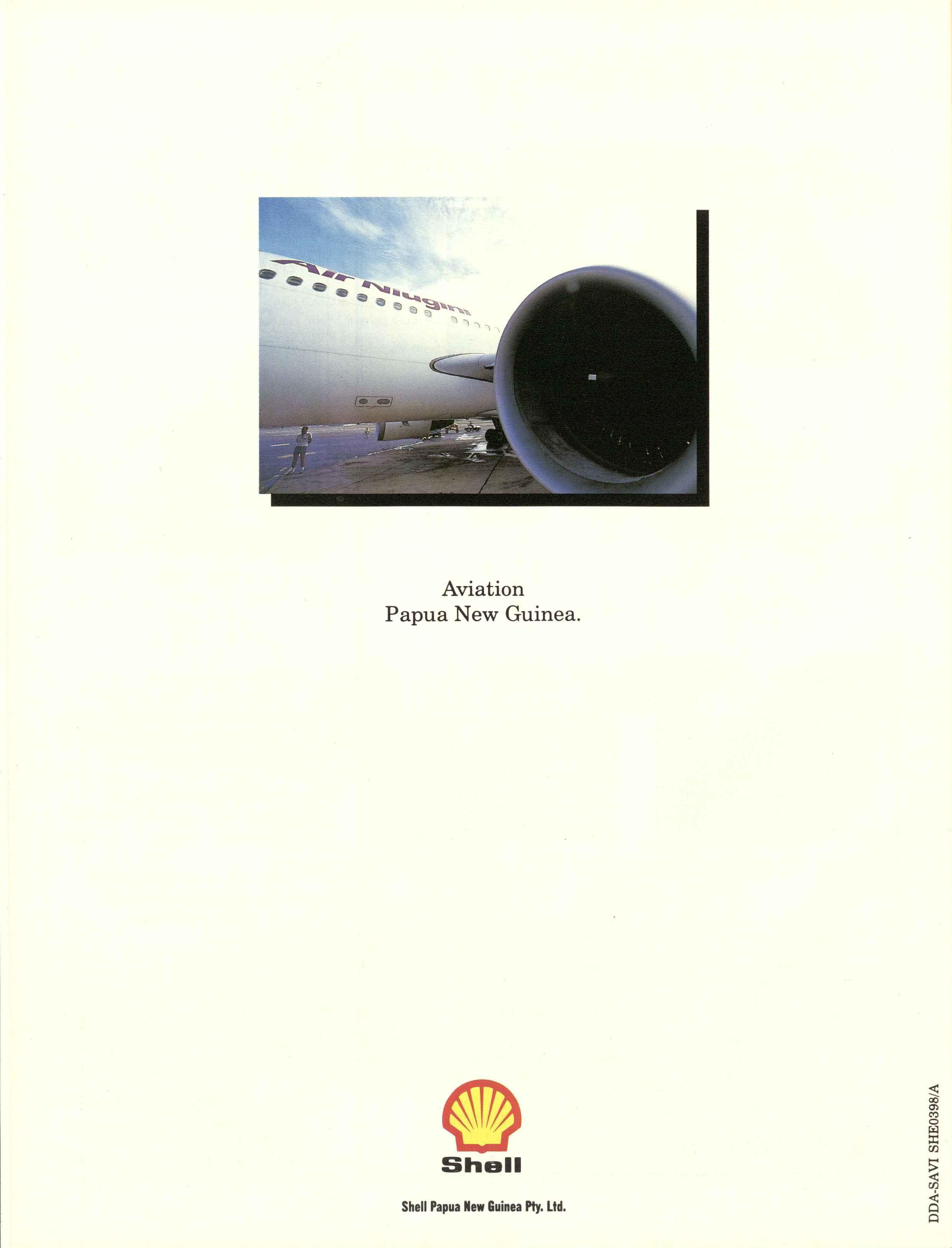
Aviation Papua New Guinea.
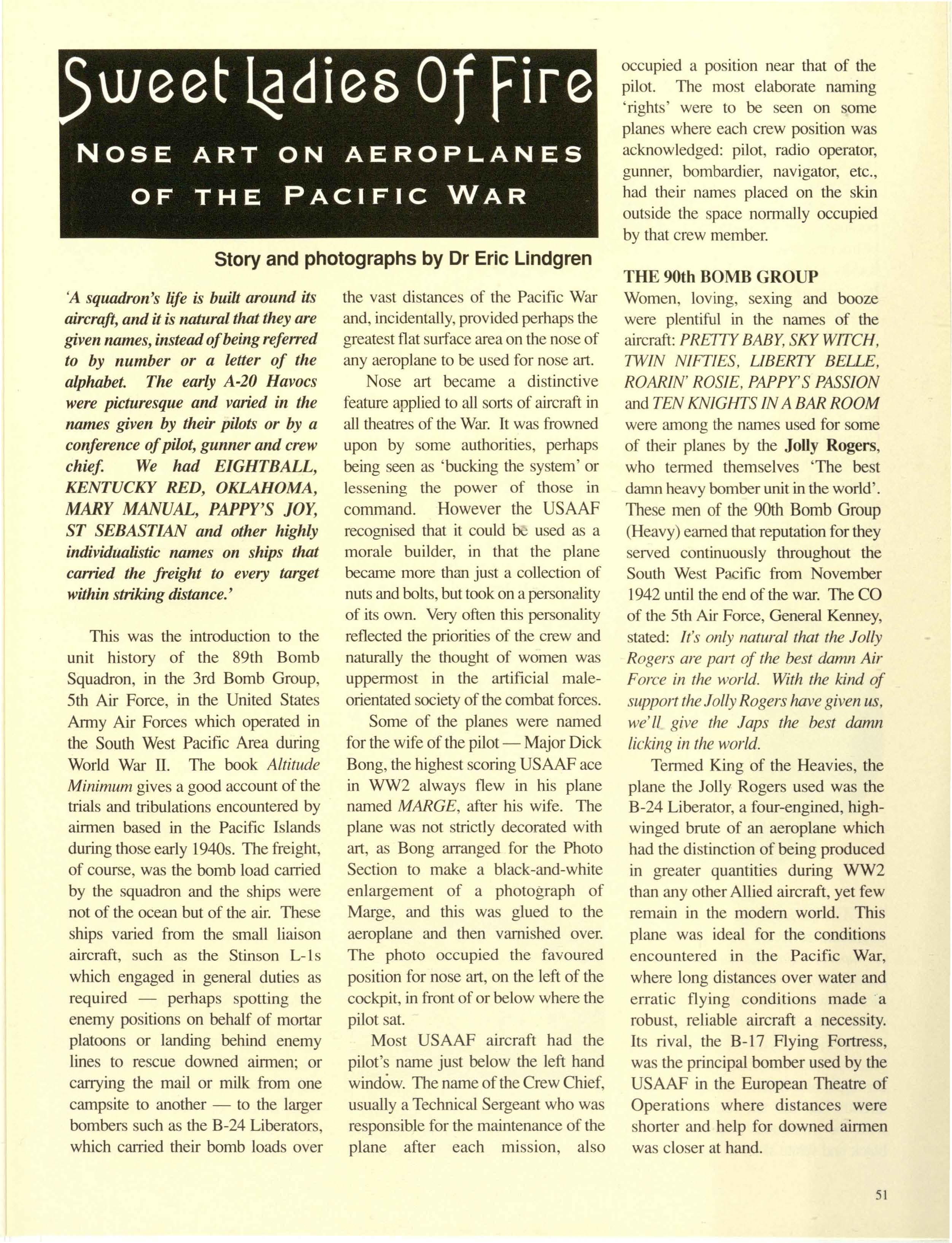
Story and
photographs by Dr Eric Lindgren
'A squadron's life is built around its aircraft, and it is natural that they are given names, instead of being referred to by number or a letter of the alphabet. The early A-20 Havocs were picturesque and varied in the names given by their pilots or by a conference of pilot, gunner and crew chief. We had EIGHTBALL, KENTUCKY RED, OKLAHOMA, MARY MANUAL, PAPPY'S JOY, ST SEBASTIAN and other highly individualistic names on ships that carried the freight to every target within striking distance.'
This was the introduction to the unit history of the 89th Bomb Squadron, in the 3rd Bomb Group, 5th Air Force, in the United States Army Air Forces which operated in the South West Pacific Area during World War II. The book Altitude Minimum gives a good account of the trials and tribulations encountered by airmen based in the Pacific Islands during those early 1940s. The freight, of course, was the bomb load carried by the squadron and the ships were not of the ocean but of the air. These ships varied from the small liaison aircraft, such as the Stinson L-1 s which engaged in general duties as required - perhaps spotting the enemy positions on behalf of mortar platoons or landing behind enemy lines to rescue downed airmen; or carrying the mail or milk from one campsite to another - to the larger bombers such as the B-24 Liberators, which carried their bomb loads over
the vast distances of the Pacific War and, incidentally, provided perhaps the greatest flat surface area on the nose of any aeroplane to be used for nose art. Nose art became a distinctive feature applied to all sorts of aircraft in all theatres of the War. It was frowned upon by some authorities , perhaps being seen as 'bucking the system' or lessening the power of those in command. However the USAAF recognised that it could used as a morale builder, in that the plane became more than just a collection of nuts and bolts, but took on a personality of its own. Very often this personality reflected the priorities of the crew and naturally the thought of women was uppermost in the artificial maleorientated society of the combat forces.
Some of the planes were named for the wife of the pilot - Major Dick Bong, the highest scoring USAAF ace in WW2 always flew in his plane named MARGE, after his wife. The plane was not strictly decorated with art, as Bong arranged for the Photo Section to make a black-and-white enlargement of a photograph of Marge, and this was glued to the aeroplane and then varnished over The photo occupied the favoured position for nose art, on the left of the cockpit, in front of or below where the pilot sat.
Most USAAF aircraft had the pilot's name just below the left hand window. The name of the Crew Chief, usually a Technical Sergeant who was responsible for the maintenance of the plane after each mission , also
occupied a position near that of the pilot. The most elaborate naming 'rights' were to be seen on some planes where each crew position was acknowledged: pilot, radio operator, gunner, bombardier, navigator, etc., had their names placed on the skin outside the space normally occupied by that crew member.
THE 90th BOMB GROUP
Women, loving, sexing and booze were plentiful in the names of the aircraft: PRFITY BABY, SKY WITCH, TWIN NIFTIES, UBERTY BELLE, ROARIN' ROSIE, PAPPY' S PASSION and TEN KNIGHTS IN A BAR ROOM were among the names used for some of their planes by the Jolly Rogers , who termed themselves 'The best damn heavy bomber unit in the world'. These men of the 90th Bomb Group (Heavy) earned that reputation for they served continuously throughout the South West Pacific from November 1942 until the end of the war. The CO of the 5th Air Force, General Kenney, stated: It's only natural that the Jolly Rogers are part of the best damn Air Force in the world. With the kind of support the Jolly Rogers have given us, we' LI give the laps the best damn licking in the world.
Termed King of the Heavies, the plane the Jolly Rogers used was the B-24 Liberator, a four-engined, highwinged brute of an aeroplane which had the distinction of being produced in greater quantities during WW2 than any other Allied aircraft, yet few remain in the modem world. This plane was ideal for the conditions encountered in the Pacific War, where long distances over water and erratic flying conditions made •a robust, reliable aircraft a necessity. Its rival , the B-17 Flying Fortress, was the principal bomber used by the USAAF in the European Theatre of Operations where distances were shorter and help for downed airmen was closer at hand.
Nose art proliferated in Europe too, with perhaps the most famous B-17 being MEMPHIS BELLE, th e first American aircraft to complete its tour of duty of 25 missions , and the subject of a recent film . However, names and art of the European planes did not rival the risque of the Pacific aircraft, possibly because the Pacific was remote from the politicians and decision makers of society and people at the front therefore had fewer inhibitions.
Like many of the planes ' names , the unit name of the 90BG(H), the Jolly Rogers , was itself a double entendre. It exemplified the happy-go lucky piratical spirit of its members , but it was also the name of the Commanding Officer, Major Arthur H Rogers, one of the original flight leaders when the Group formed in April 1942 and destined to become a man of reputation throughout the Fifth Air Force.
THE CHARACTERS
The 89th Bombardment Squadron (Light) of the 3rd BG(L) called themselves The Characters - for good reason. One of th eir members was obviously a skilled artist or cartoonist and he took the names of a series of characters from Damon Runyon stories and applied them to the aircraft in the squadron. In the distinctive cartoon style of a small body with an enlarged head he drew humorous caricatures of the group as nose art Thus: JOJO, TOBIAS THE TERRIBLE, HARRY THE HORSE , BIG NIG, PADDY THE LINK and JEW LOUIE , each with an out-ofproportion body and a face looking like that of the pilot. Photographs of the pilots standing in front of the plane show how skilled the artist was in reflecting facial features in no se art. Their aeroplanes, A-20 Havoc s, were designed as light attack bombers with two engines and usually had two crew. It is fortunate that enough bits and pieces remained in Papua New Guinea after the war to allow the RAAF to restore two machines to static display condition - one, the USAAF THE HEU ' N PEUCAN II, to go on show in Port Moresby and the second, RAAF's JESSICA, to to the RAAF Historical Collection at Point Cook, Victoria.
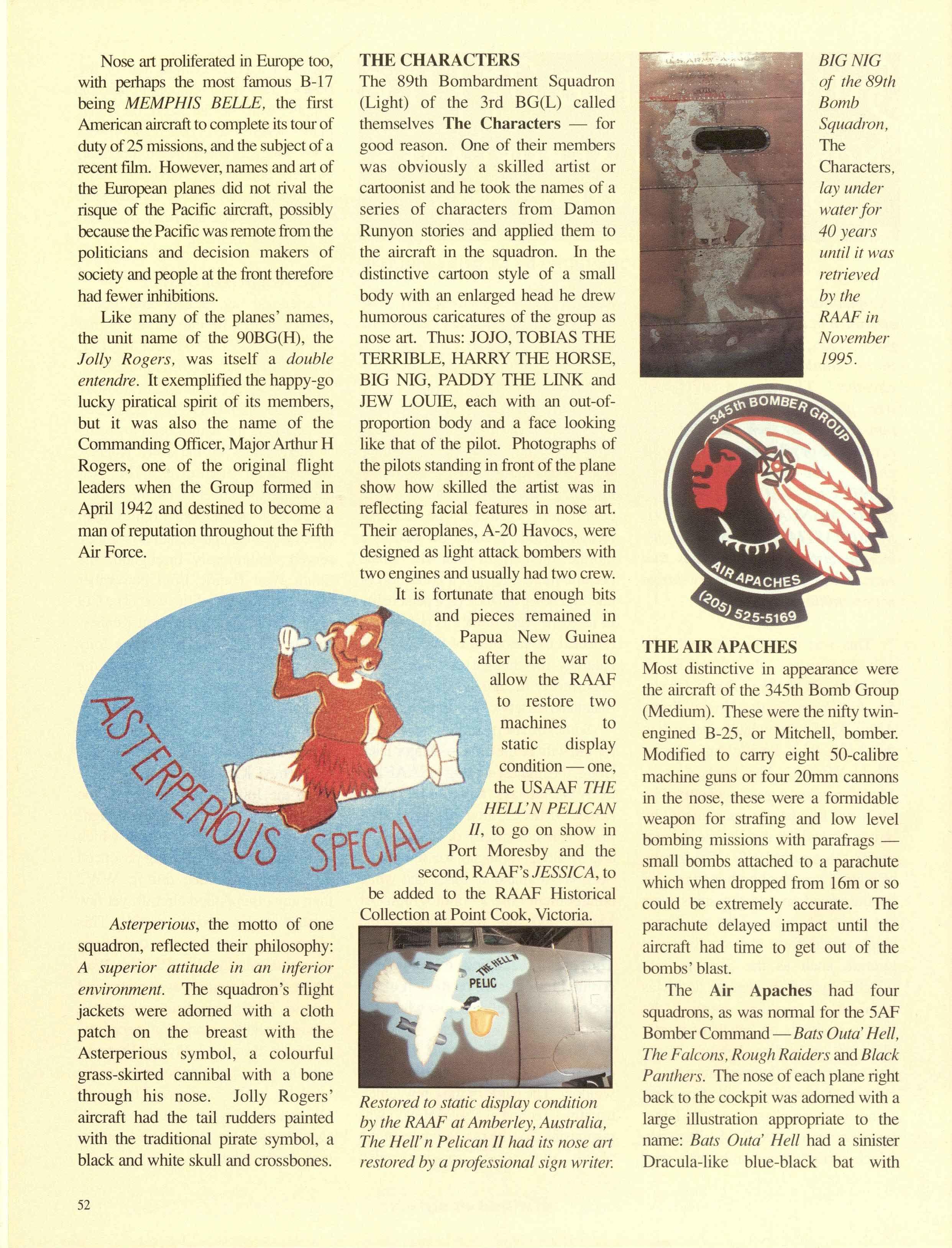
Aste,perious , the motto of one squadron, reflected their philosophy: A superior attitude in an inferior environment. The squadron's flight jackets were adorned with a cloth patch on the breast with the Asterperious symbol, a colourful grass-skirted cannibal with a bone through his nose. Jolly Roger s' aircraft had the tail rudders painted with the traditional pirate symbol, a black and white skull and crossbones.
R estored to static display condition by the RAAF at Amberley, Australia, The Hell' n Pelican II had its nose art restored by a profess ional sign write,~
BIGNIG of the 89th Bomb Squadron , The Characters , lay under water for 40 yea rs until it was retrieved by the RAAFin November 1995.
THE AIR APACHES
Most distinctive in appearance were the aircraft of the 345th Bomb Group (Medium). These were the nifty twinengined B-25 , or Mitchell, bomber. Modified to carry eight SO-calibre machine guns or four 20mm cannons in the nose, these were a formidable weapon for strafing and low level bombing missions with parafragssmall bombs attached to a parachute which when dropped from 16m or so could be extremely accurate. The parachute delayed impact until the aircraft had time to get out of the bombs' blast.
The Air Apaches had four squadrons, as was normal for the SAF Bomber Command-Bats Outa' Hell, The Fa/cons, Rough Raiders and Black Panth ers. The nose of each plane right back to the cockpit was adorned with a large ilJustration appropriate to the name: Bats Outa' Hell had a sinister Dracula-like blue-black bat with
Left: The spectacular nose of the Bats Outa' Hell, 499 Bomb Squadron, 345 BG(M), must have been an awe inspiring sight for its foes. Right: GREMLIN'S HOLIDAY, a B-25 Mitchell of the 498BS, 345th Bomb Group , sports the Falcon noseart restricted to this squadron.
piercing black eyeballs and a threatening red mouth; Rough Raiders planes carried a grey and white mustang on the nose and on the tail, while the Falcons had a fierce green bird's head with a red rimmed yellow falcon bill. The Black Panthers, just to be different, had nose art on some but not on other planes. The strong symbolism of these portraits was no doubt chosen to intimidate the enemy and also to provide a link between the crews to enhance morale. In addition to the strong front end art most planes of the 345BG(M) received a name: Gremlin's Holiday and Betty's Dream are examples.
THEIR FATE
At the end of World War Two the first thought of the authorities was one of relief. But with mountains of war materiel to dispose of and a post-war economy to consider, it was thought necessary to destroy as much as possible of the substance of war and get on with the peace. It literally became a 'beating of swords into ploughs', except that the concept was now updated to become a melting of planes, guns and everything else, to be turned into ingots and used in the production of the things of peace.
In Port Moresby, to the north-west of Jackson Strip, a production line
progressively broke down and melted these planes which had been the life of the men of war. In Popondetta, and in countless other locations around Papua New Guinea and the Pacific, the same ritual went on. Little thought was given to the historical significance of the period and to the preservation of these planes which had meant so much to the people who flew in them. In the South West Pacific area hardly any of the colourful nose art survives.
In the Kokopo Museum in East New Britain can be seen Naughty but Nice which crashed in the mountains behind Rabaul and was retrieved comparatively recently.
In the collection of the National Museum, at the War Museum, is the tail rudder from a Jolly Rogers Liberator, probably the only original skull and crossbones art in the world today. This was returned to Port Moresby in the early 1980s by helicopter from its crash site on Mount Thumb at the insistence of Bruce Hoy, then Curator of the Aviation, Maritime and War Branch of the Museum. At this time the Central Identification Laboratory of the US Defence Force actively gathered and started the identification process of the remains of the crew of aircraft 42-41081 which had disappeared in March 1942.

This is not the Naughty but Nice in the Kokopo Museum but another A-20 Havoc belonging to the 89th Bomb Squadron of the 3rd Bomb Group.
In a more modest way, during the 1970s when my children and I were systematically searching the SAF campsites around Port Moresby, we made a memorable find near Durand Drome, a small round cover from some part of a USAAF aircraft upon which was painted an unofficial insignia showing a skull wearing a pilot's helmet superimposed on a bomb over a blue cloud in a white sky. The thrill of turning over a nondescript piece of aluminium and finding thjs treasure can be imagined.
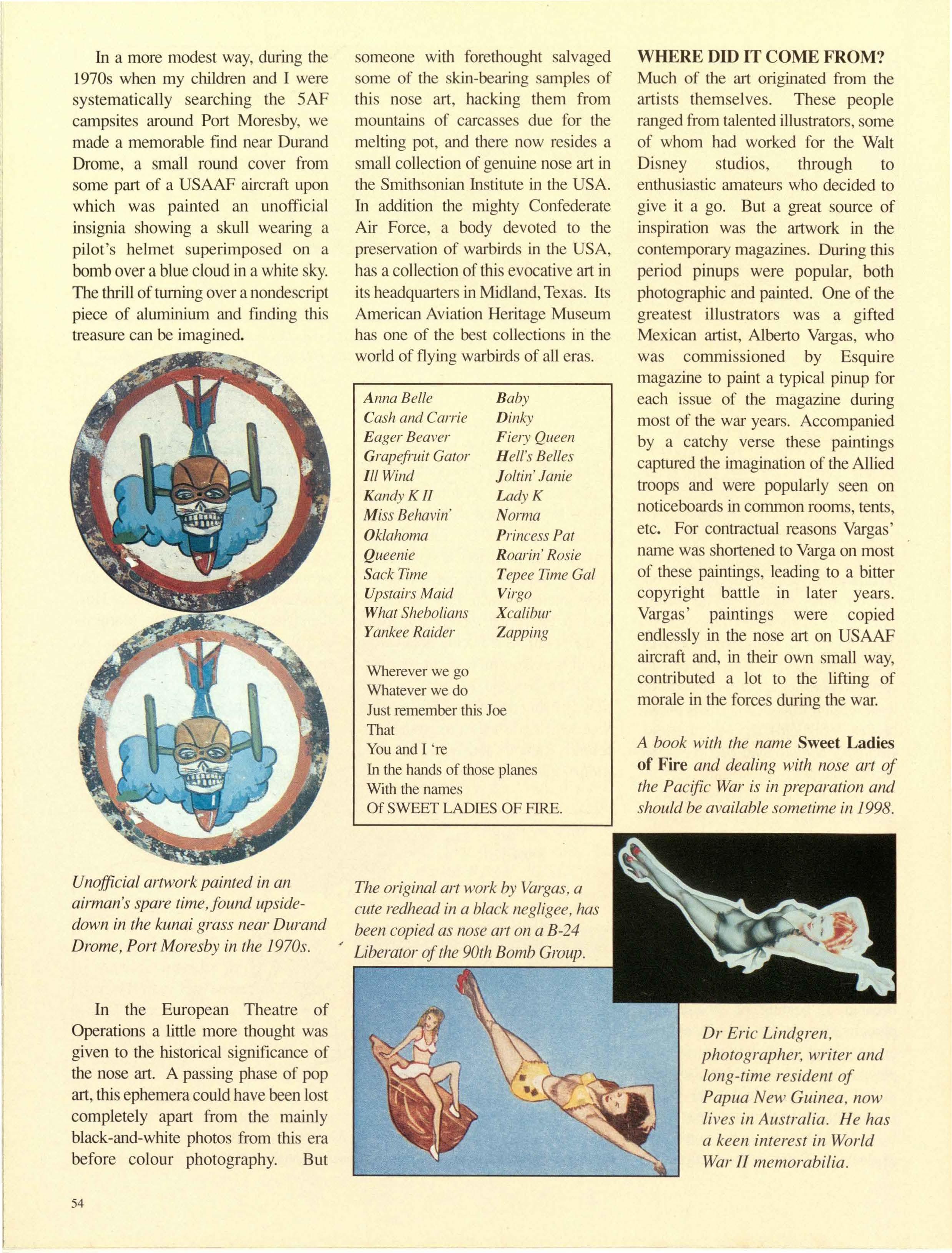
Unofficial artwork painted in an airman's spare time.found upsidedown in the kunai grass near Durand Drome, Port Moresby in the 1970s.
In the European Theatre of Operations a little more thought was given to the historical significance of the nose art. A passing phase of pop art, this ephemera could have been lost completely apart from the mainly black-and-white photos from trus era before colour photography. But
someone with forethought salvaged some of the skin-bearing samples of this nose art, hackjng them from mountains of carcasses due for the melting pot, and there now resides a small collection of genuine nose art in the Smithsonian Institute in the USA. In addition the mighty Confederate Air Force, a body devoted to the preservation of warbirds in the USA, has a collection of this evocative art in its headquaiters in Midland, Texas. Its American Aviation Heritage Museum has one of the best collections in the world of flying warbirds of all eras .
Anna Belle Cash and Carrie
Eager Bea ve r
Grap efruit Gator
Ill Wind
Kandy K 11
Miss Behavin ' Oklahoma Que enie
Sack Tim e
Upstairs Maid
What Shebolians Yankee Raider
Wherever we go Whatever we do
Baby Dinky
Pi et y Queen H ell 's Belles
Jo/tin ' Jani e Lady K Norma
Princess Pat Roarin ' Rosie Tepe e Time Gal Virgo X calibur Zappin g
Just remember this Joe That
You and I ' re In the hands of those planes With the names Of SWEET LADIES OF FIRE.
The original art work by Vmgas, a cute redhead in a black negligee, has been copied as nose art on a B-24 Liberator of the 90th Bomb Group.
WHERE
DID
IT COME FROM?
Much of the art originated from the artists themselves. These people ranged from talented illustrators, some of whom had worked for the Walt Disney studios, through to enthusiastic amateurs who decided to give it a go. But a great source of inspiration was the artwork in the contemporary magazines. During trus period pinups were popular, both photographic and painted. One of the greatest illustrators was a gifted Mexican aitist, Alberto Vargas, who was commissioned by Esquire magazine to paint a typical pinup for each issue of the magazine during most of the war years. Accompanfod by a catchy verse these paintings captured the imagination of the Allied troops and were popularly seen on noticeboards in common rooms, tents, etc. For contractual reasons Vargas' name was shortened to Varga on most of these paintings, leading to a bitter copyright battle in later years. Vargas' pamtmgs were copied endlessly in the nose art on USAAF aircraft and, in their own small way, contributed a lot to the lifting of morale in the forces during the war.
A book with the name Sweet Ladies of Fire and dealing with nose art of the Pacific War is in preparation and should be available sometime in 1998
Dr Eric Lindgren , photographer, writer and long-time resident of Papua New Guinea , now lives in Australia. He has a keen interest in World War 11 memorabilia.

Welcome to the Air Niugini inflight shop.
The items displayed on the these two pages are available on all international flights. We are happy to accept most major currencies, travellers' cheques and leading credit cards for purchases.
Ladies' Fragrances Men's Fragrances Gifts & Souvenirs
Red Door
Elizabeth Arden
Eau de toilette spray 50ml K38.00
Dune
Christian Dior
Eau de toilette spray 50ml
K52.00
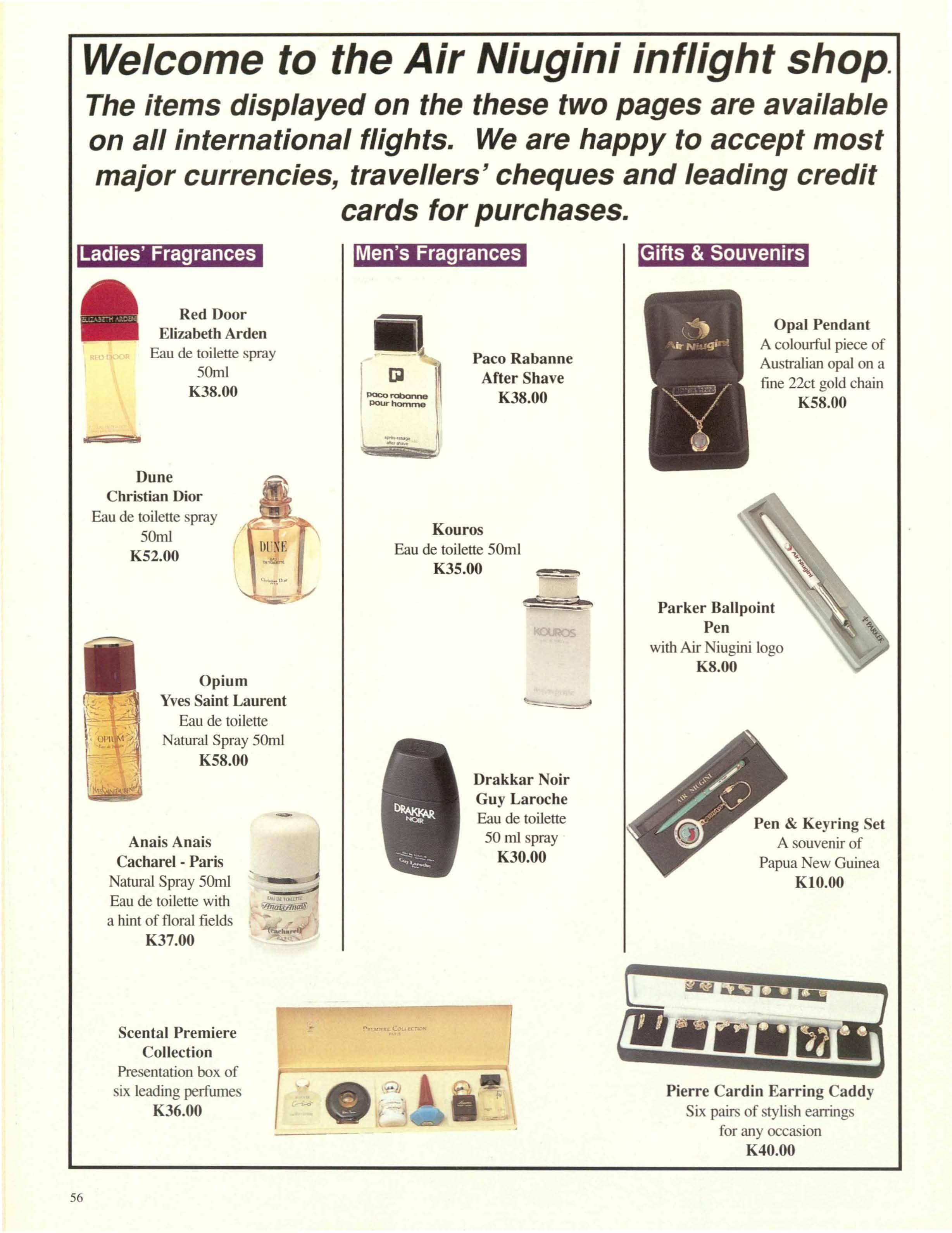
Paco Rabanne After Shave K38.00
Kouros
Eau de toilette 50ml K35.00
Pendant A co lourful piece of Australian opal on a fine 22ct go ld c hain
Parker Ballpoint Pen with Air Niugini logo K8.00
Opium
Yves Saint Laurent
Eau de toiJette Natural Spray 50ml K58.00
Anais Anais
Cacharel - Paris
Natural Spray 50ml
Eau de toilette with a hint of floral fields
K37.00
Scental Premiere Collection
Presen tation box of ix leading perfumes K36.00
Drakkar Noir
Guy Laroche
Eau de toilette 50 ml s pray K30.00
& Keyring Set A souvenir of P
Guinea Kl0.00
Six pairs of stylish earrings for any occasion K40.00
Opal
K58.00
Pen
Pierre Cardin Earring Caddy
Gifts, Souvenirs & Books
Goroka Coffee 250g
Air Niugini's Special Blend of l00 % Arabica Coffee from Goroka
ICoffee Roasters Pty Ltd K3.00
AlrNiuginl blend
~#.&. '
Silver Plated Teaspoons
Set of three teaspoons
A must for co lle ctors!
Kl0.00

Air Niugini A310 Airbus
Easy to assemble kit with mounting stand K12.00
Cigarettes, Cigars & Port
Cigars
Tabacalera 5-pack Cigars
Top quality hand rolled cigars made for Air Niugini. Kl0.00 per carton
Dunhill
Filter Delu xe -
Quality size filter created by blending exceptional quality tobacco.
K12.00 per carton
Benson & Hedges
When only the best will do Special Filter, Extra Mild & Ultra Mild - 20 & 25 K12.00 per carton
Winfield 25s
Popular red, mild blue & green K12.00 per carton
Discover Paradise
Specially selected highlights from the award-winning Paradise magazine KlS.00
· Port Penfolds 750mls 10-year old Port A blended tawny port with the characteristics of ageing for 10 years KlS.00
Whisky
Chivas Regal I litre
Matured in oak for 12 years by Chivas Brothers, Scotland
K37.00 Whisky
Johnny Walker Red l litre
The name behind the man behind the bar K20.00
Cognac
Martell VSOP 700ml
The choice of Louis XIV
K57.00 Gin
Gilbey 's London Dry l.125 litre
Made to the same secret family recipe for over 130 years K12.00
Vodka
Finlandw. l litre
The world's finest Vodka
The national drink of Finland
KlS.00
Rum
Bundaberg l.125 litre
Books
Papua ew Guinea souvenir books
Kl0.00 each
The great Australian Overproof Rum K20.00
DESTINATION - Malaita
Story and photographs by Michael McCoy
MAbove: Coastal villa ge, langalanga lagoon - at sunset
Below: Divingforfish in netLangalanga Lagoon

Above: Fishing with a frame netSinalagu, east Malaita Island
Below: Kit e fishing for ga,fish using a kite made from sago palm leaf and bait of spider web- Walande, Malaita Island
alaita, one of the major island s of the Solomons group, is large as South Pacific islands go190km in length and varying in width between 10km and 30km. It is a very beautiful island in many respects, with high mountains shrouded with rainforest and often veiled with swirling mists. Rivers and streams, fed by the frequent heavy rains, are co ld , clear and fast running - they flow through the fertile intem1ontane valleys and down to the sea where, along much of the leeward coast, the sweeping expanses of white sandy beaches delineate the border of forest and coral lagoon.
The majority of Malaitans now live in coastal villages. They have, for the most part, reconciled traditional values with a modem world, a world of increasing technology. Though sti ll largely involved in subsistence agriculture, they increasingly rely on cash crops and occasionally cattle fam1ing as alternatives. Malaitans use trucks and outboardpowered fibreglass canoes to take produce to market, they dress in Western clothes and listen to the latest music from Australia or America. Their villages invariably have a church and the larger communities have health clinics and schools. Yet, as in the past, men do the work of clearing the land for the food gardens that are tended and harve sted mainly by the women. Shell money is used to buy brides, settle land disputes and as compensation for infringements of customary laws.
While these rural Malaitans continue to pay lip-service to kastom by observing many of the old tambus, they no longer practise ancestor worship. A notable exception are the people of Laulasi Island in Langalanga Lagoon. They maintain a reverence for their ancestors who, they be li eve, inhabit the bodies of living sharks. The skulls of their predecessors are stored in a Custom House and, up until fairly recently, Laulasi Islanders undertook their fan1ous shark-calling ceremony, usually
for the benefit of visiting tourists who were charged a hefty fee for the show. But they've gone now- those old high priests who could call up the ancestral sharksand, to the dismay of the present generation, they died without passing on the closely g uard ed secrets of their creed.
The 'bush' people of modem Malaita still dwell in the rugged interior of the island in small, isolated hamlets of three or four houses, usually comprising one to four family groups. They practise the shifting subsistence agriculture, the hunting and gathering of their predecessors and the raising of the allimportant pigs. The people of the East Kwaio bush typify this lifestyle. Their strongho ld s are the foreboding mountains . above Sinalagu Harbour. Less than 2000 in number, they are virtually the only group of true pagan people remaining in the Solomons. They vigorously maintain their traditional way of li fe, rejecting the modem world with its politics and religions in favour of their own beliefs and the ways of their forebears.
Ancestor worship is a dominant feature of K waio society; the spirits of the ancestors are omnipresent- they directly affect the fortunes of the living and the occurrence of eve1yday events. Magic and sorcery are regular elements of Kwaio ritual and are an integral part of their religion. The K waio establi shed their own 'government' - the Kwaio fadanga. Although the tenets of the fadanga have caused some contention amongst the various clans of the Kwaio , its influence tends to prevail. Until recently, the Kwaio boycotted national elections and passed their own judgment on transgressions of traditional laws. Whereas the attitudes of many of the present leaders of the Kwaio have mellowed, the Kwaio bush still remains essentially a select enclave, a region where the intrusion of outsiders is often viewed with suspicion and mistrust and consequently few strangers have ventured into these mountains.
The artificial islands - a unique feature of Malaita - were constructed many generations ago. These islands are home to the Saltwater People. Over the centuries they laboriously built up their coral rock is lands on shallow reef flats , partly to escape the frequent raids and head hunting depredation of other mainland tribes and also to avoid the malaria carrying mosquitoes of the coastal lowlands. Langalanga and Lau Lagoons are liberally spread with these man-made islands , large and small. Langalanga is also the traditional home of the manufacture of shell money, a vitally important aspect of the Malaitan economy, past and present. Pieces of the bivalve shell, Spondylus, are ground into small disks , drilled and strung together, commonly in lengths of about two metres. Ten such strings, joined side by side, are termed a tafuliae and form the basic unit of shell money currency. The value of one tafuliae, in Western monetary terms, is around US$ 100.
The sandy expanse of Lau Lagoon stretches around the northern tip and for some distance down the north-eastern coast of Malaita. It forms a protective barrier against the heavy pounding seas of the south-east trade winds; green turtles and dugong browse the vast fields of ee lgrass in its sheltered waters. Sulufou is the largest and oldest of the artificial islands of Lau Lagoon. Construction started over five hundred years ago, it s foundations laid before Columbus reached the New World . No one would call Sulufou a tropical paradise It is crowded: thatched houses are packed closely together, narrow alleyways between them. It is noisy: the kids of Sulufou are boisterous , exuberant and when the moon is full over the lagoon they go wild. After midnight the peals of laughter and squeals of sheer pandemonium fill the air together with the music of guitars, accompanied by the distinctive sing-song cadences of Lau voices. Every Saturday morning the Lau people paddle through the mangroves to Urutao on the mainland to trade with th e bush people - fish for root crops - a tradition dating back many generations. Even during those times when frequent bloody conflicts occurred between the two people s - for they were traditional
enemies - there was always a truce for the exchange of food.
The provincial capital of Malaita is Auki, its name so mewhat of a misnomer - a victim of colonial error - for this is actually the name of a small nearby island and is correctly spelt and pronounced 'Aoke'. First instituted by the British as a district administrative centre in 1909 , today it is a sprawling little town with a resident population of some 3500 people . It lies on the western coast, at the northern end of Langalanga Lagoon. Auki has a rough charm all its own and in many way s is remini sce nt of the Pacific towns of Conrad or Maugham. For six days of the week it fairly bustles Sundays are quiet , appropriately reserved, a reflection of the piety of the populace.
Auki - six o'clock on Saturday morning - the police , with all due ceremony, raise the national flag in front of the police station. There is already a lot of activity: market trucks , packed to capacity with people and produce , roll down the dusty main street to the waterfront market. Canoes - small dugouts and larger craft with powerful outboard motors - crowd the s hore. Strolling through the market in this early morning light there is a richness to everything - colours, smells and sounds. Many of the people I meet know me They greet me with unaffected friendliness. Others , to whom I am a stranger, murmur 'a raikwa o' (whiteman) as I pass. For Malaita is off the beaten track as far as most tomists are concerned. Those who do get there are more likely to be backpackers and foreign faces tend to inspire some curiosity, particularly for the small children who shyly glance from behind their mothers ' skirts. Ever the opportunist, a man sells freshly caught fish to the crowd at the market. His customers make their selection which he cooks on a steel hot plate over a wood fire and he is obviously delighted when I photograph his thriving little enterprise.
Air Niugini flies to H oniara in the Solomon Islands twice a week .
Women chippin g shells in rough disks for

Michael McCoy is a travel writer who has been visit in g Malaitafor more than 20 years.
Langalanga Lagoon
traditional she ll money
Above: Girl wearing traditional decorations of shell money and dolphin teeth headband from Sulufou Island , Lau La goon
Below : Rainfo rest stream , centra l Malaita mountains
Story by Roslyn Morauta Photographs by Mekere Morauta
• ... take home the taste of paradise
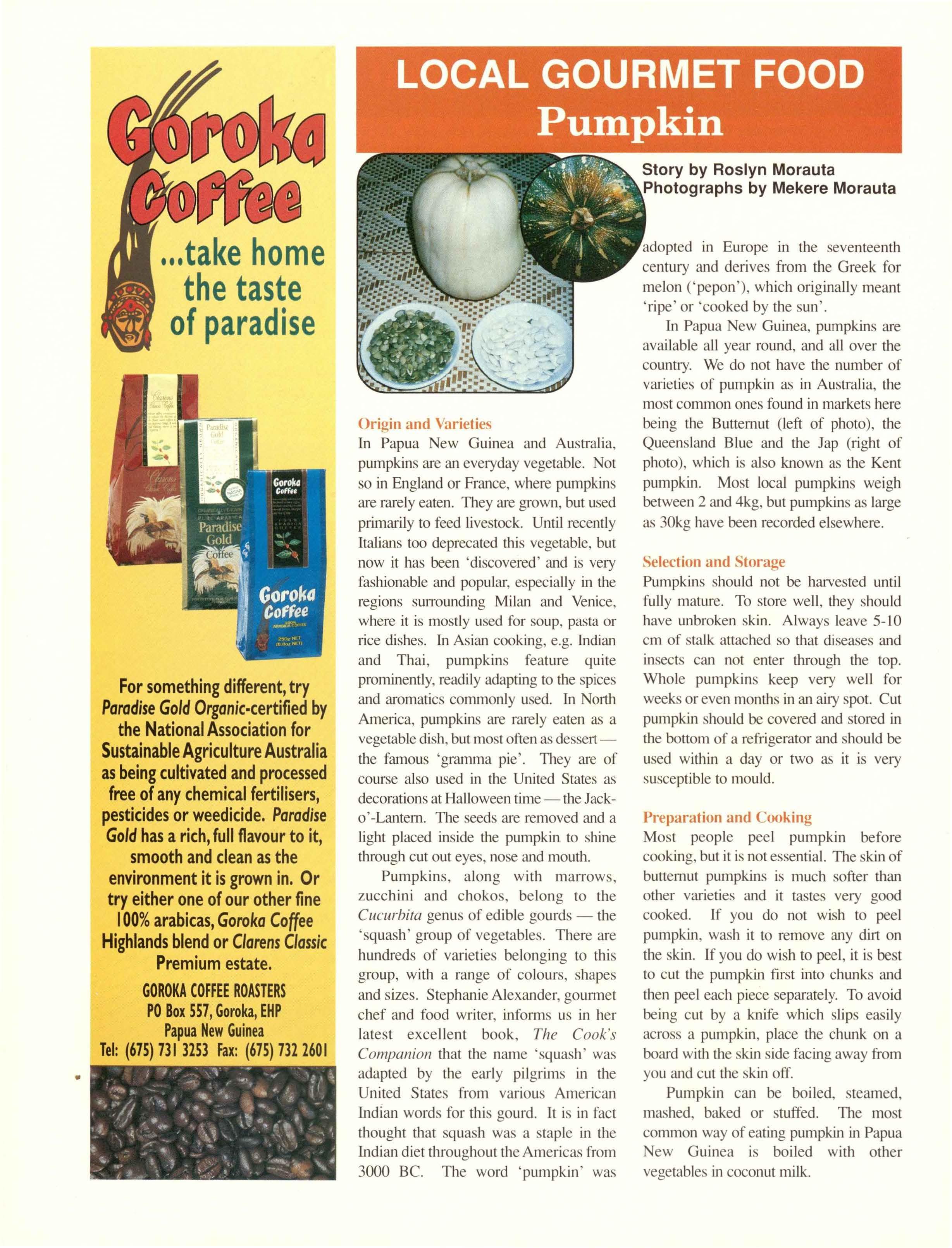
For something different, try Paradise Gold Organic-certified by the National Association for Sustainable Agriculture Australia as being cultivated and processed free of any chemical fertilisers, pesticides or weedicide. Paradise Gold has a rich, full flavour to it, smooth and clean as the environment it is grown in. Or try either one of our other fine I00% arabicas, Goroka Coffee Highlands blend or Clarens Classic Premium estate.
GOROKA COFFEE ROASTERS
PO Box 557, Goroka, EHP
Papua New Guinea
Tel: (675) 731 3253 Fax: (675) 732 260 I
Origin and Varieties
ln Papua New Guinea and Australia , pumpkins are an everyday vegetab le. Not so in England or France, where pumpkins are rarely eaten They are grown , but used primarily to feed livestock. Until recently Italians too deprecated this vegetable, but now it has been 'discovered' and is very fas h ionab le and popular, especially in the reg ions su1Tounding Mi lan and Venice, where it is mostly used for soup, pasta or rice dis hes. In Asian cooking , e.g Indian and Thai , pumpkins feature quite prominent ly, readily adapting to the spices and aromatics commonly used . In North America , pumpkins are rarely eaten as a vegetable dish, but most often as dessertthe famo us 'gran1ma pie ' . They are of course a lso used in the United States as decorations at Ha ll oween time - the Jacko' -Lantern The seeds are removed and a light placed inside the pumpkin to shine through cut out eyes, nose and mouth.
Pumpkins, along with marrows, zucchini and chokos , belong to the Cucurbita genus of edible gourds - the ' squash' group of vegetables There are hundreds of varieties belonging to this gro up, with a range of co lours , shapes and sizes. Stephanie Alexander, gourmet chef and food writer, informs us in her latest excellent book, The Cook 's Companion that the name 'squash ' was adapted by the early pilgrims in the United States from various American Indian words for this gourd. It is in fact thought that squash was a staple in the Indian diet throughout the Americas from 3000 BC. The word 'pumpkin ' was
adopted in Europe in the seventeenth century and derives from the Greek for me lon ('pepon ' ) , which originally meant ' ripe' or ' cooked by the sun '. ln Papua New Guinea , pumpkins are avai lab le all year round , and all over the country. We do not have the number of varieties of pumpkin as in Australia, the most common ones found in markets here being the Buttem ut (left of photo) , the Queensland Blue and the Jap (right of photo) , which is also known as the Kent pumpkin. Most local pumpkins weig h between 2 and 4kg , but pumpkins as large as 30kg have been recorded elsewhere.
Selection and Storage
Pumpkins shou ld not be harvested until fu ll y mature To store well, they shou ld have unbroken skin. Always leave 5- 10 cm of stalk attached so that diseases and insects can not enter through the top. Whole pumpkins keep very well for weeks or even months in an airy spot. Cut pumpkin should be covered and stored in the bottom of a refrigerator and should be used within a day or two as it 1s ve1y susceptible to mould.
Preparation and Cooking
Most people peel pumpkin before cooking , but it is not essential. The skin of buttemut pumpkins is much softer than other varieties and it tastes ve1y good cooked. If you do not wish to peel pumpkin , wash it to remove any dirt on the skin. If you do wish to pee l, it is best to cut the pumpkin first into chunks and then peel each piece separately. To avoid being cut by a knife which slips easi ly across a pumpkin, place the chunk on a board with the skin side facing away from you and cut the skin off.
Pumpkin can be boiled , steamed , mashed , baked or stuffed. The most common way of eating pumpkin in Papua New Guinea is boiled with other vegetables in coconut milk.
The seeds of pumpkin are highly nutritious. They make an ideal snack. In Italy the toasted seeds are eaten as passatempi, 'to pass the time'. They can be bought in the s upermarket: green ones are called 'pep itas' and the salted variety are usual ly white. You can however make your own very easily, as the recipe be low show s. Just remember not to throw out th e seeds next time you prepare a pumpkin for cookin g.
Roasted
Pumpkin Seeds
Wash the seeds of a pumpkin and scrape off any fibre. Place the seeds on an oven tray and dry overnight in the oven on the very lowest setting. In the morning roast the seeds at 200'C for 15 minutes until they are a deep go lden colour. Scatter over a pinch of salt (sea sa lt is best) and 1 teaspoon gro und cumin. (Toast the cumin seeds li ghtl y before grinding.)
Soup
Pumpkin makes excellent soup. I have included recipes from a number of countr ies to show you quite different ways to make so up from pumpkin.
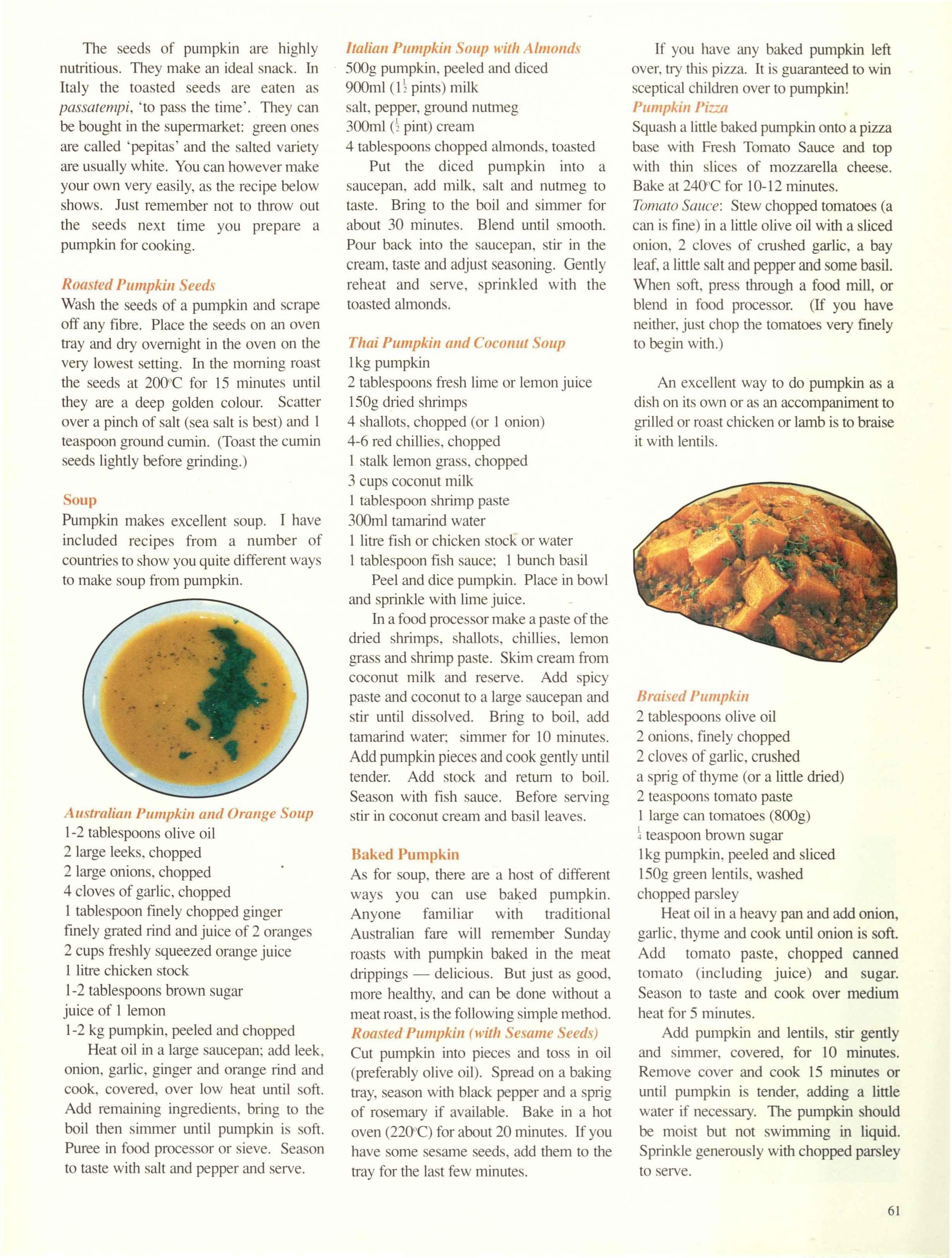
Australia11 Pumpki11 and Orange Soup
1-2 tablespoons olive oil
2 large leeks,c hopped
2 large onions, chopped
4 cloves of garlic, chopped
I tablespoon fine ly chopped ginger finely grated rind and juice of 2 oranges
2 cups freshly squeezed orange juice
I litre chicken stock
1-2 tablespoons brown sugar juice of I lemon
1-2 kg pumpkin, peeled and chopped
Heat oil in a large saucepan ; add leek, onion, garlic, ginger and orange rind and cook, covered, over low heat until soft. Add remaining ingredients. bring to the boil then simmer until pumpkin is soft. Puree in food processor or sieve. Season to taste with sa lt and pepper and se1ve.
Italian Pumpkin Soup with Almonds
500g pumpkin, peeled and diced
900ml ( 1\ pints) milk
salt , pepper, ground nutmeg
300ml ( \ pint) cream
4 tablespoons chopped almonds, toasted
Put the diced pumpkin into a sa ucepan, add milk, salt and nutmeg to taste. Bring to the boil and simmer for about 30 minutes. Blend until smooth. Pour back into the saucepan, stir in the cream, taste and adjust seasoning. Gently reheat and serve, sprinkled with the toasted almonds.
Thai Pumpkin and Coconut Soup
!kg pumpkin
2 tablespoons fresh lime or lemon juice
150g dried shrimps
4 shallots, chopped (or I onion)
4 -6 red chillies, chopped
1 stalk lemon grass, chopped
3 cups coconut milk
I tablespoon shrimp paste
300ml tamaiind water
1 litre fish or chicken stock or water
1 tablespoon fish sauce; 1 bunch basil
Peel and dice pumpkin. Place in bowl and sprinkle with lim e juice .
In a food processor make a paste of the dried shrimps, shallots, chi lli es, lemon grass and shrimp paste. Skim cream from coconut milk and reserve. Add spicy paste and coconut to a large saucepan and stir until dissolved. Bring to boil, add tamarind water; simmer for 10 minutes. Add pumpkin pieces and cook gently until tender. Add stock and return to boil. Season with fish sauce. Before serving stir in coconut creain and basil leaves.
Baked Pumpkin
As for soup, there are a host of different ways you can use baked pumpkin. Anyone familiar with traditional Australian fare will remember Sunday roasts with pumpkin baked in the meat drippings - delicious. But just as good, more healthy, and can be done without a meat roast, is the following simple method. Roasted Pumpkin (with Semme Seeds)
Cut pumpkin into pieces and toss in oil (preferably olive oil). Spread on a baking tray, season with black pepper and a sprig of rosemary if available. Bake in a hot oven (220"C) for about 20 minutes. lf you have some sesaine seeds, add them to the tray for the last few minutes.
If you have any baked pumpkin left over, try this pizza. It is guaranteed to win sceptical children over to pumpkin!
P11mpki11 Pi:.:.a
Squash a little baked pumpkin onto a pizza base with Fresh Tomato Sauce and top with thin slices of mozzarella cheese. Bake at 240"C for 10-12 minutes.
Tomato Sauce: Stew chopped tomatoes (a can is fine) in a Little olive oil with a sliced onion , 2 cloves of crushed garlic, a bay leaf, a little salt and pepper and some basil. When soft, press through a food mill, or blend in food processor. (If you have neither, just chop the tomatoes very finely to begin with )
An excellent way to do pumpkin as a dish on its own or as an accom paniment to grilled or roast chicken or lainb is to braise it with lentils.
Braised Pumpkin
2 tablespoons olive oil
2 onions, finely chopped
2 cloves of garlic, crus hed a sp1ig of thyme (or a little dried)
2 teaspoons tomato paste
I large can tomatoes (800g) teaspoon brown sugar
I kg pumpkin, peeled and sliced 150g green lentils, washed chopped parsley
Heat oil in a heavy pan and add onion, garlic , thyme and cook until onion is soft. Add tomato paste, chopped canned tomato (including juice) and s ug ar. Season to taste and cook over medium heat for 5 minutes.
Add pumpkin and lentils, stir gently and simmer, covered, for I 0 minutes. Remove cover and cook 15 minutes or until pumpkin is tender, adding a little water if necessary The pumpkin should be moist but not swimming in liquid. Sprinkle generously with chopped parsley to serve.
Italians make wonde1ful pasta dishes with pumpkin. My favourite is pumpkin dumplings - Gnocchi di Zucca.

Pumpkin Dumplings
800g pumpkin , seeds and fibre removed
I egg
200g flour
salt and pepper
75g butter, melted grated pannesan cheese
Wrap the pumpkin in foil and bake at 220"C for 1 hour
Remove flesh from the skin and mash the pumpkin weU with a fork. Add the egg, salt and pepper, and work in flour to make a firm paste.
Make dumplings by dropping the paste by the tablespoon (using another tablespoon to push it oft) into barely simmering salted water. When the dumplings rise to the top, let them cook a few minutes longer, then lift them out carefully with a slotted spoon.
Drain well and serve with melted butter, grated cheese and chopped herbs. (We used sage but chives, parsley or basil would also be good.)
Pumpkin can also be used in baking and for desserts.
Lady Flo Bjelke-Petersen was famous for her pumpkin scones, but my husband is famous with our office staff and his relatives for his pumpkin fruit cake.
1 cup mashed pumpkin
125g butter or margarine
1 cup brown sugar
2 eggs
1 tablespoon golden syrup
l pkt mixed fruit (250g)
2 cups self-raising flour or I cup white and 1 cup wholemeal (S.R. flour)
teaspoon spice (cinnamon or mixed s pice)
Beat butter and s ugar to a cream with a wooden spoon or electric mixer. Beat in eggs and golden syrup. Add pumpkin then flour, spice and fruit.
Bake in well-greased loaf or round cake tin for I hour in a moderate oven (175°C).
Serve plain or buttered.
When you are in Port Moresby and find accommodation is expensive, come and see us and we'll make it affordable for you.
Flo's Pumpkin Scones
I tablespoon butter
½cup sugar
¼teaspoon salt
1 egg , beaten
I cup mashed cold cooked pumpkin
2 cups sifted self-raising flour
Beat butter, sugar and salt (in mixer if you have one). Add egg, then pumpkin Stir in flour by hand. Pres s out and cut into rounds. Place on greased tray. Bake in hot oven (230°C) 15-20 minutes .
Mekere's Pumpkin Fruit Cake
Story and photographs by Steven Dawanincura Papua New Guinea
Tou r ism Promoti on Authority
Mjor tourism locations, superb sland retreats, beach front esorts with friendly staff, scrumptious meals and a host of activities are popular getaways around Papua ew Guinea - Loloata, Mansava, Manus Harbourside, Malagan Lodge, Jais Aben, Walindi, Madang Resort the list goes on. The imagination runs wild when the Papua New Guinea Tourism Authority is trying to describe, sell and promote the exotic spots that dot this vast country to the world market.
Behind many of these establishments are men and women who have toiled hard for their dreams and ambitions. But not everyone's dreams can be realised all the time and many promising entrepreneurs and organisations have fallen by the wayside through lack of support, bad management or a host of other unforseeen problems. However Wallace Andrew, on Samarai Island, Milne Bay Province in the eastern comer of Papua New Guinea, knows 'life wasn't meant to be easy' and has experienced his share of hardships trying to keep his dream - Kinanale Guest House.
Milne Bay is such a small place that when people notice changes they are quick to form their own professional opinions and conclusions, quipped Andrew. If times are hard for me, I feel it's all right to have the water running and lights on when guests arrive so that there is no wastage. Jn the meantime I use enough to get by. This saves incurring e.xtra costs without reason -it's only common sense. /' m not going to have lights flashing saying that my rooms are available when I know there 's not a
tourist around for a hundred miles. But we are always ready to welcome and host guests who arrive on the spur of the moment. Life here is simple and we always cater to the needs of the tourist.
A friendly smile beaming from cheek to cheek is the first thing you notice when you meet Wallace Andrew. Back in 197 5 during his days with Elcom, an accident severed four of Wallace's fingers and crushed his right hand while inspecting a huge engine at the Kimbe Power Station. Wallace underwent surgery to remove his hand at the wrist and reshape the bone structure and nerves into a current manageable condition. However, this

accident did not stop him from aiming for success and he remains a keen fisherman, operating his 7m dinghy with a canopy shelter in all types of weather while travelling to and from Alotau and the many islands in the area.
Wallace silently hopes that his three daughters who reside in Australia will return to share his tourism vision. Bella, the eldest, is a talented singer currently working in the hotel industry. Since completing her University studies, Didileia has worked in computing. Kenu, the youngest, has taken up martial arts since joining the armed forces and has a keen interest in being a chef.
Top: Come on in A warm welcome is offered to every guest at Kinanale by Wallace Andrew and his staff.
Below: Gesila Island- a picnickers ' paradise
Above: Sea transport is your choice - traditional or modern
Below: Milne Bay magic- a superb sunrise around Kwato Island
In Milne Bay Suau language Kinanale is the bright red hibiscus flower, common to the Pacific and a popular hair decoration.
Wallace Andrew, the boy from Logea who grew up on Kwato Island, decided this beautiful flower was an appropriate name for his guest house.
In early 1982 Wallace, his wife Jenny and three daughters bought the house and two blocks of land that Kinanale now occupies. When the renovations of the building were almost finished, a mining company surveying the region chose Kinanale for their employees to stay and have regular meals. So it was that Kinanale, which has the motto of providing a quality service to both visitors and locals, was opened to accept its first guests a little earlier than scheduled - its ten rooms booked out.
Kinanale has the capacity to hold conferences and seminars and has played host to World Bank leaders and European Union delegates. Guests have included Papua New Guinea's and foreign prime ministers. Wallace is very proud of the fact that during the SP Forum meeting on Samarai, historical documents were signed at Kinanale Guest House, officially giving membership to the Forum's newest member - New Caledonia.
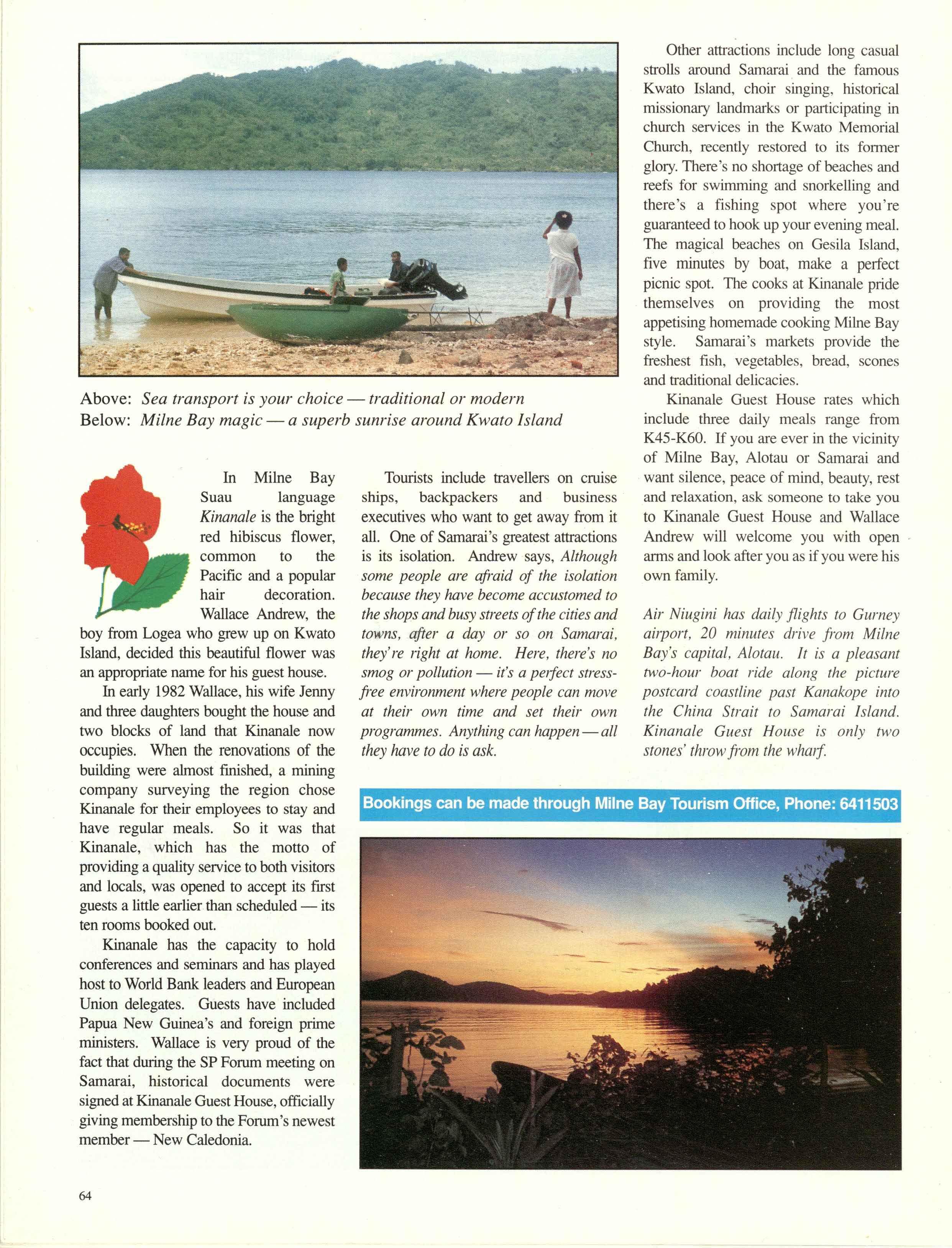
Tourists include travellers on cruise ships, backpackers and business executives who want to get away from it all. One of Samarai's greatest attractions is its isolation. Andrew says, Although some people are afraid of the isolation because they have become accustomed to the shops and busy streets of the cities and towns, after a day or so on Samarai , they're right at home. Here, there's no smog or pollution - it's a pe1fect stressfree environment where people can move at their own time and set their own programmes. Anything can happen-all they have to do is ask.
Other attractions include long casual strolls around Samarai and the famous K wato Island, choir singing , historical missionary landmarks or participating in church services in the K wato Memorial Church, recently restored to its former glory. There's no shortage of beaches and reefs for swimming and snorkelling and there ' s a fishing spot where you ' re guaranteed to hook up your evening meal. The magical beaches on Gesila Island, five minutes by boat, make a perfect picnic spot. The cooks at Kinanale pride themselves on providing the most appetising homemade cooking Milne Bay style. Samarai 's markets provide the freshest fish, vegetables , bread , scones and traditional delicacies.
Kinanale Guest House rates which include three daily meals range from K45-K60. If you are ever in the vicinity of Milne Bay, Alotau or Samarai and want silence , peace of mind , beauty, rest and relaxation , ask someone to take you to Kinanale Guest House and Wallace Andrew will welcome you with open arms and look after you as if you were his own family .
Air Niugini has dail y fli ghts to Gurn ey airport, 20 minutes dri ve fr om Miln e Bay's capital , Alotau. It is a pleasant two-hour boat ride alon g th e pi cture postcard coastlin e past Kanakope into the China Strait to Samarai Island . Kinanal e Gu est Hous e is only two stones ' throw from the whmf
S EC L RITY

PAPUA NEW GUI N E A
TOURIST INFORMA TION
As w i th all developing countries. th ere are times w h en l aw and order i ss ues are a concern.
M uch of what you have read or heard are over•exagge ratio ns of ,:v hat you will find and apply in t he main to urban areas. A lt hough you are unlikely to expe r ie nce any difficultie~. plea se use common sense. part icularly when ou t and about at nig ht. Seek local advice from you r ho tel o r t he PNG Touris m Promotion Aut hority
VtS A EASE
A 60-day 1ouris 1 visa is avai l able on ar r ival at Po n Moresby and Mount H agen airports. The Ice fo r the non -extendible visa. available only al the air gateways. is K 25. You will need valid travel ctocume nh. sufficien t funds fo r your stay and an ai rline ticket with a confirmed outbou nd !light before th e expiry date of your vba. Some rest r ictions apply to lrave l le rs from several Asian. Eastern Euro pea n and African countries. \Ve recommend that travellers check w i th the PNG Em bassy o r the nea rest Austrnlian Consular or P G representative office (which are located in the capitals of most countr ie~) or any Air Ni ugi n i Office as to 1he visa requirement s before travel l ing to Pap u a New Guinea.
STAY HE A LT H Y
Wa ter quality i~ within World H ea lth Organisation standards in mo:-.t towns. Bou \ed \Vate r is avai l able. However. in rural areas. it ·s advisable to boi l water al all time~. Malaria con ti nue~ as a health risk in some pa11s of the countl)' You shou ld start taki ng anti-malaria tab l ets two weeks before atTival. co111in ue during your stay in Papua New Gu in ea and for four weeks af ter departu re. Preve nt ion is effective and easy : use insect repellent and wear l ong-sleeved shirt~. long trousers and shoes in the even in g when mosquitoes are more active.
CR AFTY SOL' \' EN IR S
One of the many pleasant surp r ises you will find in Papua New Gui nea is th e w i de range of art forms i n dive rse styles. Among the many temp t ing souve n irs you ·II encoun1er are;
* Bilwn s - String bags made from na1ura l fibres
* Ma sk s - Woven from cane or ratta n: made of wood and clay w i1 h :-.hells. hair and pigs· lee1h or inci:-.ed w i th brow n and white patterns and finished in glossy black.
" Wood en Bowls - Fashioned from pr ized local timbe rs. i ncluding ebony. Carved walki ng sticks. stools and tables are often i n la id \\ ith mo ther-ofpearl.
" Ba sk ets and Tray s - Many different panerns and styles can be found. T hose from Bougainville are regarded as some of the fi nest in 1he Pacific.
* Drum s - T he mos t common musical inst r ument in Papua New Gu inea. Those made from a hollow tree trunk are called garamuts. whi le the smaller k1111du is shaped l ike an hour glass and has snake or lizard skin stretched over one end.
* St o r y Boards - Madl! on 1hc Keram R iver. the) illustra1e in raised relief. events and inc idc n1 s of vil l age life.
* Sp{rit B o ards -Ac t as gu ardians of the village with those from the Gu l f Prov i nce believed 10 possess !he spirits of powerful warriors.
Many anifac ts and ot her his 1or ical and cu lt ura l objects are prohibited export:-,. Other~ require an export pem1it. Con tact the 1 ational M useum for details. Expon of Bird of Paradise plumes i, prohibited. For expo rt pe rmi t s for other wildlife and animal product s contact the Nature Conservation D i vision o f the Depanme 111 of Environme nt & Conservation.
F EATHERS O F FLIER S
Ove r 700 species of fea Lhe red nie rs nutter across our isla nd inc l uding 18 of the -l-1 !-lpecies of the magnificent Bird of Paradise. There arc numerous 01her birds of distinction including the Cassowary. wh ic h s1ands 1.8 me tres high and can weigh up to 59kg and 1he Crowned Pigeon which is the si ze or a turkey. Parrots of kaleido sco pic co l ours dot our towering trees. Nor all the colo u rs of the rainbow have bee n reserved for birds: there i:-. an unlimi ted range of hue!'\ and shades 10 be seen in ou r 2000 orchid species and count less magnificent bunerllies including the worlcl"s largest. the Queen Alexandra B irdv 1 ing.
T AU; TO l/s
Engli sh Good Morning
Goo d A rrernoon \ Vhat s you r name ? My name is H ow muc h i\ this?
Thank you
THI S A ND TH AT
Motu
D ada na m ona
Handorai namona
Oi emu ladana be daika
Lau egu ladana be l nai be hida ?
Tanikiu
Pidg in Manin
Apinun
Wanem nem bilong yu?
Nern bilong me
H ama~ long em?
Tenkiu
G e /ling H ere/C ellin g A bout - Your touchdown is on the ta r mac of Jackson's Airport which is 11 km (7 miles) from t he ce111re of Port Moresby. There arc rcn 1al car counters. a bank and a duty free shop wi thin the airpon comple,. Major hotels have a courtesy bu s 10 and from the airpo r t. Tax i s have meters but are rather expen~ive. Within the city. PMYs ( public motor vehic les) cos! 50toea per journe).
C urr e n cy - Papua Ne" Guinea ·s unit or currenC) i, the Kina which is divided into I 00 toe a. T here are K S0. K 20. K I 0. K:\ and K2 note, and a K I coin. Exchange your Dollars. Sterl i ng. Yen and mos1 other international currencie, a1 Jad,son·~ Airport o r in banks which are open from 9am to .>pm. Monday to Thursday and until 5pm on Friday. And don·1 forge! your credit cards which are accepted in leading hotels and shop~.
C allin g H o m e - Modem ~ate l lite communication brings 1he world to Papua New Guinea at the touch of a few button~. Only in the remote area, i:-. a radio te l ephone service in use.
Useful P o rt M o r es by N umb er s - Tourism Promo1ion Authori t y 320 0211: Air Niugini I nfor m at ion Jackson's Airport 327 3-180: Reservations and Confi r mation 327 3555 (Dome,tic) and 327 3-144 \ i n1crna1ional): Police 000: Ambulance 325 6822.
Stamp P ac t s - T he Papua Ne,, Guinea Po\lal Service is fast and reliable. Pl us t h ere is the added bonus of beautiful and highl) prized ,ramp, 10 decorate you r le11er s and cards. Special collector and presentalion pack, avaih1ble from mos! post offices make great gif1s.
P owe r P o int er s - Papua New Guinea·s elec t ric i ty supply is 2-l0 volts AC 50 H z. Some hotel s have 11 0 volt outlets for ,haver, and hair dryers.
Dr ess Se n se - For most occasions. dre ss is i n forn1al and ca-;ual. Thong,. sneaken; and sandshoes are not allowed in 1,ome bars and restaurants. I n the Highla nds. sturdy walking shoe~ are recommended. as is a sweater or jacke1 for cool evenings.
Dinin g Out - You won·1 go hung ry i n Papua New Guinea. Western cuis i ne is avai l ab l e in hotels. restaurants. guest hou~es. lodges and village resorts. Pon More sby ha s several Asian and European re staurants. For something differenl. t ry a trad i tiona l ·mumu· of roa-;t pork. c hi cken or fish , sweet potato, taro. banana and greens.
S h o ppin g S urpri ses - From modern depanme111 complexe-. IP quaint little stores. there are plent y of place ~ to spend your money. I n anifact shops you may tr) ) our hand at barga i ning , but be gen t le! Remember 1hat Saturday is a half day for most shops and vinuall) ever) place is closed on Sunday. Th e S portin g Life - Play golf. tennis and squash or go fishing. diving. snorkelling. hunting and 1rekking. Checl-. \\ ith Air Niugini and the PNG Tourism Promotion Au thority for venue~.
Tim e Ou t - Papua New Guinea i s I 0 hours ahead of GMT and in the same time zone as Eastern Australia. Howev er. there is no daylight saving in Papua New Guinea.
Fin e F ea th ered F es tfr a ls - Whil e it's alwaY' pOS\i bl e 10 see various aspects of our r ich heritage. there are annual regional festivals of traditional culture well worth including in your i1inernr):
June
August
Port M oreshy Sholl'
Mr lla S;?en Show
September Hiri M oale F e.<1iml. Pon M oreshy
October Mah orasa Fe stfra/ in Madcmg
October M orohe Show
Topping them all is the Eaqern Highland, Show in Goroka (staged in September of even numbered years) when thousands or pai111ed and feathered tribes people sing. da nce and parade in full regalia.
Tippin g T i p s - You are a guest in Papua Kew Guinea and hospitality i~ an honour in our Melanesian culture. Tips arc neither expected nor encouraged.
Ta x in g Malt ers - While there is no service charge added 10 b i lls. a service tax of between 2.Sq and 7o/c i s levied in some provinces and the National Capital District. Save K 15 for your international air departure tax. Tax 1,tamp~ can be purchased at post offices or on departure.
C ustomary R eg ulation s - Standard custom, concessions for Irnvellers-apply 10 the following goods:
* 200 cigarettes or 50 cigar, or 250gram, of tobacco
* One litre of spirits
* A reasonable amoun1 of perfume
We value your visit bu1 please do11·1 bring drugs. obscene literature or video tapes. fireann s or weapons. Food items ,eed,. ,pices. li\'e or dry plants. animals. animal products and equipment as well as biological specimen, such as cul!Ures and blood need special documentation before the; can be imported.
For m o r e fa sc inatin g fa ct s about Papua Ne w Guin ea holidays, c onta c t y our tra ve l age nt or th e Papua Ne w Guin ea Touri s m Pr o moti o n A uth o rity.
Telephone (675 ) 320 0211 , Fac simil e (675 ) 320 0223
NEW GUINEA
TOYOTA
With a choice of Window Van or Panel Van, this exciting new vehicle is a great people and cargo mover. Functiona·1 and versatile, it combines all the benefits of passenger car comfort with the space and accessibility of a well-designed van.
Features include :
0 Diesel or Petrol engine
0 Easy access sliding door
0 Full width rear door
0 Tight turning circle
0 Large, open cargo space
0 High mounted rear lights
0 Rear door pull straps
0 3 Seater Panel Van
0 6 Seater People Mover
Contact Ela Motors for full details and test drive Liteace today.
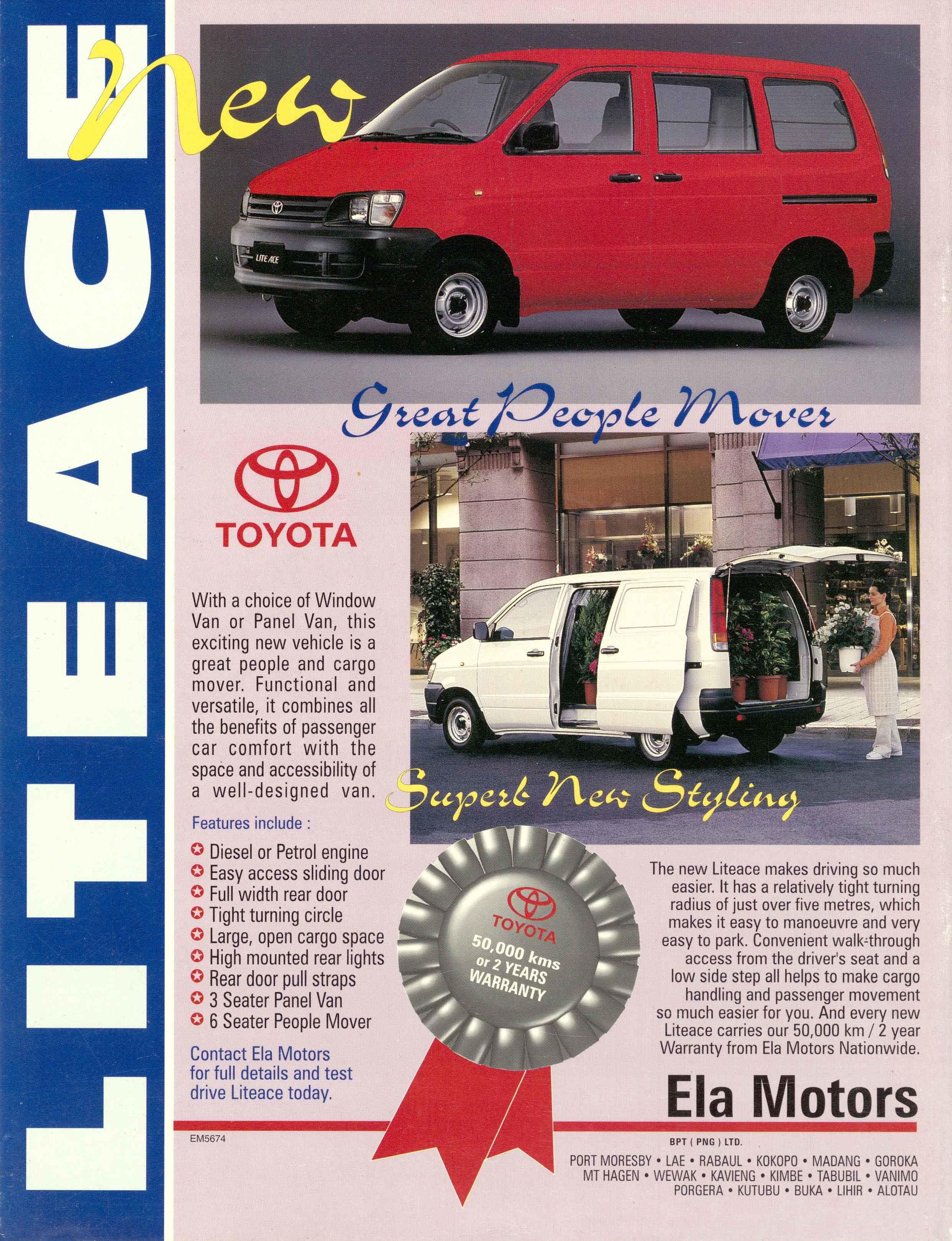
The new Liteace makes driving so much easier. It has a relatively tight turning radius of just over five metres, which makes it easy to manoeuvre and very easy to park. Convenient walk!through access from the driver's seat and a low side step all helps to make cargo handling and passenger movement so much easier for you. And every new Liteace carries our 50,000 km/ 2 year Warranty from Ela Motors Nationwide.
